Learn the basics of geometry from our Big Ideas Math Geometry Answers Chapter 1. The basics of geometry include points, lines, and planes. So, the students who are confused about the concepts can refer to our Big Ideas Math Geometry Answers Chapter 1 Basics of Geometry. Most of the students feel that geometry is the toughest chapter in all but if you understand the concept this will be the scoring chapter that helps you to secure good marks in the exams. Download Big Ideas Math Book Geometry Answers Ch 1 Basics of Geometry via quick links.
Big Ideas Math Book Geometry Answer Key Chapter 1 Basics of Geometry
Basic Geometry is the study of lines, angles, points, solids, and surfaces. Practice Questions from Big Ideas Math Geometry Answer Key Chapter 1 Basics of Geometry during your preparation aligned as per the Textbook. Big Ideas Math Geometry Chapter 1 Answer Key includes the concepts like Points, Lines, and Planes, Measuring and Constructing Segments, Midpoint and Distance Formulas, etc. Just click on the links given below and start practicing the questions. BIM Geometry Answer Key Chapter 1 Basics of Geometry also helps students and teachers to clarify their doubts.
Basics of Geometry Maintaining Mathematical Proficiency
Simplify the expression.
Question 1.
|8 – 12|
Answer:
4,
Explanation:
The given absolute value expression is : | 8 – 12|, As we know that the absolute value of a number or integer is the actual distance of the integer from zero, in a number line. Therefore, the absolute value is always a positive, | x | = x for x > 0, | -x | = x for x > 0, So | 8 – 12 |= | -4| = 4, Therefore from the above we can conclude that the value of the given absolute value expression is 4.
Question 2.
|- 6 – 5|
Answer:
11,
Explanation:
The given absolute value expression is | -6 – 5|, As we know that the absolute value of a number or integer is the actual distance of the integer from zero, in a number line. Therefore, the absolute value is always a positive, | x | = x for x > 0, | -x | = x for x > 0, So | -6 – 5| = | -11 | = 11, Hence from the above we can conclude that the value of the given absolute value expression is 11.
Question 3.
|4 + (-9)|
Answer:
5,
Explanation:
The given absolute value expression is | 4 + (-9) | as we know that the absolute value of a number or integer is the actual distance of the integer from zero, in a number line. Therefore, the absolute value is always a positive, | x | = x for x > 0, | -x | = x for x > 0, So | 4 + (-9) | = | 4 – 9 | = | -5 | = 5, Hence from the above we can conclude that the value of the given absolute value expression is 5.
Question 4.
|13 + (-4)|
Answer:
9,
Explanation:
The given absolute value expression is | 13 + (-4) | as we know that the absolute value of a number or integer is the actual distance of the integer from zero, in a number line. Therefore, the absolute value is always a positive, | x | = x for x > 0, | -x | = x for x > 0. So | 13 + (-4) | = | 13 – 4 | = | 9 | = 9, Hence from the above we can conclude that the value of the given absolute value expression is 9.
Question 5.
|6 – (- 2)|
Answer:
8,
Explanation:
The given absolute value expression is | 6 – (-2) |, As we know that the absolute value of a number or integer is the actual distance of the integer from zero, in a number line. Therefore, the absolute value is always a positive, | x | = x for x > 0, | -x | = x for x > 0, So | 6 – (-2) | = | 6 + 2 | = | 8 | = 8 from the above we can conclude that the value of the given absolute value expression is 8.
Question 6.
|5 – (- 1)|
Answer:
6,
Explanation:
The given absolute value expression is | 5 – (-1) | as we know that the absolute value of a number or integer is the actual distance of the integer from zero, in a number line. Therefore, the absolute value is always a positive, | x | = x for x > 0, | -x | = x for x > 0, So | 5 – (-1) | = | 5 + 1 | = | 6 | = 6, Hence from the above we can conclude that the value of the given absolute value expression is 6.
Question 7.
|- 8 – (- 7)|
Answer:
1,
Explanation:
The given absolute value expression is | -8 – (-7) | as we know that the absolute value of a number or integer is the actual distance of the integer from zero, in a number line. Therefore, the absolute value is always a positive, | x | = x for x > 0, | -x | = x for x > 0, So | -8 – (-7) | = | -8 + 7 | = | -1 | = 1, Hence from the above we can conclude that the value of the given absolute value expression is 1.
Question 8.
|8 – 13|
Answer:
5,
Explanation:
The given absolute value expression is | 8 – 13 | as we know that the absolute value of a number or integer is the actual distance of the integer from zero, in a number line. Therefore, the absolute value is always a positive, | x | = x for x > 0, | -x | = x for x > 0, So | 8 – 13 | = | -5 | = 5, Hence from the above we can conclude that the value of the given absolute value expression is 5.
Question 9.
|- 14 – 3|
Answer:
14,
Explanation:
The given absolute value expression is | -14 – 3 | as we know that the absolute value of a number or integer is the actual distance of the integer from zero, in a number line. Therefore, the absolute value is always a positive, | x | = x for x > 0, | -x | = x for x > 0, So | -14 – 3 | = | -17 | = 17, Hence from the above we can conclude that the value of the given absolute value expression is 17.
Find the area of the triangle.
Question 10.

Answer:
154 m²,
Explanation:
The given figure is

We know that the area of the triangle (A) is given as A = 1/2 X Base X Height, So the area of the given triangle is A = 1/2 X 14 m X 22m = 11 m × 14 m = 154 m², therefore the area of the given triangle is 154 m².
Question 11.

Answer:
84 yd²,
Explanation:
The given figure is

We know that the area of the triangle (A) is given as A = \(\frac{1}{2}\) X Base X Height, So the area of the given triangle is A = \(\frac{1}{2}\) X 7 yd X 24 yd,
= \(\frac{1}{2}\) X \(\frac{24}{1}\) yd X 7 yd = 12 yd X 7 yd = 84 yd² therefore the area of the given triangle is 84 yd².
Question 12.

Answer:
200 in²,
Explanation:
The given figure is

We know that the area of the triangle (A) is given as A = \(\frac{1}{2}\) X Base X Height, So the area of the given triangle is A = \(\frac{1}{2}\) X 16 in X 25 in = \(\frac{1}{2}\) X \(\frac{16}{1}\) in X 25 in = 8 in X 25 in = 200 in², Hence from the above we can conclude that the area of the given triangle is 200 in².
Question 13.
ABSTRACT REASONING
Describe the possible values for x and y when |x – y| > 0. What does it mean when |x – y| = 0 ? Can |x – y| < 0? Explain your reasoning.
Answer:
0,
Explanation:
As we know that the value of the absolute expression must be greater than or equal to 0 but not less than 0, So, The values for | x – y | do not exist. Now the possible values of | x – y | > 0 should be greater than 0 and maybe x > y and x < y, The possible values of | x – y | = 0 should be only one value i.e., 0 as x and y must be equal to make the difference value 0.
Basics of Geometry Mathematical Practices
Monitoring Progress
Question 1.
Find the area of the polygon using the specified units. Round your answer to the nearest hundredth.

Answer:
0.3051 inch²,
Explanation:
The given figure is

We know that Area of the triangle = \(\frac{1}{2}\) X Base X Height, So from the figure the value of the Base is 2 cm, The value of Height is 2 cm, We know that 1 cm = \(\frac{25}{64}\) inch = 0.3937 inch, So 2 cm = \(\frac{25}{32}\) inch = 0.7874 inch, So, The area of the given triangle = \(\frac{1}{2}\) X \(\frac{25}{32}\) X \(\frac{25}{32}\) = \(\frac{1}{2}\) × \(\frac{625}{1024}\) = \(\frac{625}{2,048}\) inch² = 0.3051 inch², Hence from the above we can conclude that the area of the given triangle in square inches is 0.3051 inch².
Question 2.
parallelogram (square centimeters)

Answer:
13.208 cm²,
Explanation:
The given figure is

We know the area of the parallelogram = Base X Height, So, from the given figure the base of the parallelogram is 2.5 in, The height of the parallelogram is 2 in, We know that 1 inch = 2.54 cm, So 2 inch = 2.08 cm, 2.5 inch = 6.35 cm, So the area of the given parallelogram = 2.08 cm X 6.35 cm = 13.208 cm². Hence from the above we can conclude that the area of the given parallelogram in square cm is: 13.208 cm².
Question 3.
The distance between the two cities is 120 miles. What is the distance in kilometers? Round your answer to the nearest whole number.
Answer:
193 kilometers,
Explanation:
It is given that the distance between the two cities is 120 miles, As we know that 1 mile = 1.609 kilometer, So the distance between the two cities in kilometers = 120 X 1.609 km = 193 kilometers. We can conclude that the distance between the two cities in kilometers is 193 kilometers.
1.1 Points, Lines, and Planes
Exploration 1
Using Dynamic Geometry Software
Work with a partner: Use dynamic geometry software to draw several points. Also draw some lines, line segments, and rays. What is the difference between a line, a line segment, and a ray?
Sample

Answer:
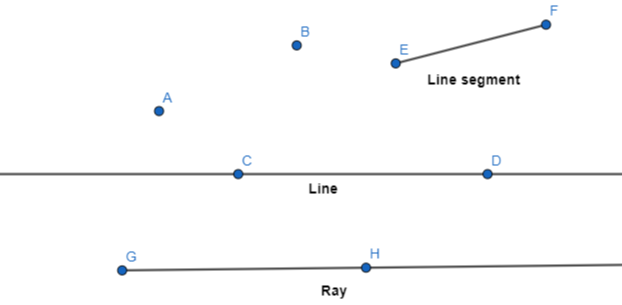
Explanation:
The differences between a line, a ray, and a line segment are
Line : A line has a starting point but no ending point CD, A line is a one-dimensional figure, which has length but no width. A line is made of a set of points which is extended in opposite directions infinitely.
Ray : A ray is a part of a line that has a fixed starting point but no endpoint GH, A ray is a part of the line having one fixed point and the other point does not have an end. It means that a ray has one terminating end and the other end is extending infinitely.
Line Segment : A line segment has both starting point and an ending point EF. A line segment is bounded by two distinct points on a line. Or we can say a line segment is part of the line that connects two points. A line has no endpoints and extends infinitely in both the direction but a line segment has two fixed or definite endpoints.
Exploration 2
Intersections of Lines and Planes
Work with a partner:
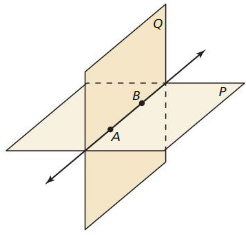
a. Describe and sketch the ways in which two lines can intersect or not intersect. Give examples of each using the lines formed by the walls. floor. and ceiling in your classroom.
Answer:
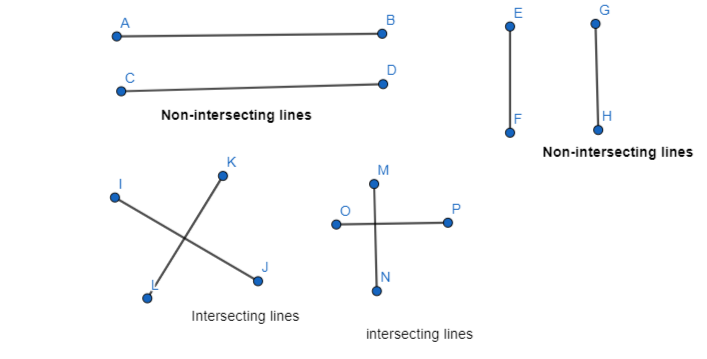
Explanation:
Non-intersecting lines can never meet. · They are also known as the parallel lines. They are always at the same distance from one another.
Examples of non-intersecting lines are floor and ceiling – AB, CD and EF, GH,
Two or more lines which share exactly one common point are called intersecting lines. This common point exists on all these lines and is called the point of intersection. It is to be noted that: The intersecting lines meet at one, and only one point, no matter at what angle they meet. Examples of intersecting lines are walls and floor – IJ, LK and MN, OP.
b. Describe and sketch the ways in which a line and a plane can intersect or not intersect. Give examples of each using the walls. floor, and ceiling in your classroom.
Answer:
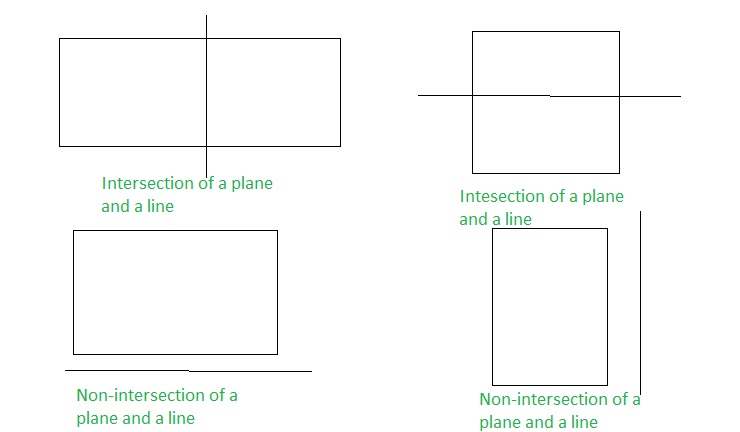
Explanation:
If a line and a plane intersect one another, the intersection will be a single point, or a line (if the line lies in the plane). Examples of the intersection of a plane and a line are walls and ceiling, Two planes that do not intersect are called parallel planes, Examples of the non-intersection of a plane and a line are floor and a blackboard.
c. Describe and sketch the ways in which two planes can intersect or not intersect. Give examples of each using the walls. floor, and ceiling in your classroom.
Answer:

Explanation:
If a line and a plane intersect one another, the intersection will be a single point, or a line (if the line lies in the plane). Examples of the intersection of planes are floor and benches,
Two planes that do not intersect are called parallel planes, Examples of the non-intersection of planes are floor and ceiling.
Exploration 3
Exploring Dynamic Geometry Software
UNDERSTANDING MATHEMATICAL TERMS
To be proficient in math, you need to understand definitions and previously established results. An appropriate tool, such as a software package, can sometimes help.
Work with a partner. Use dynamic geometry software to explore geometry. Use the software to find a term or concept that is unfamiliar to you. Then use the capabilities of the software to determine the meaning of the term or concept.
Answer:
The dynamic geometry software used is “GeoGebra”
The URL for “GeoGebra – Geometry” is:
https://www.geogebra.org/calculator
So,
Using the above URL,
Check the term that you are unfamiliar to you and find the meaning of that term using the above URL
Communicate Your Answer
Question 4.
How can you use dynamic geometry software to visualize geometric concepts?
Answer:
a. Request dispatching for cheap energy prices in cloud data centers,
b. Springerlink training kit,
c. Luminosity measurements at Hadron colliders,
d. From word embeddings to document distances,
Explanation:
Some of the uses dynamic geometry software to visualize geometric concepts are
a. Request dispatching for cheap energy prices in cloud data centers,
b. Springerlink training kit,
c. Luminosity measurements at Hadron colliders,
d. From word embeddings to document distances.
Lesson 1.1 Points, Lines, and Planes
Monitoring Progress
Question 1.
Use the diagram in Example 1. Give two other names for  . Name a point that is not coplanar with points Q. S, and T.
. Name a point that is not coplanar with points Q. S, and T.

Answer:
S and T are co-planar, Q is not co-planar,
Explanation:
The given plane is

The definition of a ray is a ray has no starting and ending points, So the other names for \(\overline{S T}\) are Line m and \(\overline{T S}\), We know that “Co-planar points” are the points if all of them lie in the same plane. Hence among the points Q, S and T, S and T are co-planar since they lie in the same plane and Q is not co-planar.
Question 2.
Give another name for \(\overline{K L}\).
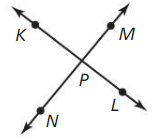
Answer:
\(\overline{L K}\),
Explanation:
The given figure is

So the other name of \(\overline{K L}\) is \(\overline{L K}\).
Question 3.
Are \(\vec{K}\)P and \(\vec{P}\)K the same ray? Are \(\vec{N}\)P and \(\vec{N}\)M the same ray? Explain.

Answer:
\(\overline{K L}\) is the ray and KP is the line segment,
The points N, P, and M are collinear the ray \(\vec{N}\)M and \(\vec{N}\)P are in the same plane,
Explanation:
The given figure is:

So from the above figure, We can observe that \(\vec{K}\)P and \(\vec{P}\)K are not the same ray so \(\overline{K L}\) is the ray and KP is the line segment, Now we can also observe that \(\vec{N}\)P and \(\vec{N}\)M are in the same ray. Since the points N, P, and M are collinear, the ray \(\vec{N}\)M and \(\vec{N}\)P are in the same plane.
Question 4.
Sketch two different lines that intersect a plane at the same point.
Answer:
The representation of the two different lines that intersect a plane at the same point is:
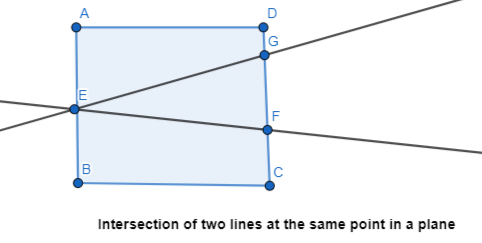
Explanation:
Sketched two different lines GE, EF that intersect a plane at the same point E as shown above.
Question 5.
Name the intersection of  and line k.
and line k.
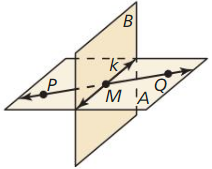
Answer:
M,
Explanation:
The given figure is

From the above figure we can observe that the intersection of \(\overline{P Q}\) and line k is M.
Question 6.
Name the intersection of plane A and plane B.

Answer:
Line k,
Explanation:
The given figure is:

From the above figure we can observe that the intersection of plane A and plane B is Line k.
Question 7.
Name the intersection of line k and plane A.

Answer:
Line k,
Explanation:
The given figure is:

From the given figure we can observe that the intersection of line k and plane A is Line k.
Monitoring Progress
Use the diagram that shows a molecule of phosphorus pentachloride.

Question 8.
Name two different planes that contain line s.
Answer:
JHG and KLI,
Explanation:
The given figure is:

We know that a ‘Plane” can be formed by using any three non-collinear points on the same plane. Now from the given figure we can observe that the different planes that contain line s are JHG and KLI.
Question 9.
Name three different planes that contain point K.
Answer:
HGK, HKL, and KLI,
Explanation:
The given figure is

From the above figure the three different planes that contain pint K are HGK, HKL, and KLI.
Question 10.
Name two different planes that contain \(\vec{H}\)J.
Answer:
HJI and HJL,
Explanation:
The given figure is

From the above figure we can say that the 2 different planes that contain \(\vec{H}\)J are HJI and HJL.
Exercise 1.1 Points, Lines, and Planes
Vocabulary and Core Concept Check
Question 1.
WRITING
Compare collinear points and coplanar points.
Answer:
Collinear points are the points that lie on the same straight line or in a single line,
Coplanar points are three or more points which all lie in the same plane. Any set of three points in space is coplanar,
Explanation:

If two or more than two points lie on a line close to or far from each other, then they are said to be collinear.
Question 2.
WHICH ONE DOES DOESN’T BELONG?
Which term does not belong with the other three? Explain your reasoning.

Answer:
c does not belong with the other three,
Explanation:
The given expressions are a. \(\overline{A B}\),
b. plane CDE,
c. \(\vec{FG}\)
d. \(\vec{H}\)I, From the four expressions we can observe that the three expressions are 2-dimensional geometrical expressions whereas 1 figure is a 3-dimensional geometrical expression.
The 2-dimensional geometrical expressions from the given expressions are: a), c), and d), Hence from the above we can conclude that expression c. does not belong with the other three.
Monitoring Progress and Modeling with Mathematics
In Exercises 3 – 6, use the diagram.

Question 3.
Name four points.
Answer:
Four points : A, B, C and D,
Explanation:

Question 4.
Name two lines.
Answer:
\(\vec{B}\)C and \(\vec{D}\)E,
Explanation:
The given figure is

Hence from the above figure we can conclude that the two lines are: \(\vec{B}\)C and \(\vec{D}\)E.
Question 5.
Name the plane that contains points A, B, and C.
Answer:
Plane S,
Explanation:

Question 6.
Name the plane that contains points A, D, and E.
Answer:
Plane T and Plane S,
Explanation:
The given figure is

From the given figure we can observe that there are 2 planes. They are a. plane S b. plane T
Hence from the above figure we can conclude that points A, D, and E lie in Plane T.
In Exercises 7 – 10. use the diagram. (See Example 1.)
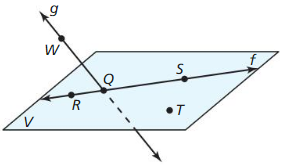
Question 7.
Give two other names for  .
.
Answer:

Explanation:

Question 8.
Give another name or plane V.
Answer:
Plane QRT,
Explanation:
The given figure is

We know that A plane is also named by a group of 3 or more co-planar points, Hence from the above we can conclude that another name for plane V is plane QRT.
Question 9.
Name three points that are collinear. Then name a fourth point that is not collinear with these three points.
Answer:
Collinear : R, Q and S,
Not Collinear : T or W,
Explanation:

Question 10.
Name a point that is not coplanar with R, S, and T.
Answer:
W,
Explanation:
The given figure is

We know that the points that are present in the same plane are called “Co-planar points”, Hence from the above we can conclude that the point that is co-planar with R, S, and T is W.
In Exercises 11 – 16, use the diagram.
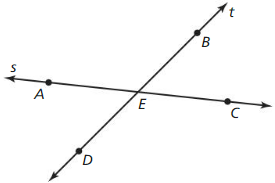
Question 11.
What is another name for \(\overline{B D}\)?
Answer:
\(\overline{D B}\),
Explanation:

Question 12.
What is another name for \(\overline{A C}\)?
Answer:
\(\overline{C A}\),
Explanation:
The given figure is

We know that the line segment is the same from both sides if we can consider any point starting or ending point Ex: \(\overline{A B}\) is the same as \(\overline{B A}\) because we can consider here either starting point A or starting point B, then the ending points will be either B or A. Hence from the above we can conclude that the other name for \(\overline{A C}\) is \(\overline{C A}\).
Question 13.
What is another name for ray \(\vec{A}\)E?
Answer:
\(\vec{A}\)C,
Explanation:

Question 14.
Name all rays with endpoint E.
Answer:
s and t,
Explanation:
The given figure is

Hence from the above figure we can conclude that the rays with endpoint E are s and t.
Question 15.
Name two pairs of opposite rays.
Answer:
\(\vec{E}\)A and \(\vec{E}\)C,
\(\vec{E}\)B and \(\vec{E}\)D,
Explanation:

Question 16.
Name one pair of rays that are not opposite rays.
Answer:
\(\vec{E}\)B and \(\vec{E}\)C,
Explanation:
The given figure is

We know that “opposite” means “Opposite direction”, Hence from the above,
We can conclude that the pair of rays that are not opposite rays are: \(\vec{E}\)B and\(\vec{E}\)C.
In Exercises 17 – 24, sketch the figure described.
Question 17.
plane P and line l intersecting at one point
Answer:
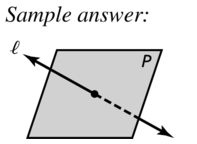
Explanation:
Shown the plane P and line l intersecting at one point above.
Question 18.
plane K and line m intersecting at all points on line m
Answer:

Explanation:
The given statement is: plane K and line m intersecting at all points on line m, Hence the representation of the given statement is shown above.
Question 19.

Answer:
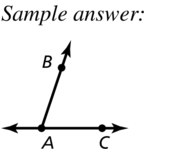
Explanation:
Sketched the figure  above.
above.
Question 20.
\(\vec{M}\)N and \(\vec{N}\)X
Answer:

Explanation:
The given vectors are \(\vec{M}\)N and \(\vec{N}\)X, Hence the representation of vectors along with their direction is shown above.
Question 21.
plane M and \(\vec{N}\)B intersecting at B
Answer:
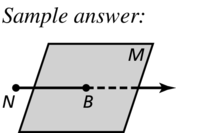
Explanation:
Shown plane M and \(\vec{N}\)B intersecting at B above.
Question 22.
plane M and \(\vec{N}\)B intersecting at A
Answer:
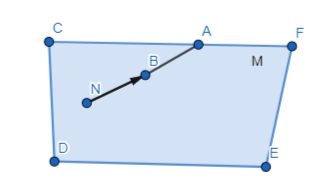
Explanation:
The given statement is plane M and \(\vec{N}\)B intersecting at A, Hence the representation of the given statement is shown above.
Question 23.
plane A and plane B not intersecting
Answer:
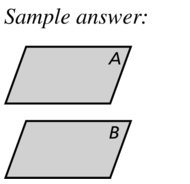
Explanation:
Shown plane A and plane B not intersecting above.
Question 24.
plane C and plane D intersecting at 
Answer:
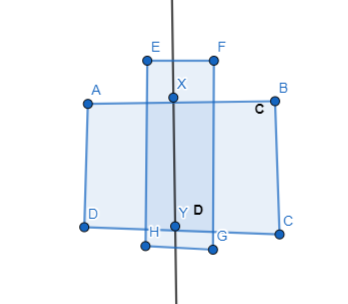
Explanation:
The given statement is plane C and plane D intersecting at  , Hence the representation of the given statement is shown above.
, Hence the representation of the given statement is shown above.
ERROR ANALYSIS
In Exercises 25 and 26, describe and correct the error in naming opposite rays in the diagram.
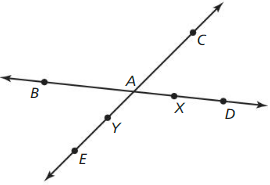
Question 25.

Answer:
A, D and C are noncollinear, A,B and D are collinear, A is between B and D,
Explanation:

Question 26.

Answer:

Y, C, and E are the collinear points and Y is in between C and E,
Explanation:
From the above fiqure we can observe that \(\vec{Y}\)C and \(\vec{Y}\)E are the opposite rays because Y, C, and E are the collinear points and Y is in between C and E.
In Exercises 27 – 34. use the diagram.
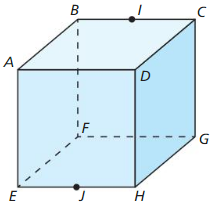
Question 27.
Name a point that is collinear with points E and H.
Answer:
J,
Explanation:
If we see the fiqure 
Question 28.
Name a point that is collinear with points B and I
Answer:
C,
Explanation:
The given figure is

Collinear points are the points that lie on the same straight line or in a single line. If two or more than two points lie on a line close to or far from each other, then they are said to be collinear, Hence from the above figure we can conclude that C is collinear with B and I.
Question 29.
Name a point that is not collinear with points E and H.
Answer:
A, B, C, D, F, G and I,
Explanation:
When the points in a place, does not lie on the same line, then such points are called non-collinear points. So 
Question 30.
Name a point that is not collinear with points B and I.
Answer:
A, D, E, F, G, H, J are not collinear with points B and I,
Explanation:
The given figure is

We know that the points that are in the same line are called “Collinear points”, Hence from the above figure, We can conclude that A, D, E, F, G, H, J are not collinear with points B and I.
Question 31.
Name a point that is coplanar with points D, A, and B.
Answer:
I and C,
Explanation:
Coplanar points are three or more points which all lie in the same plane. Any set of three points in space is coplanar.

Question 32.
Name a point that is coplanar with points C, G, and F.
Answer:
B and I,
Explanation:
The given figure is

We know that the points that are in the same plane are called “Co-planar points”, From the above figure we can observe that CGFB is a plane, So we can conclude that B and I are co-planar with points C, G, and F.
Question 33.
Name the intersection of plane AEH and plane FBE.
Answer:

Explanation:
If a line and a plane intersect one another, the intersection will be a single point, or a line (if the line lies in the plane). So,

Question 34.
Name the intersection of plane BGF and plane HDG.
Answer:
\(\overline{C G}\),
Explanation:
The given figure is

Hence from the above figure we can conclude that the intersection of plane BGF and plane HDG is \(\overline{C G}\).
In Exercises 35 – 38, name the geometric term modeled by the object.
Question 35.
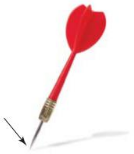
Answer:
Point,
Explanation:
A point is a dimensionless shape, since it represents a dot only. A point does not have any length, width, shape or size, it only has a position.
Question 36.

Answer:
Plane,
Explanation:
The given object is

Hence from the above we can conclude that the geometric term modeled by the object is Plane. Plane is also known as a two-dimensional surface. A plane has zero thickness, zero curvature, infinite width, and infinite length. It is actually difficult to imagine a plane in real life; all the flat surfaces of a cube or cuboid, flat surface of paper are all real examples of a geometric plane.
Question 37.

Answer:
Segment,
Explanation:
In geometry, a line segment is bounded by two distinct points on a line. Or we can say a line segment is part of the line that connects two points.
Question 38.
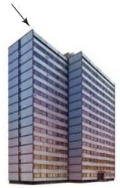
Answer:
Line,
Explanation:
The given figure is

A line is a one-dimensional figure, which has length but no width. A line is made of a set of points which is extended in opposite directions infinitely. Hence from the above figure we can conclude that the geometric term modeled from the given object is line.
In Exercises 39 – 44. use the diagram to name all the points that are not coplanar with the given points.
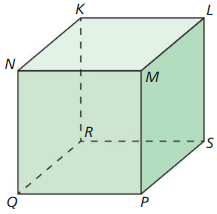
Question 39.
N, K, and L
Answer:
Q, R, S and P,
Explanation:
A set of points in space are coplanar if there exists a geometric plane that contains them all,
Two or more lines are said to be coplanar if they lie on the same plane and the lines that do not lie in the same plane are called non-coplanar lines,
From the given fiqure Q, R, S and P are not coplanar with N,K and L.
Question 40.
P, Q, and N
Answer:
R, S, L and K,
Explanation:
The given figure is

A set of points in space are coplanar if there exists a geometric plane that contains them all. Two or more lines are said to be coplanar if they lie on the same plane and the lines that do not lie in the same plane are called non-coplanar lines. Hence from the above figure we can conclude that R, S, L, and K are not co-planar with P, Q, and N.
Question 41.
P, Q, and R
Answer:
K, L, M and N,
Explanation:
Two or more lines are said to be coplanar if they lie on the same plane, and the lines that do not lie in the same plane are called non-coplanar lines. From the fiqure we can say K, L, M and N are not coplanar with P, Q and R.
Question 42.
R, K, and N
Answer:
P, S, L and M,
Explanation:
The given figure is

Two or more lines are said to be coplanar if they lie on the same plane and the lines that do not lie in the same plane are called non-coplanar lines. Hence from the above figure we can conclude that P, S, L, and M are not co-planar with R, K, and N.
Question 43.
P, S, and K
Answer:
Q, L, M and R,
Explanation:
Two or more lines are said to be coplanar if they lie on the same plane and the lines that do not lie in the same plane are called non-coplanar lines. From the fiqure we can say Q, L, M and R are not coplanar with P, S and K.
Question 44.
Q, K, and L
Answer:
R, M, P and S,
Explanation:
The given figure is

Two or more lines are said to be coplanar if they lie on the same plane and the lines that do not lie in the same plane are called non-coplanar lines. Hence from the above figure we can conclude that R, M, P, and S are not co-planar with Q, K, and L.
Question 45.
CRITICAL THINKING
Given two points on a line and a third point not on the line. is it possible to draw
a plane that includes the line and the third point? Explain your reasoning.
Answer:
Yes,
Explanation:
Yes, we can use the point not on the line and two points on the line to draw the plane.
Question 46.
CRITICAL THINKING
Is it possible for one point to be in two different planes? Explain your reasoning.
Answer:
Yes,
Explanation:
It is possible for one point to be in two different planes. This can be explained in the following way as the Intersection of two planes is a line hence one point or an Infinite number of points can be common between two different planes.
Question 47.
REASONING
Explain why a four-legged chair may rock from side to side even if the floor is level. Would a three-legged chair on the same level floor rock from side to side? Why or why not?
Answer:
Three of the four legs end in a plane on the floor, but the fourth leg may be above the floor. For a three -legged chair three points define a plane all the three legs will be flat on the floor even if one leg is shorter than the other two,
Explanation:
Three of the four legs end in a plane on the floor, but the fourth leg may be above the floor. For a three -legged chair three points define a plane all the three legs will be flat on the floor even if one leg is shorter than the other two.
Question 48.
THOUGHT-PROVOKING
You are designing the living room of an apartment. Counting the floor, walls, and ceiling, you want the design to contain at least eight different planes. Draw a diagram of your design. Label each plane in your design.
Answer:

Explanation:
It is given that we are designing the living room of an apartment and you want the design to contain at least eight different planes which include the floor, walls, and ceiling, Hence the representation of the design that contain floor, walls and ceiling is drawn and labeled the each plane above.
Question 49.
LOOKING FOR STRUCTURE
Two coplanar intersecting lines will always intersect at one point. What is the greatest number of intersection points that exist if you draw tour coplanar lines? Explain.
Answer:
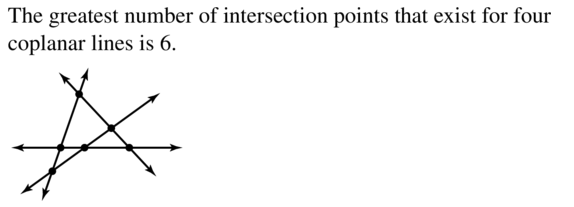
Explanation:
If two coplanar intersecting lines will always intersect at one point. The greatest number of intersection points that exist for four coplanar lines is 6 if we draw the lines as shown above.
Question 50.
HOW DO YOU SEE IT?
You and your friend walk in opposite directions, forming opposite rays. You were originally on the comer of Apple Avenue and Cherry Court.
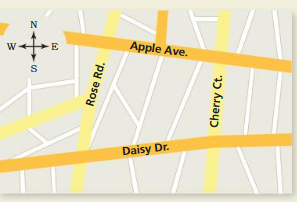
a. Name two possibilities of the road and direction you and your friend may have traveled.
Answer:
i) If you traveled from the corner of Apple Avenue and Cherry court i.e., towards the east, then your friend will travel from the corner of Apple Avenue and Rose Rd. i.e., towards the west,
ii) If you traveled from the corner of Apple Avenue and Cherry court i.e., towards the west, then your friend will travel from the corner of Apple Avenue and Rose Rd. i.e., towards the east,
Explanation:
Given that you are at the corner of Apple Avenue and Cherry court, Hence from the above,
The 2 possibilities that you and your friend travel in the opposite directions are:
i) If you traveled from the corner of Apple Avenue and Cherry court i.e., towards the east, then your friend will travel from the corner of Apple Avenue and Rose Rd. i.e., towards the west.
ii) If you traveled from the corner of Apple Avenue and Cherry court i.e., towards the west, then your friend will travel from the corner of Apple Avenue and Rose Rd. i.e., towards the east.
b. Your friend claims he went north on Cherry Court. and you went east on Apple Avenue. Make an argument as to why you know this could not have happened.
Answer:
You and your friend travels in the perpendicular directions so can conclude that the claim of my friend is not possible,
Explanation:
It is given that your friend claims he went north on Cherry Court and you went east on Apple Avenue
But, from the above, It is given that you and your friend have to travel in the opposite directions,
But, according to the given statement, ” You and your friend travels in the perpendicular directions”
Hence I can conclude that the claim of my friend is not possible.
MATHEMATICAL CONNECTIONS
In Exercises 51 – 54. graph the inequality on a number line. Tell whether the graph is a segment a ray or rays. a point, or a line.
Question 51.
x ≤ 3
Answer:

Explanation:
Graphed the inequality x ≤ 3 on a number line above it is an ray.
A ray is a part of a line that has one endpoint and goes on infinitely in only one direction.
Question 52.
– 7 ≤ x ≤ 4
Answer:
Line segment on the number line,
Explanation:
The given inequality is -7 ≤ x ≤ 4
Hence the representation of the given inequality in the number line is:

We can conclude that the given inequality represents a line segment on the number line.
Question 53.
x ≥ 5 or x ≤ – 2
Answer:

Explanation:
Graphed the inequalities x ≥ 5 or x ≤ – 2 on a number line above they are rays.
A ray is a part of a line that has one endpoint and goes on infinitely in only one direction.
Question 54.
|x| ≤ 0
Answer:
Plane,
Explanation:
The given inequality is | x | ≤ 0, Hence the representation of the given inequality in the number line is
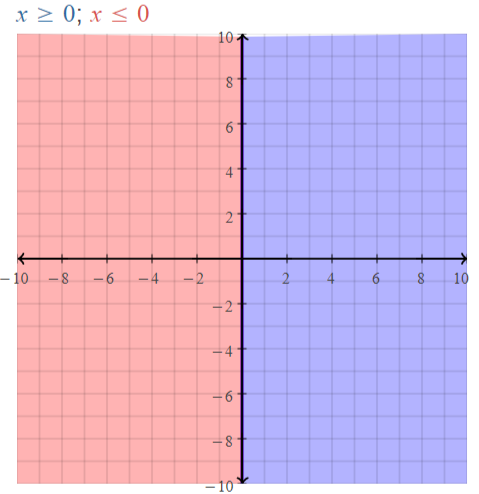
From the above number line we can conclude that the given inequality represents the plane on the number line.
Question 55.
MODELING WITH MATHEMATICS
Use the diagram.
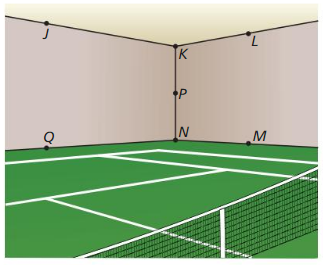
a. Name two points that arc collinear with P.
b. Name two planes that contain J.
c. Name all the points that are in more than One plane.
Answer:
a. K and N,
b. Planes JKL and JKN,
c. J, K, L, M, N, P and Q,
Explanation:
By using the diagram

CRITICAL THINKING
In Exercises 56 – 63. complete the
statement with always, sometimes, or never. Explain your reasoning.
Question 56.
A line ________________ has endpoints.
Answer:
never,
Explanation:
The given statement is: A line ________________ has endpoints.
Hence, The completed statement is A line never has endpoints.
Question 57.
A line and a point _________________ intersect
Answer:
Sometimes,
Explanation:
A line and a point sometimes intersect, the point me be on the line.
Question 58.
A plane and a point ________________ intersect.
Answer:
Sometimes,
Explanation:
The given statement is: A plane and a point ________________ intersect.
Hence, The completed statement is A plane and a point sometimes intersect.
Question 59.
Two planes _________________ intersect in a line.
Answer:
Sometimes,
Explanation:
Two planes sometimes intersect in a line.
Question 60.
Two points ____________________ determine a line.
Answer:
always,
Explanation:
The given statement is: Two points ____________________ determine a line.
Hence,The completed statement is Two points always determine a line.
Question 61.
Any three points ____________________ determine a plane.
Answer:
Sometimes,
Explanation:

Question 62.
Any three points not on the same line ____________________ determine a plane.
Answer:
Always,
Explanation:
The given statement is: Any three points not on the same line ____________________ determine a plane.
Hence, The completed statement is Any three points not on the same line always determine a plane.
Question 63.
Two lines that are not parallel _________________ intersect.
Answer:
Sometimes,
Explanation:

So two lines that are not parallel sometimes intersect.
Question 64.
ABSTRACT REASONING
Is it possible for three planes to never intersect? intersect in one line? intersect in one point? Sketch the possible situations.
Answer:
It is not possible for three planes to intersect when the three planes are parallel,
To intersect in 1 line, the two planes must be perpendicular and the third plane should pass through that line,
To intersect in 1 point, the two planes must be intersected with a line and the third plane passes through a point of that line,
Explanation:
Case (1):
It is not possible for three planes to intersect when the three planes are parallel, So the representation of this case is:

Case (2):
To intersect in 1 line, the two planes must be perpendicular and the third plane should pass through that line,
So the representation of this case is:
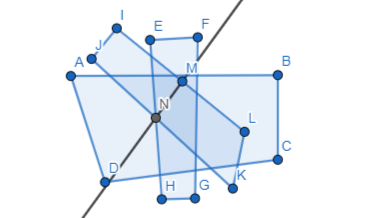
Case (3):
To intersect in 1 point, the two planes must be intersected with a line and the third plane passes through a point of that line, So the representation of this case is:

Maintaining Mathematical Proficiency
Find the absolute value.
Question 65.
|6 + 2|
Answer:
8,
Explanation:

The given absolute value expression is | 6 + 2 | , As we know that the absolute value of a number or integer is the actual distance of the integer from zero, in a number line. Therefore, the absolute value is always a positive, We know that | x | = x for x > 0, | -x | = x for x > 0, So | 6 + 2 | = | 8 | = 8. Hence, from the above we can conclude that the value of the given absolute value expression is 8.
Question 66.
|3 – 9|
Answer:
6,
Explanation:
The given absolute value expression is | 3 – 9 | we know that | x | = x for x > 0, | -x | = x for x > 0,So, | 3 – 9 | = | -6 | = 6, Hence from the above we can conclude that the value of the given absolute value expression is 6.
Question 67.
|- 8 – 2|
Answer:
10,
Explanation:

The given absolute value expression is | -8 – 2 | we know that As we know that the absolute value of a number or integer is the actual distance of the integer from zero, in a number line. Therefore, the absolute value is always a positive, | x | = x for x > 0, | -x | = x for x > 0, So | -8 – 2 | = | -10 | = 10, Hence from the above we can conclude that the value of the given absolute value expression is 10.
Question 68.
|7 – 11|
Answer:
4,
Explanation:
The given absolute value expression is | 7 – 11 |, We know that As we know that the absolute value of a number or integer is the actual distance of the integer from zero, in a number line. Therefore, the absolute value is always a positive, | x | = x for x > 0, | -x | = x for x > 0, So | 7 – 11 | = | -4 | = 4, Hence from the above we can conclude that the value of the given absolute value expression is 4.
Solve the equation
Question 69.
18 + x = 43
Answer:
25,
Explanation:
Subtracting 18 from both sides we get

Question 70.
36 + x = 20
Answer:
-16,
Explanation:
The given equation is 36 + x = 20, So x = 20 – 36,
x = -16, Hence from the above we can conclude that the value of x is -16.
Question 71.
x – 15 = 7
Answer:
22,
Explanation:
Adding 15 both sides we get

Question 72.
x – 23 = 19
Answer:
42,
Explanation:
The given equation is x – 23 = 19,
So x = 19 + 23, x = 42, Hence from the above we can conclude that the value of x is 42.
1.2 Measuring and Constructing Segments
Essential Question
How can you measure and construct a line segment?
Answer:
The steps used to measure a line segment are:
a. Pick up a scale to measure the length of a line segment.
b. Identify the line segment you want to measure
c. Place the tip of the ruler at the starting of the line segment
The steps used to construct a line segment are:
a. Place the compass at one end of the line
b. Adjust the compass to slightly longer than half of the line’s length
c. Draw arcs above and below the line
d. Keeping the same compass width, draw arcs from the other end of the line
e. Place ruler where the arcs cross and draw the line segment
Exploration 1
Measuring Line Segments Using Nonstandard Units
Work with a partner.
a. Draw a line segment that has a length of 6 inches.
Answer:

Explanation:
Used a ruler to draw a line segment and the ruler we use generally is the “Centimeter ruler”
But, It is given that we have to draw a line segment that has a length of 6 inches
But, it is not possible so converting inches into centimeters, We know that 1 inch = 2.54 centimeters, So 6 inches = 15.24 cm,
Hence, the representation of the line segment that has the length of 6 inches in terms of cm is:

b. Use a standard-sized paper clip to measure the length of the line segment. Explain how you measured the line segment in “paper clips.”
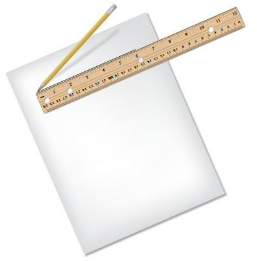

Answer:

Explanation:
Using a standard-sized paper clip, the length of the line segment is: 3.4925 cm or 3.5 cm
Hence the representation of the length of the line segment that is measured in the paper clip is:

c. Write conversion factors from paper clips to inches and vice versa.

Answer:
1 paperclip = 1.377 inch,
1 inch = 2.54 paperclip,
Explanation:
From part (b), We know that the length of a paper clip is: 3.5 cm,
We know that 1 cm = 0.393 inches, So 3.5 cm = 1.377 inches,
Hence 1 paper clip = 1.377 in, Now we know that 1 inch = 2.54 cm,
Hence 1 inch = 2.54 paperclip, Hence from the above we can conclude that the conversion of paper clips into inches and vice-versa is 1 paperclip = 1.377 inch and 1 inch = 2.54 paperclip.
d. A straightedge is a tool that you can use to draw a straight line. An example of a straightedge is a ruler. Use only a pencil, straightedge, paper clip, and paper to draw another line segment that is 6 inches long. Explain your process.
Answer:
The representation of the line segment AB of 6 inches long is:

Explanation:
The process using a pencil, a straightedge, paperclip, and paper to draw a line segment of 6 inches is:
Step 1:
Attach a paper to the paperclip and verify that the paper sets correctly in the paperclip,
Step 2:
Now, use a straightedge tool like a ruler to draw a line segment on the paper,
Step 3:
The line segment must start from the starting of the ruler i.e, 0. Mark the point at 0 as A,
Step 4:
Continue the line segment from 0 to 6 on the ruler and make the endpoint at 6 and label it as B
Hence, from the above steps we draw the lines segment AB of length 6 inches,
But we know that a ruler consists of the only cm.
So, convert inches into cm 1 inch = 2.54 cm, So, 6 inches = 15.24 cm,
Hence the representation of the line segment AB of 6 inches long is:

Exploration 2
Measuring Line Segments Using Nonstandard Units
Work with a partner.
a. Fold a 3-inch by 5-inch index card on one of its diagonals.

Answer:
The representation of the folded index card at its diagonal is
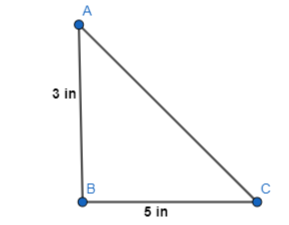
Explanation:
The given index card is:

When we fold the given index card we can only see the right-angled triangle, Hence the representation of the folded index card at its diagonal is:

b. Use the Pythagoras Theorem to algebraically determine the length of the diagonal in inches. Use a ruler to check your answer.
Answer:
The length of the diagonal is approximately equal to 6 inches,
Explanation:
From part (a), The index card folded at its diagonal is

We know that according to Pythagoras theorem Hypotenuse² = Side² + Side², Where the hypotenuse is the longest side in a right-angled triangle, So in the given triangle AB and BC are the sides, AC is the hypotenuse
So AC² = 3² + 5²,
AC² = 9 + 25,
AC² = 34,
AC = √34 ≅ 6 in,
Hence, from the above we can conclude that the length of the diagonal is approximately equal to 6 inches.
c. Measure the length and width of the index card in paper clips.
Answer:
Length : 4 cm, Width : 1 cm,
Explanation:
As we know that the length of the index card in paper clips is 4 cm (Approximately) and the width of the index card in the paper clips is 1 cm.
d. Use the Pythagoras Theorem to algebraically determine the length of the diagonal in paper clips. Then check your answer by measuring the length of the diagonal in paper clips. Does the Pythagorean Theorem work for any unit of measure? Justify your answer.
Answer:
The length of the diagonal in paper clips is 4 cm,
Yes, the Pythagoras work for any unit of measure but it is applicable only for the right-angled triangles,
Explanation:
The representation of the length and width of the paper clips is
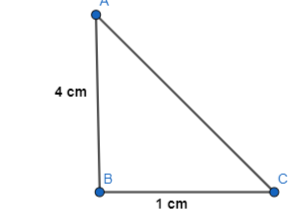
We know that according to Pythagoras theorem Hypotenuse² = Side² + Side²,
Where the hypotenuse is the longest side in a right-angled triangle, So in the given triangle
AB and BC are the sides, AC is the hypotenuse, So
AC² = 4² + 1²,
AC² = 16 + 1,
AC² = 17,
AC = √17 ≅ 4 cm,
Hence from the above we can conclude that the length of the diagonal in paper clips is 4 cm,
Yes, the Pythagoras work for any unit of measure but it is applicable only for the right-angled triangles.
Exploration 3
Measuring Heights Using Nonstandard Units
Work with a partner.
Consider a unit of length that is equal to the length of the diagonal you found in Exploration 2. Call this length “1 diag.” How tall are you in diags? Explain how you obtained your answer.
Answer:
10.6 diags tall,
Explanation:
From Exploration 2, The length of the diagonal we have found is approximately equal to 6 inches. So according to the given problem 1 diag = 6 inches,
We know that the height can be measured in the foot, So 1 inch = 0.08 feet,
So 63.6 inch = 5.3 feet, So in terms of diags 63.6inches = 60 + 3.6 inches,
= 10 (6 inches) + 6 (0.6 inches)
= 10 diags + 0.6 diags
= 10.6 diags, We can conclude that you are10.6 diags tall.
Communicate Your Answer:
Question 4.
How can you measure and construct a line segment?
Answer:
The steps used to measure a line segment are:
a. Pick up a scale to measure the length of a line segment,
b. Identify the line segment you want to measure,
c. Place the tip of the ruler at the starting of the line segment.
The steps used to construct a line segment are:
a. Place the compass at one end of line.
b. Adjust the compass to slightly longer than half of the line’s length.
c. Draw arcs above and below the line.
d. Keeping the same compass width, draw arcs from the other end of line.
e. Place ruler where the arcs cross and draw the line segment.
Explanation:
The steps used to measure a line segment are:
a. Pick up a scale to measure the length of a line segment,
b. Identify the line segment you want to measure,
c. Place the tip of the ruler at the starting of the line segment.
The steps used to construct a line segment are:
a. Place the compass at one end of line.
b. Adjust the compass to slightly longer than half of the line’s length.
c. Draw arcs above and below the line.
d. Keeping the same compass width, draw arcs from the other end of line.
e. Place ruler where the arcs cross and draw the line segment.
Lesson 1.2 Measuring and Constructing Segments
Monitoring Progress
Use a ruler to measure the length of the segment.
Question 1.

Answer:
3.9 cm,
Explanation:
The length of the given segment in cm is:

Question 2.

Answer:
3.3 cm,
Explanation:
The length of the given line segment in cm is:

Question 3.

Answer:
2.1 cm,
Explanation:
The length of the given line segment in cm is:

Question 4.

Answer:
2.9 cm,
Explanation:
The length of the given line segment in cm is:

Question 5.
Plot A(- 2, 4), B(3, 4), C(0, 2), and D(0, – 2) in a coordinate plane. Then
determine whether \(\overline{A B}\) and \(\overline{C D}\) are congruent.
Answer:

\(\overline{A B}\) and \(\overline{C D}\) are not congruent,
Explanation:
The given points are A (-2, 4), B (3, 4), C (0, 2), and D (0, -2),
We know that the distance between 2 points is d = √(x2 – x1)² + (y2 – y1)²,
Now the representation of the given points in the coordinate plane is:
The distance between AB = √(4 – 4)² + (3 + 2)²
= √0 + 5²,
= √5² = 5,
The distance between CD = √(0 – 0)² + (-2 – 2)²
= √0 + 4²,
= √4² = 4,
Since the distance between \(\overline{A B}\) and \(\overline{C D}\) are not same,
\(\overline{A B}\) is not congruent to \(\overline{C D}\)
Hence \(\overline{A B}\) ≠ \(\overline{C D}\).
Question 6.
Use the Segment Addition Postulate to find XZ.

Answer:

XZ = 73,
Explanation:
We know that, “The Segment Addition Postulate” states that given 2 points A and C, a third point B lies on the line segment AC if and only if the distances between the points satisfy the equation AB + BC = AC,
So, From the above figure XZ = XY + YZ,
XZ = 23 + 50,
XZ = 73,
We can conclude that the value of XZ is 73.
Question 7.
In the diagram. WY = 30. Can you use the Segment Addition Postulate to find the distance between points W and Z? Explain your reasoning.

Answer:
Yes, the distance between points W and Z is 80,
Explanation:
The given figure is

We know that “The Segment Addition Postulate” states that given 2 points A and C, a third point B lies on the line segment AC if and only if the distances between the points satisfy the equation
AB + BC = AC, It is also given that WY = 30,
Now to find the distance between the points W and Z, we have to use the “Segment Addition Postulate”
So WZ = WY + YZ,
WZ = 30 + 50,
WZ = 80,
Hence from the above we can conclude that the distance between points W and Z is 80.
Question 8.
Use the diagram at the left to find KL.

Answer:
KL = 107,
Explanation:
The given figure is

We know that by using the Segment Addition Postulate,
If we have three points A, B, and C and we know the distance AB and AC, then the value of AC is given as:,
The total distance (AC) = Segment distance 1 (AB) + Segment distance 2 (BC).
So JL = JK + KL,
144 = 37 + KL,
KL = 144 – 37,
KL = 107,
Hence from the above wecan conclude that the value of KL is 107.
Question 9.
The cities shown on the map lie approximately in a straight line. Find the distance from Albuquerque. New Mexico. to Provo. Utah.
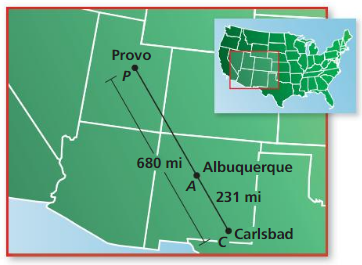
Answer:
The distance between Albuquerque and Provo is 449 mi,
Explanation:
From the given map it is given that the distance between Albuquerque and Carlsbad is 231mi,
and the distance between Carlsbad and Provo is 680mi, Now, Let the distance between Albuquerque and Provo be x so now by using the “Segment Addition Postulate”,
The distance between Carlsbad and Provo = (The distance between Albuquerque and Carlsbad) + (The distance between Albuquerque and Provo),
680 = 231 + x,
x = 680 – 231,
x = 449, Hence from the above we can conclude that the distance between Albuquerque and Provo is 449 mi.
Exercise 1.2 Measuring and Constructing Segments
Question 1.
WRITING
Explain how \(\overline{X Y}\) and XY arc different.
Answer:

Explanation:

Question 2.
DIFFERENT WORDS. SAME QUESTION
Which is different? Find “both” answers.

Find AC + CB
Find BC – AC
Find AB
Find CA + BC.
Answer:
AC + CB = 10,
BC – AC = 4,
AB = 10,
CA + BC = 10,
BC – AC is different,
Explanation:
The given line segment is

From the given line segment,
AC = 3 and CB = 7, Now,
a. AC + CB =3 + 7 = 10,
b. BC – AC = 7 – 3 = 4,
c. AB = AC + CB (By using the Segment Addition Postulate)
So, AB = 3 + 7 = 10,
d. CA + BC = 3 + 7 = 10,
Hencecfrom the above we can conclude that the expressions a, c, and d are the same and b is different.
Monitoring Progress and Modeling with Mathematics
In Exercises 3 – 6, use a ruler to measure the length of the segment to the nearest tenth of a centimeter.
Question 3.

Answer:

Explanation:
A line segment is a part of a line having two endpoints and its length is measurable.
The length of the given segment is 3.5 cm.
Question 4.

Answer:
5.6 cm,
Explanation:
A line segment is a part of a line having two endpoints and its length is measurable.
The length of the given line segment in cm is

Question 5.

Answer:

Explanation:
A line segment is a part of a line having two endpoints and its length is measurable.
The length of the given segment is 4.5 cm.
Question 6.

Answer:
6.5 cm,
Explanation:
A line segment is a part of a line having two endpoints and its length is measurable.
The length of the given line segment is:

CONSTRUCTION
In Exercises 7 and 8. use a compass and straightedge to construct a copy of the segment.
Question 7.
Copy the segment in Exercise 3.
Answer:

Explanation:
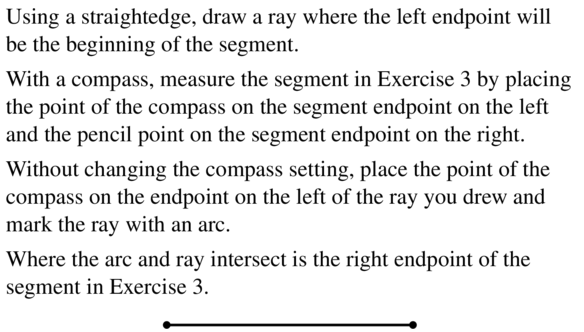
Question 8.
Copy the segment in Exercise 4.
Answer:
The segment in Exercise 4 is

Explanation:
Using a straightedge, draw a ray where the left endpoint will be the beginning of the segment. With a compass, measure the segment in Exercise 4 by placing the point of the compass on the segment endpoint on the left and the pencil point on the segment endpoint on the right. Without changing the compass setting, place the point of the compass on the endpoint on the left of the ray you drew and mark the ray with an arc where the arc and ray intersect is the right endpoint of the segment in Exercise 4. Hence the segment in Exercise 4 is  .
.
In Exercises 9 – 14, plot the points in a coordinate plane. Then determine whether \(\overline{A B}\) and \(\overline{C D}\) are congruent.
Question 9.
A(- 4, 5), B(- 4, 8), C(2, – 3), D(2, 0)
Answer:
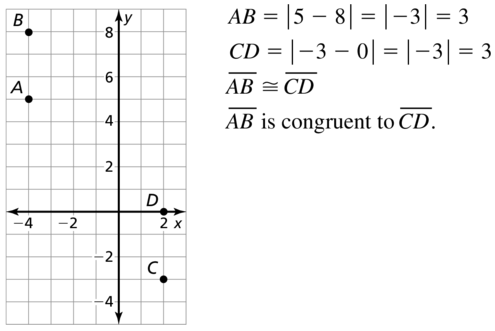
Explanation:
plotted the points A(- 4, 5), B(- 4, 8), C(2, – 3), D(2, 0) in a coordinate plane. Then determined \(\overline{A B}\) is congruent to \(\overline{C D}\).
Question 10.
A(6, – 1), B(1, – 1), C(2, – 3), D(4, – 3)
Answer:
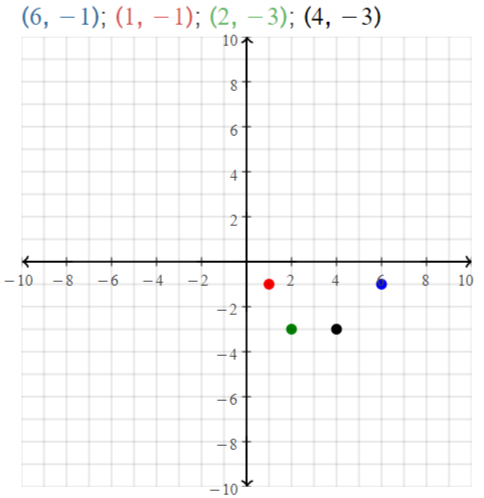
\(\overline{A B}\) is not congruent with \(\overline{C D}\),
Explanation:
The given points are A (6, -1), B (1, -1), C (2, -3), and D (4, -3),
Let the points be represented as:
A (x1, y1), B (x2, y2), C (x3, y3), and D (x4, y4)
We know that the distance between points A and B is D = √(x2 – x1)² + (y2 – y1)²
So \(\overline{A B}\) = √(1 – 6)² + (-1 + 1)²,
= √(-5)²,
= 5,
The distance between points C and D is \(\overline{C D}\) = √(x4 – x3)² + (y4 – y3)²,
= √(4 – 2)² + (-3 + 3)²,
= √2²,
= 2, Hence, from the above we can conclude that \(\overline{A B}\) is not congruent with \(\overline{C D}\), represented the given points in the coordinate plane above.
Question 11.
A(8, 3), B(- 1, 3), C(5, 10), D(5, 3)
Answer:
\(\overline{A B}\) is not congruent with \(\overline{C D}\),
Explanation:
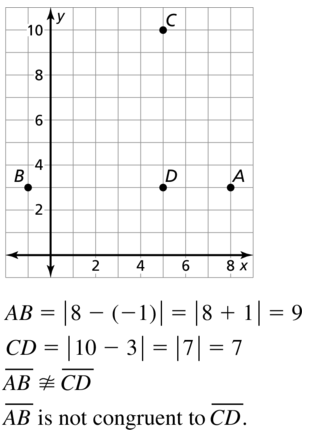
Question 12.
A(6, – 8), B(6, 1), C(7, – 2), D(- 2, – 2)
Answer:
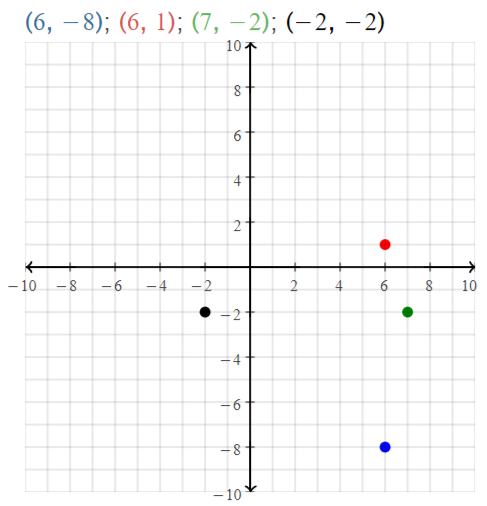
\(\overline{A B}\) is congruent with \(\overline{C D}\),
Explanation:
The given points are A (6, -8), B (6, 1), C (7, -2), and D (-2, -2),
Let the points be represented as A (x1, y1), B (x2, y2), C (x3, y3), and D (x4, y4)
We know that the distance between points A and B is
D = √(x2 – x1)² + (y2 – y1)², So \(\overline{A B}\) = √(6 – 6)² + (8 + 1)²,
= √(9)²
= 9
The distance between points C and D is \(\overline{C D}\) = √(x4 – x3)² + (y4 – y3)²,
= √(-7 – 2)² + (-2 + 2)²,
= √(-9)²,
= 9,
Hence we can conclude that \(\overline{A B}\) is congruent with \(\overline{C D}\),
The representation of the given points in the coordinate plane is shown above.
Question 13.
A(- 5, 6), B(- 5, – 1), C(- 4, 3), D(3, 3)
Answer:
\(\overline{A B}\) is congruent with \(\overline{C D}\),
Explanation:
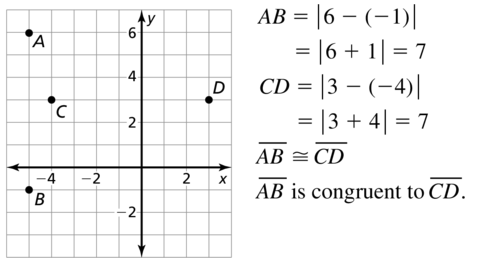
Question 14.
A(10, – 4), B(3, – 4), C(- 1, 2), D(- 1, 5)
Answer:
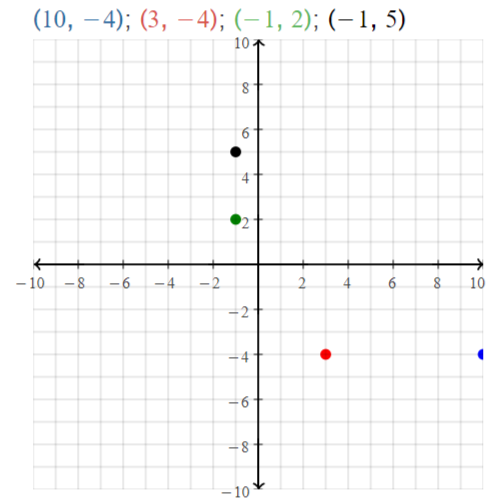
\(\overline{A B}\) is not congruent with \(\overline{C D}\),
Explanation:
The given points are A (10, -4), B (3, -4), C (-1, 2), and D (-1, 5)
Let the points be represented asA (x1, y1), B (x2, y2), C (x3, y3), and D (x4, y4)
We know that the distance between points A and B is D = √(x2 – x1)² + (y2 – y1)²
So \(\overline{A B}\) = √(3 – 10)² + (-4 + 4)²,
= √(-7)²,
= 7,
The distance between points C and D is \(\overline{C D}\) = √(x4 – x3)² + (y4 – y3)²
= √(1 – 1)² + (-2 + 5)²,
= √3²,
= 3,
Hence from the above we can conclude that \(\overline{A B}\) is not congruent with \(\overline{C D}\) tthe representation of the given points in the coordinate plane is shown above.
In Exercises 15 – 22. find FH.
Question 15.

Answer:
FH = 22,
Explanation:

Question 16.

Answer:
FH = 26,
Explanation:
The given line segment is

By using the Segment Addition Postulate FH = FG + GH,
FH = 19 + 7, FH = 26, Hence from the above we can conclude that the value of FH is 26.
Question 17.

Answer:
FH = 23,
Explanation:

Question 18.
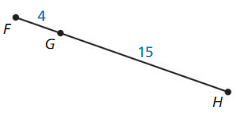
Answer:
FH = 19,
Explanation:
The given line segment is

By using the Segment Addition Postulate FH = FG + GH,
FH = 4 + 15, FH = 19, Hence from the above we can conclude that the value of FH is 19.
Question 19.

Answer:
FH = 24,
Explanation:

Question 20.

Answer:
FH = 7,
Explanation:
The given line segment is

By using the Segment Addition Postulate FG = FH + HG,
FG = FH + 15, 22 = FH + 15,
FH = 22 – 15, FH = 7, Hence from the above we can conclude that the value of FH is 7.
Question 21.
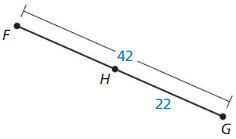
Answer:
FH = 20,
Explanation:

Question 22.

Answer:
FH = 13,
Explanation:
The given line segment is

By using the Segment Addition Postulate FG = FH + HG,
53 = FH + 40,
FH = 53 – 40, FH = 13, Hence from the above we can conclude that the value of FH is 13.
ERROR ANALYSIS
In Exercises 23 and 24, describe and correct the error in finding the length of \(\overline{A B}\).

Question 23.

Answer:
Length of \(\overline{A B}\) = 3.5 not -3.5,
Explanation:

Question 24.

Answer:
Length of \(\overline{A B}\) = 3.5 not 5.5,
Explanation:
We know that | x | = x for x > 0, | x | = -x for x < 0,
| -x | = x for x > 0, So the distance between points A and B is | AB| = | 1 – 4.5| or | 4.5 – 1|,
Hence | AB | = 3.5 so we can conclude that the distance between the points A and B is 3.5.
Question 25.
ATTENDING TO PRECISION
The diagram shows an insect called a walking stick. Use the ruler to estimate the length of the abdomen and the length of the thorax to the nearest \(\frac{1}{4}\) inch. How much longer is the walking stick’s abdomen than its thorax? How many times longer is its abdomen than its thorax?
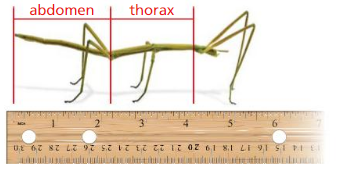
Answer:
Length of abdomen is 2\(\frac{1}{4}\) inches,
The thorax is about 1\(\frac{3}{4}\) inches,
The abdomen is \(\frac{1}{2}\) inch longer than thorax,
1\(\frac{2}{7}\) inch times longer is its abdomen than its thorax,
Explanation:

Question 26.
MODELING WITH MATHEMATICS
In 2003, a remote-controlled model airplane became the first-ever to fly nonstop across the Atlantic Ocean. The map shows the airplane’s position at three different points during its flight. Point A represents Cape Spear. New foundland. point B represents the approximate position after 1 day, and point C represents Mannin Bay’ Ireland. The airplane left Cape Spear and landed in Mannin Bay.
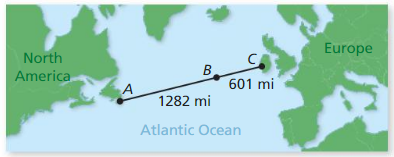
a. Find the total distance the model airplane flew.
Answer:
The total distance traveled by the model airplane is 1881 miles,
Explanation:
It is given that a remote-controlled airplane flies from Cape Spear to Mannin Bay that is located across the Atlantic Ocean, Now the total distance traveled by the model airplane is represented as the total distance from A to C on the map, From the map, AC represents the total distance traveled by the model airplane
AB represents the distance traveled by model airplane from Cape Spear and it is in flight mode after 1 day and it represents as B, BC represents the distance traveled from the middle of the flight to Mannin Bay
So now by using the Segment Addition Postulate AC = AB + BC,
So AC = 1281 miles + 601 miles,
AC = 1881 miles, We can conclude that the total distance traveled by the model airplane is 1881 miles.
b. The model airplane’s flight lasted nearly 38 hours. Estimate the airplane’s average speed in miles per hour.
Answer:
The average speed of the airplane is 49.5 miles per hour,
Explanation:
From part (a) we observed that the total distance traveled by the model airplane is 1881 miles,
It is given that the model airplane’s flight lasted nearly 38 hours, We know that Average speed = \(\frac{Total distance}{Total time}\), So Average speed = \(\frac{1881}{38}\) = 49.5 miles per hour, Hence, from the above we can conclude that the average speed of the airplane is 49.5 miles per hour.
Question 27.
USING STRUCTURE
Determine whether the statements are true or False. Explain your reasoning.

a. B is between A and C.
b. C is between B and E.
c. D is between A and H.
d. E is between C and F.
Answer:
a. True,
b. False,
c. True,
d. False,
Explanation:
Collinear points are a set of three or more points that exist on the same straight line,

Question 28.
MATHEMATICAL CONNECTIONS
Write an expression for the length of the segment.
a. \(\overline{A C}\)

Answer:
Line segment = (8x – 1),
Explanation:
The given line segment is

So by using the Segment Addition Postulate \(\overline{A C}\) = \(\overline{A B}\) + \(\overline{B C}\),
\(\overline{A C}\) = (x + 2) + (7x – 3),
\(\overline{A C}\) = 8x – 1,
Hence from the above we can conclude that the expression of the given line segment is (8x – 1).
b. \(\overline{Q R}\)

Answer:
Line segment = (5y + 20),
Explanation:
The given line segment is

So by using the Segment Addition Postulate \(\overline{P R}\) = \(\overline{P Q}\) + \(\overline{Q R}\), 13y + 25 = (8y + 5) + \(\overline{Q R}\),
\(\overline{Q R}\) = 13y + 25 – 8y – 5,
\(\overline{Q R}\) = 5y + 20,
Hence we can conclude that the expression of the given line segment is (5y + 20).
Question 29.
MATHEMATICAL CONNECTIONS
Point S is between points R and T on \(\overline{R T}\). Use the information to write an equation in term of x. Then Solve the equation and find RS, ST, and RT.
a. RS = 2x + 10
ST = x – 4
RT = 21
b. RS = 3x – 16
ST = 4x – 8
RT = 60
c. RS = 4x – 9
ST=11
RT = x + 10
d. RS = 4x – 9
ST = 19
RT = 8x – 14
Answer:
a. x =5, RS = 20, ST = 1, RT = 21,
b. x = 12, RS = 20, ST = 40, RT = 60,
c. x = 7, RS = 6, ST = 11, RT= 17,
d. x = 6, RS = 15, ST = 19, RT = 34,
Explanation:
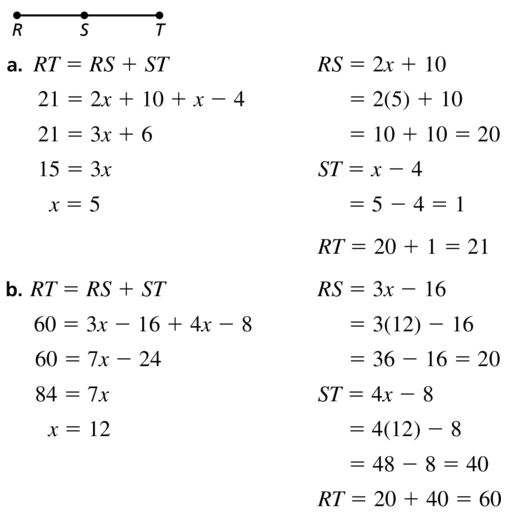
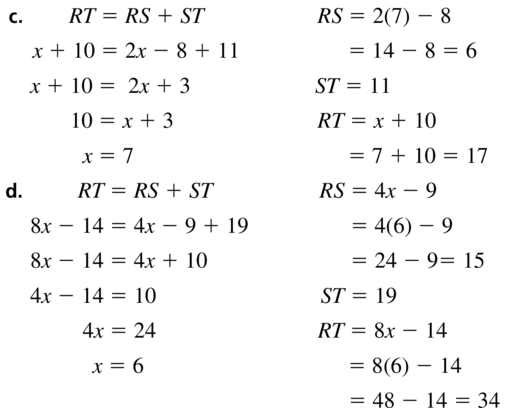
Question 30.
THOUGHT-PROVOKING
Is it possible to design a table where no two legs have the same length? Assume that the endpoints of the legs must all lie in the same plane. Include a diagram as part o! your answer.
Answer:
Yes,
Explanation:
Yes it is possible to design a table where no two legs have the same length and that the endpoints of the legs all lie in the same plane. They just have to be attached to the table at different angles as seen in the below figure:
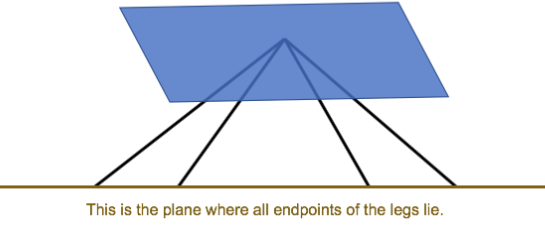
Question 31.
MODELING WITH MATHEMATICS
You have w walk from Room 103 to Room 117.
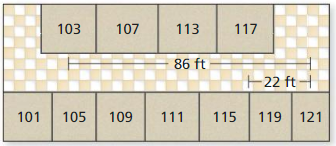
a. How many feet do you travel from Room 103 to Room 117?
b. You can walk 4.4 feet per second. How many minutes will it take you to get to Room 117?
c. Why might it take you longer than the time in Part (b)?
Answer:
a. 64 ft,
b. 0.24 min,
c. Walked slower,
Explanation:

Question 32.
MAKING AN ARGUMENT
Your friend and your Cousin discuss measuring with a ruler. Your friend says that you must always line up objects at the zero on a ruler. Your cousin says it does not matter. Decide who is correct and explain your reasoning.
Answer:
My cousin is correct,
Explanation:
It is given that my friend said that I must always line up objects at the zero on a ruler and your cousin said that it does not matter. Now we just have to deduce the endpoint length from the start point length on the ruler Example: If you measure a segment that is 5 cm long, it is the same if you put zero on the start point or 5 on the start point, then 10 is on the endpoint, Remembering that the starting point will be any number on the ruler and the ending point will be n units away from that number, So, 5 – 0 = 5 is same as 10 – 5 = 5.
Question 33.
REASONING
You travel twin City X to City Y. You know that the round-trip distance is 647 miles. City Z, a city you pass on the way, is 27 miles from City X. Find the distance from City Z to City Y. Justify your answer.
Answer:
The distance from city Z to city Y is 296.5 miles,
Explanation:
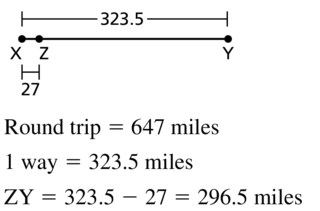
Question 34.
HOW DO YOU SEE IT?
The bar graph shows the win-loss record for a lacrosse team over a period of three years. Explain how you can apply the Ruler Postulate (Post. 1.1) and the Segment Addition Postulate (Post. 1.2) when interpreting a stacked bar graph like the one shown.

Answer:
The number of games is equal to the number of wins and the number of loss,
Explanation:
We know that Ruler Postulate: The points on a line can be put into a one-to-one correspondence (paired) with the real numbers. The distance between any two points is represented by the absolute value of the difference between the numbers.
Segment Addition Postulate: The Segment Addition Postulate states that given 2 points A and C, a third point B lies on the line segment AC if and only if the distances between the points satisfy the equation
AB + BC = AC,
Hence by using the ruler and Segment Addition Postulates we can conclude that the number of games is equal to the number of wins and the number of losses.
Question 35.
ABSTRACT REASONING
The points (a,b) and (c, b) from a segment, and the points (d, e) and (d, f ) from a segment. Create an equation assuming the segments are congruent. Are there any letters not used in the equation? Explain.
Answer:
The equation assuming the segments are congurent is |a- c| = |e – f|,
The letters not used in the equation are b and d because b – b = 0 and d – d = 0,
Explanation:
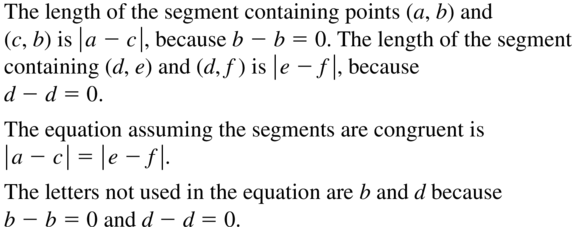
Question 36.
MATHEMATICAL CONNECTIONS
In the diagram, \(\overline{A B}\) ≅ \(\overline{B C}\), \(\overline{A C}\) ≅ \(\overline{C D}\), and AD = 12. Find the lengths of all segments in the diagram. Suppose you choose one of the segments at random. What is the probability that the measure of the segment is greater than 3? Explain your reasoning.

Answer:
The probability of getting the length of the line segments greater than 3 is 0.5,
Explanation:
The given figure is

It is given that \(\overline{A B}\) ≅ \(\overline{B C}\),
\(\overline{A C}\) ≅ \(\overline{C D}\),
\(\overline{A D}\) = 12,
Now by using the Segment Addition Postulate
AD = AB + BC + CD,
12 = AB + BC + CD, Now AD = AC + CD,
AD = 2CD,
CD = \(\frac{12}{2}\),
CD = 6, So AC = 6, Now from the given line segment AC = AB + BC,
AC = 2BC,
BC = \(\frac{6}{2}\),
BC = 3, Hence AB = 3, Now we know that probability = \(\frac{The number of favorable cases}{The total number of cases}\). So the probability of getting the segment that the length is greater than 3 is
P = \(\frac{The number of segments that the length is greater than 3}{The number of total segments}\),P = 3 / 6 , P = 0.5 Hence we can conclude that the probability of getting the length of the line segments greater than 3 is 0.5.
Question 37.
CRITICAL THINKING
Is it possible to use the Segment Addition Postulate (Post. 1.2) to show FB > CB or that AC > DB? Explain your reasoning.

Answer:
Yes,
Explanation:
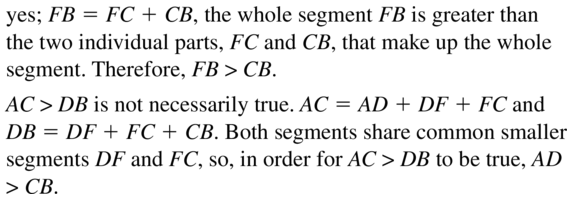
Maintaining Mathematical Proficiency
Simplify.
Question 38.
\(\frac{-4+6}{2}\)
Answer:
The value of the given expression is 1,
Explanation:
The given expression is: \(\frac{-6 + 4}{2}\)
So \(\frac{-4+6}{2}\) = \(\frac{2}{2}\),
= \(\frac{1}{1}\) = 1. Hence from the above we can conclude that the value of the given expression is 1.
Question 39.
\(\sqrt{20+5}\)
Answer:
5,
Explanation:
solving 
Question 40.
\(\sqrt{25+9}\)
Answer:
\(\sqrt{34}\),
Explanation:
The given expression is: \(\sqrt{25 + 9}\),
\(\sqrt{25+9}\) = \(\sqrt{34}\),
Hence from the above we can conclude that the value of the given expression is \(\sqrt{34}\).
Question 41.
\(\frac{7+6}{2}\)
Answer:
\(\frac{13}{2}\),
Explanation:

Solve the equation.
Question 42.
5x + 7 = 9x – 17
Answer:
6,
Explanation:
The given equation is 5x + 7 = 9x – 17
So 5x – 9x = -17 – 7,
-4x = -24,
4x = 24,
x = \(\frac{24}{4}\),
x = 6, we can conclude that the value of x for the given equation is 6,
Question 43.
\(\frac{3+y}{2}=6\) = 6
Answer:
y = 9,
Explanation:
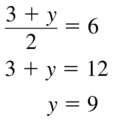
Question 44.
\(\frac{-5+x}{2}\) = – 9
Answer:
x = -13,
Explanation:
The given equation is \(\frac{-5+x}{2}\) = – 9,
So -5 + x = -9 (2),
-5 + x = -18,
x = -18 + 5,
x = -13,
We can conclude that the value of x for the given equation is -13.
Question 45.
– 6x – 13 = – x = 23
Answer:
x = 2,
Explanation:
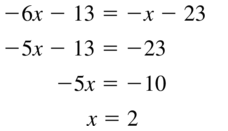
1.3 Using Midpoint and Distance Formulas
EssentiaI Question
How can you find the midpoint and length of a line segment in a coordinate plane?
Answer:
The coordinates of the midpoint of the line segment are M = (\(\frac{x1 + x2}{2}\), \(\frac{y1 + y2}{2}\)), The length of the line segment in a coordinate plane is D = \(\sqrt{(x2 – x1)² + (y2 – y1)²}\),
Explanation:
Let the line segment is formed by the points A (x1, y1), B (x2, y2)
So, the coordinates of the midpoint of the line segment are given as
M = (\(\frac{x1 + x2}{2}\), \(\frac{y1 + y2}{2}\)),
The length of the line segment in a coordinate plane is given as D = \(\sqrt{(x2 – x1)² + (y2 – y1)²}\).
Exploration 1
Finding the Midpoint of a Line Segment
Work with a partner.
Use centimeter graph paper.

a. Graph \(\overline{A B}\), where the points A and B are as shown.
Answer:
D = 10 cm,
Explanation:
From the given graph the given points are: A (3, 4), B (-5, -2),
Comparing the given points with A (x1, y1), B (x2, y2)
So the distance between points A and B is given as
D = \(\sqrt{(x2 – x1)² + (y2 – y1)²}\),
D = \(\sqrt{(-5 – 3)² + (-2 – 4)²}\),
D = \(\sqrt{(-8)² + (-6)²}\),
D = \(\sqrt{64 + 36}\),
D = \(\sqrt{100}\)
D = 10 cm, Hence, from the above, We can conclude that the length of \(\overline{A B}\) is 10cm,
The representation of \(\overline{A B}\) is:

b. Explain how to bisect \(\overline{A B}\), that is, to divide AB into two congruent line segments. Then bisects \(\overline{A B}\) and use the result to find the midpoint M of \(\overline{A B}\).
Answer:

The steps to find the bisector of \(\overline{A B}\) is:
a. Place the compass at one end of the line segment
b. Adjust the compass to slightly longer than half of the line segment length
c. Draw arcs above and below the line
d. Keeping the same compass width, draw arcs from the other end of line
e. Place ruler where the arcs cross and draw the line segment,
The midpoint of \(\overline{A B}\) is 5 cm,
Explanation:
The steps to find the bisector of \(\overline{A B}\) is:
a. Place the compass at one end of the line segment
b. Adjust the compass to slightly longer than half of the line segment length
c. Draw arcs above and below the line
d. Keeping the same compass width, draw arcs from the other end of line
e. Place ruler where the arcs cross and draw the line segment
Now, From part (a) the representation of \(\overline{A B}\) is

Now the representation of the perpendicular bisector and the midpoint M of \(\overline{A B}\) is

Hence from the above figure the midpoint of \(\overline{A B}\) is 5 cm.
c. What are the coordinates of the midpoint M?
Answer:
(-1, 1),
Explanation:
We know that the coordinates of the midpoint of the line segment are given as
M = (\(\frac{x1 + x2}{2}\), \(\frac{y1 + y2}{2}\)),
So M = (\(\frac{3 – 5}{2}\),\(\frac{4 – 2}{2}\)),
M = (\(\frac{-2}{2}\),\(\frac{2}{2}\)),
M = (-1, 1), Hence the coordinates of the midpoint M is (-1, 1).
d. Compare the x-coordinates of A, B, and M. Compare the y-coordinates of A, B, and M. How arc the coordinates of the 4 midpoints M related to the coordinates of A and B?
Answer:
M= (\(\frac{x1 + x2}{2}\), \(\frac{y1 + y2}{2}\),
Explanation:
The coordinates of A, B, and M are: A (3, 4), B (-5, -2), and M (-1, 1),
Compare the given coordinates with A (x1, y1), B (x2, y2), C (x3, y3),
Hence, The x-coordinates and y-coordinates of M are related to the coordinates of A and B are:
M= (\(\frac{x1 + x2}{2}\), \(\frac{y1 + y2}{2}\).
Exploration 2
Finding the Length of a Line Segment work with a partner. Use centimeter graph paper.
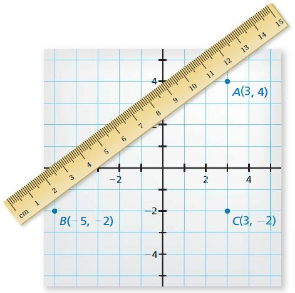
a. Add point C to your graph as shown.
Answer:
C : (1, 5),
Explanation:
From the graph the given points are A (3, 4), B (-5, -2), and C (3, 2),
Comparing the given points with A (x1, y1), B (x2, y2), and C (x3, y3)
So, the coordinates of the length between points A and B is D = ( |x2 + x1|, |y2 + y1| ),
So D = ( |-5 + 3|, |-2 + 4| ),
D = ( |-2|, |2| ),
D = (-2, 2),
Now, The length between AB and C is D = ( |x2 + x1|, |y2 + y1| ),
So, D = ( |-2 + 3|, |2 + 3| )
D = (|1|, |5|),
D = (1, 5), We can conclude that the coordinates of the total length by adding point C is (1, 5).
b. Use the Pythagorean Theorem to find the length of AB.
Answer:
The length of AB is \(\sqrt{8}\),
Explanation:
The given points are A (3, 4), B (-5, -2), and C (3, 2),
Comparing the given points with A (x1, y1), B (x2, y2), and C (x3, y3),
We know that the length of a segment is D = \(\sqrt{(x2 – x1)² + (y2 – y1)²}\),
So \(\overline{B C}\) = \(\sqrt{(-5 + 3)² + (-2 + 2)²}\),
= \(\sqrt{(-2)² + (0)²}\),
= \(\sqrt{4 + 0}\),
=\(\sqrt{4}\) = 2,
\(\overline{A C}\) = \(\sqrt{(-3 + 3)² + (-2 + 4)²}\),
= \(\sqrt{0² + 2²}\),
= \(\sqrt{2²}\) = 2,
Now according to Pythagoras theorem Hypotenuse² = Side² + Side²,
So from the graph AB represents the hypotenuse, AC represents the side, BC represents the side
So AB² = AC² + BC²,
AB² = 2² + 2²,
AB² = 4 + 4,
AB² = 8,
AB = \(\sqrt{8}\), We can conclude that the length of AB is \(\sqrt{8}\).
c. Use a centimeter ruler to verify the length you found in part (b).
MAKING SENSE OF PROBLEMS
To be proficient in math, you need to check your answers and continually ask yourself, “Does this make sense?’
Answer:
Yes it makes sense the length of AB is: \(\sqrt{8}\),
Explanation:
From part (b), We found the length of \(\overline{A B}\) as: \(\sqrt{8}\),,
Now, To verify the length of \(\overline{A B}\), use the “Distance formula”,
We know that the distance beween 2 points of a line segment is given as D = \(\sqrt{(x2 – x1)² + (y2 – y1)²}\), So \(\overline{A B}\) = \(\sqrt{(-5 + 3)² + (-2 + 4)²}\),
= \(\sqrt{(-2)² + (2)²}\),
= \(\sqrt{4 + 4}\),
=\(\sqrt{8}\) it makes sense.
d. Use the Pythagorean Theorem and point M from Exploration 1 to find the lengths of \(\overline{A M}\) and \(\overline{M B}\). What can you conclude?
Answer:
Communicate Your Answer
Question 3.
How can you find the midpoint and length of a line segment in a coordinate plane?
Answer:
The coordinates of the midpoint of the line segment are M = (\(\frac{x1 + x2}{2}\), \(\frac{y1 + y2}{2}\)), The length of the line segment in a coordinate plane is given as D = \(\sqrt{(x2 – x1)² + (y2 – y1)²}\),
Explanation:
Let the line segment is formed by the points A (x1, y1), B (x2, y2), So the coordinates of the midpoint of the line segment are given as M = (\(\frac{x1 + x2}{2}\), \(\frac{y1 + y2}{2}\)) and
The length of the line segment in a coordinate plane is given as D = \(\sqrt{(x2 – x1)² + (y2 – y1)²}\).
Question 4.
Find the coordinates of the midpoint M and the length of the line segment whose endpoints are given.
a. D(- 10, – 4), E(14, 6)
Answer:
The midpoint of the given points are (2, 1),,
Explanation:
The given points are D (-10, -4), E (14, 6)
We know that the coordinates of the midpoint of the line segment are given as M = (\(\frac{x1 + x2}{2}\), \(\frac{y1 + y2}{2}\)), So
M = (\(\frac{x1 + x2}{2}\), \(\frac{y1 + y2}{2}\)),
M = (\(\frac{14 – 10}{2}\), \(\frac{6 – 4}{2}\)),
M = (\(\frac{4}{2}\), \(\frac{2}{2}\)),
M = (2, 1), We can conclude that the coordinates of the midpoint of the given points are (2, 1).
b. F(- 4, 8), G(9, 0)
Answer:
The midpoint of the given points are (\(\frac{5}{2}\), 4),
Explanation:
The given points are F (-4, 8), G (9, 0)
We know that M = (\(\frac{x1 + x2}{2}\), \(\frac{y1 + y2}{2}\)),
So M = (\(\frac{9 – 4}{2}\), \(\frac{8 + 0}{2}\)),
M = (\(\frac{5}{2}\), \(\frac{8}{2}\)),
M = (\(\frac{5}{2}\), 4), We can conclude that the coordinates of the midpoint of the given points are (\(\frac{5}{2}\), 4).
Lesson 1.3 Using Midpoint and Distance Formulas
Monitoring Progress
Identify the segment, bisector of \(\overline{P Q}\). Then find PQ.
Question 1.

Answer:
The length of \(\overline{p Q} \) is \(\frac{15}{4}\),
Explanation:
The given line segment is

We know that a segment has a starting point and an ending point, So from the above figure,
We can observe that \(\overline{P Q}\) is a “Segment”, We know that,
A “Bisector” is a line that divides a line segment into two congruent (or) equal parts, So, From the above figure, We can observe that the bisector of \(\overline{P Q}\) is: MN
Now, From the above figure the bisector divided the given line segment into 2 equal parts and given the length of 1 part. So, It is given that \(\overline{P M}\) = 1\(\frac{7}{8}\),
Hence the length of \(\overline{P Q}\) = \(\overline{P M}\) + \(\overline{M Q}\)
= 2 × 1\(\frac{7}{8}\)
= 2 × \(\frac{15}{8}\)
= \(\frac{2}{1}\) × \(\frac{15}{8}\)
= \(\frac{15}{4}\), Hence, from the above we can conclude that the length of \(\overline{p Q} \) is \(\frac{15}{4}\).
Question 2.

Answer:
The length of \(\overline{P Q} \) is \(\frac{32}{7}\),
Explanation:
The given line segment is

We know that a segment has a starting point and an ending point, So, From the above figure,
We can observe that \(\overline{P Q}\) is a “Segment”, We know that,
A “Bisector” is a line that divides a line segment into two congruent (or) equal parts
So, From the above figure we can observe that the bisector of \(\overline{P Q}\) is: M
Now,From the above figure, The bisector divided the given line segment into 2 equal parts and given the length of 1 part, So, It is given that \(\overline{M Q}\) = 2\(\frac{2}{7}\).
Hence the length of \(\overline{P Q}\) = \(\overline{P M}\) + \(\overline{M Q}\)
= 2 × 2\(\frac{2}{7}\),
= 2 × \(\frac{16}{7}\),
= \(\frac{2}{1}\) × \(\frac{16}{7}\),
= \(\frac{32}{7}\),
We can conclude that the length of \(\overline{P Q} \) is \(\frac{32}{7}\).
Question 3.
Identify the segment bisector of \(\overline{P Q}\). Then find MQ.

Answer:
MQ = 7,
Explanation:
The given figure is

We know that a “Bisector” is a line that divides a line segment into 2 congruent (or) equal parts, So, The bisector of \(\overline{P Q}\) is: line l, We know that due to a bisector in \(\overline{P Q}\), \(\overline{P M}\) = \(\overline{M Q}\),
So 5x – 3 = 11 – 2x,
5x + 2x = 11 + 3,
7x = 14,
x = \(\frac{14}{7}\),
x = 2, So MQ = 11 – 2x,
MQ = 11 – 2 (2),
MQ = 11 – 4,
MQ = 7, We can conclude that the value of MQ is 7.
Question 4.
Identify the segment bisector or \(\overline{R S}\). Then find RS.

Answer:
Question 5.
The endpoints of \(\overline{A B}\) are A (1, 2) and B(7, 8). Find the coordinates of the midpoint M.
Answer:
The midpoint of \(\overline{A B}\) are (4, 5),
Explanation:
The given endpoints of \(\overline{A B}\) are A (1, 2), B (7, 8),
We know that M = (\(\frac{x1 + x2}{2}\), \(\frac{y1 + y2}{2}\)),
So M = (\(\frac{1 + 7}{2}\), \(\frac{8 + 2}{2}\)),
M = (\(\frac{8}{2}\), \(\frac{10}{2}\)), M = (4, 5),
We can conclude that the coordinates of the midpoint of \(\overline{A B}\) are (4, 5).
Question 6.
The endpoints of \(\overline{C D}\) are C( – 4, 3) and D(6, 5). Find the coordinates of the midpoint M.
Answer:
The midpoint of \(\overline{C D}\) are (1, 4),
Explanation:
The given endpoints of \(\overline{C D}\) are C (-4, 3), D (6, 5)
We know that M = (\(\frac{x1 + x2}{2}\), \(\frac{y1 + y2}{2}\)),
So M = (\(\frac{6 – 4}{2}\), \(\frac{5 + 3}{2}\)),
M = (\(\frac{2}{2}\), \(\frac{8}{2}\)),
M = (1, 4), Hence, from the above we can conclude that the coordinates of the midpoint of \(\overline{C D}\) are (1, 4).
Question 7.
The midpoint of \(\overline{T U}\) is M(2, 4). One endpoint is T(1, 1). Find the coordinates of endpoint U.
Answer:
The other endpoint of \(\overline{T U}\) is (3, 7),
Explanation:
The given points of \(\overline{T U}\) are M (2, 4), T (1, 1),
Let the one endpoint be T we know that M = (\(\frac{x1 + x2}{2}\), \(\frac{y1 + y2}{2}\))
So (2, 4) = (\(\frac{x1 + 1}{2}\), \(\frac{y1 + 1}{2}\)), So,
\(\frac{x1 + 1}{2}\) = 2 \(\frac{y1 + 1}{2}\) = 4
x1 + 1 = 2 (2) y1 + 1 = 4 (2)
x1 = 4 – 1 y1 = 8 – 1
x1 = 3 y1 = 7
Hence, from the above we can conclude that the other endpoint of \(\overline{T U}\) is (3, 7).
Question 8.
The midpoint of \(\overline{V W}\) is M (- 1, – 2). One endpoint is W(4, 4). Find the coordinates of endpoint V.
Answer:
The other endpoint V is: (-6, -8),
Explanation:
The given points of \(\overline{V W}\) are M (-1, -2), W (4, 4),
We know that M = (\(\frac{x1 + x2}{2}\), \(\frac{y1 + y2}{2}\)),
So (-1, -2) = (\(\frac{x1 + 4}{2}\), \(\frac{y1 + 4}{2}\)),
\(\frac{x1 + 4}{2}\) = -1 \(\frac{y1 + 4}{2}\) = -2
x1 + 4 = -1 (2) y1 + 4 = -2 (2)
x1 = -2 – 4 y1 = -4 – 4
x1 = -6 y1 = -8
Hence, from the above we can conclude that the other endpoint V is (-6, -8).
Question 9.
In Example 4, a park is 3 miles east and 4 miles south of your apartment. Find the distance between the park and your school.
Answer:
Exercise 1.3 Using Midpoint and Distance Formulas
Question 1.
VOCABULARY
If a point ray, line, line segment, or plane intersects a segment at its midpoint, then what does it do to the segment?
Answer:
It divides into two equal parts,
Explanation:

Question 2.
COMPLETE THE SENTENCE
To find the length of \(\overline{A B}\), with endpoints A(- 7, 5) and B(4, – 6). you can use the _________ .
Answer:
“Distance Formula”,
Explanation:
We know that to find the length with two endpoints, we use the “Distance formula”
The distance between the 2 endpoints is given as: D = \(\sqrt{(x2 – x1)² + (y2 – y1)²}\), Hence from the above we can conclude that to find the length of \(\overline{A B}\) with endpoints A(- 7, 5) and B(4, – 6) we can use the “Distance formula”.
Monitoring Progress and Modeling with Mathematics
In Exercises 3 – 6. identify the segment bisector of \(\overline{R S}\). Then find RS.
Question 3.

Answer:
RS = 34,
Explanation:

Question 4.

Answer:
RS =18,
Explanation:
The given line segment is

We know that a “Bisector” is a line that divides a line segment into 2 equal parts, So the bisector of \(\overline{R S}\) is: line A, From the given figure, It is given that \(\overline{M S}\) = 9,
Hence \(\overline{R S}\) = 9 (2),
\(\overline{R S}\) = 18, Hence from the above we can conclude that the length of \(\overline{R S}\) is 18.
Question 5.

Answer:
RS = 44,
Explanation:

Question 6.

Answer:
RS = 24,
Explanation:
The given line segment is

We know that a “Bisector” is a line that divides a line segment into 2 equal parts,
So the bisector of \(\overline{R S}\) is: line s, From the given figure it is given that
\(\overline{R M}\) = 12, Hence \(\overline{R S}\) = 12 (2),
\(\overline{R S}\) = 24, Hence, from the above we can conclude that the length of \(\overline{R S}\) is 24.
In Exercises 7 and 8, identify the segment bisector of \(\overline{J K}\). Then find JM.
Question 7.

Answer:
JM = 40,
Explanation:
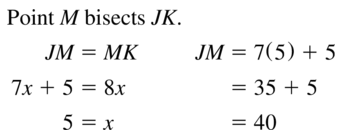
Question 8.
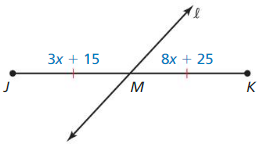
Answer:
JM = 9,
Explanation:
The given line segment is

From the above figure a “Bisector” is a line that divides a line segment into 2 equal parts,
So the bisector of \(\overline{J K}\) is: line l, Since the 2 parts are equal
\(\overline{J M}\) = \(\overline{M K}\),
So 3x + 15 = 8x + 25,
3x – 8x = 25 – 15,
-5x = 10,
x = \(\frac{10}{-5}\),
x = -2,
So JM = 3x + 15,
JM = 3 (-2) + 15,
JM = -6 + 15,
JM = 9, We can conclude that the length of JM is 9.
In Exercises 9 and 10. identify the segment bisector of \(\overline{X Y}\). Then find XY.
Question 9.

Answer:
XY = 32,
Explanation:
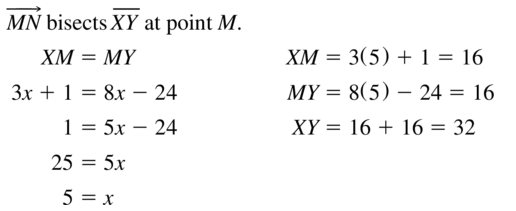
Question 10.
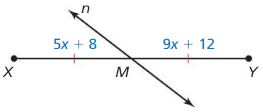
Answer:
XY = 6,
Explanation:
The given line segment is

From the above figurem a “Bisector” is a line that divides a line segment into 2 equal parts,
So the bisector of \(\overline{X Y}\) is: line n, Since the 2 parts are equal
\(\overline{X M}\) = \(\overline{M Y}\),
So 5x + 8 = 9x + 12,
5x – 9x = 12 – 8,
-4x = 4,
x = \(\frac{-4}{4}\),
x = -1, So XY = XM + MY,
XY = 5x + 8 + 9x + 12,
XY = 14x + 20,
XY = 14 (-1) + 20,
XY = 20 – 14,
XY = 6, Hence from the above we can conclude that the length of XY is 6.
CONSTRUCTION
In Exercises 11 – 14, copy the segment and construct a segment bisector by paper folding. Then label the midpoint M.
Question 11.

Answer:

Explanation:
Copied the segment and constructed a segment bisector by paper folding. Then labeled the midpoint M above.
Question 12.

Answer:

Explanation:
The given line segment is

We know that a “Bisector” is a line or point that divides a line segment into 2 equal parts,
Hence the representation of the bisector along with midpoint M of the given segment is

Question 13.

Answer:

Explanation:
Copied the segment and constructed a segment bisector by paper folding. Then labeled the midpoint M above.
Question 14.

Answer:
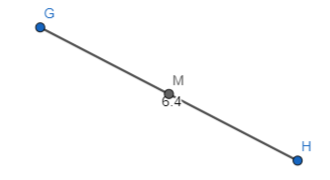
Explanation:
The given line segment is

We know that a “Bisector” is a line or point that divides a line segment into 2 equal parts.
Hence the representation of the bisector along with midpoint M of the given segment is

In Exercises 15 – 18, the endpoints of \(\overline{C D}\) are given. Find the coordinates of the midpoint M.
Question 15.
C (3, – 5) and D (7, 9)
Answer:
M = (5,2),
Explanation:
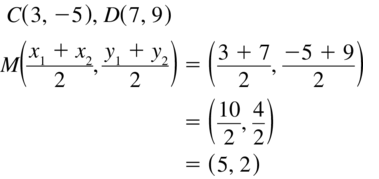
Question 16.
C (4, 7) and D (0, – 3)
Answer:
The coordinates of the midpoint of \(\overline{C D}\) are (2, 2),
Explanation:
The given endpoints of \(\overline{C D}\) are C (4, 7), D (0, -3),
We know that M = (\(\frac{x1 + x2}{2}\), \(\frac{y1 + y2}{2}\))
So M = (\(\frac{4 + 0}{2}\), \(\frac{7 – 3}{2}\)),
M = (\(\frac{4}{2}\), \(\frac{4}{2}\)),
M = (2, 2), We can conclude that the coordinates of the midpoint of \(\overline{C D}\) are (2, 2).
Question 17.
C (- 2, 0) and D (4, 9)
Answer:
M = (1, 9/2),
Explanation:
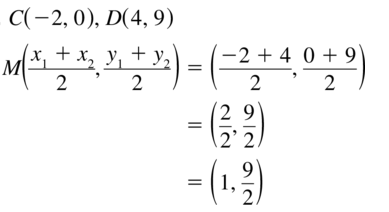
Question 18.
C (- 8, – 6) and D (- 4, 10)
Answer:
The coordinates of the midpoint of \(\overline{C D}\) are (-6, 2),
Explanation:
The given endpoints of \(\overline{C D}\) are C (-8, -6), D (-4, 10),
We know that M = (\(\frac{x1 + x2}{2}\), \(\frac{y1 + y2}{2}\)),
So M = (\(\frac{-8 – 4}{2}\), \(\frac{10 – 6}{2}\)),
M = (\(\frac{-12}{2}\), \(\frac{4}{2}\)),
M = (-6, 2), Hence, from the above we can conclude that the coordinates of the midpoint of \(\overline{C D}\) are (-6, 2).
In Exercises 19 – 22. the midpoint M and one endpoint of \(\overline{G H}\) are given. Find the coordinates of the other endpoint.
Question 19.
G (5, – 6) and M (4, 3)
Answer:
H = (3, 12),
Explanation:
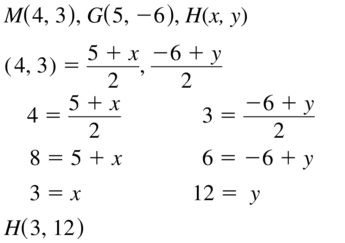
Question 20.
H (- 3, 7) and M (- 2, 5)
Answer:
G = (-7,3),
Explanation:
The given points of \(\overline{G H}\) are M (-2, 5), H (-3, 7),
Let the point G be: (x1, y1), We know that M = (\(\frac{x1 + x2}{2}\), \(\frac{y1 + y2}{2}\)),
So (-2, 5) = (\(\frac{x1 -3}{2}\), \(\frac{y1 + 7}{2}\)),
So,
\(\frac{x1 – 3}{2}\) = -2 \(\frac{y1 + 7}{2}\) = 5
x1 – 3 = -2 (2) y1 + 7 = 5 (2)
x1 = -4 – 3 y1 = 10 – 7
x1 = -7 y1 = 3
Hence, from the above, We can conclude that the other endpoint G is (-7, 3).
Question 21.
H ( – 2, 9) and M(8, 0)
Answer:
G = (18, -9),
Explanation:
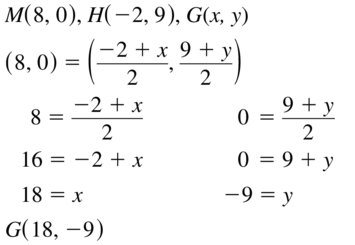
Question 22.
G (- 4, 1) and M (- \(\frac{13}{2}\), – 6)
Answer:
The other endpoint H is (-9, -13),
Explanation:
The given points of \(\overline{G H}\) are M (- \(\frac{13}{2}\), – 6), G (-4, 1),
Let the other endpoint be H (x2, y2), We know that M = (\(\frac{x1 + x2}{2}\), \(\frac{y1 + y2}{2}\)), (- \(\frac{13}{2}\), – 6) = (\(\frac{x2 – 4}{2}\), \(\frac{y2 + 1}{2}\)),
So,
\(\frac{x2 – 4}{2}\) = – \(\frac{13}{2}\) \(\frac{y2 + 1}{2}\) = -6
x2 – 4 = – \(\frac{13}{2}\) (2) y2 + 1 = -6 (2)
x1 = -13 + 4 y2 = -12 – 1
x1 = -9 y1 = -13
Hence, from the above we can conclude that the other endpoint H is (-9, -13).
In Exercises 23 – 30, find the distance between the two points.
Question 23.
A (13, 2) and B (7, 10)
Answer:
The distance between the two points is 10,
Explanation:
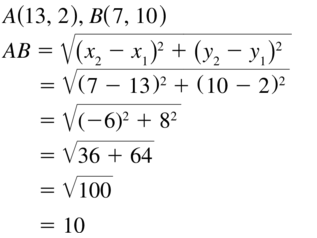
Question 24.
C (- 6, 5) and D (- 3, 1)
Answer:
The distance between the two points is 5,
Explanation:
The given points are C (-6, 5), D (-3, 1),
Compare the given points with A (x1, y1), B (x2, y2),
So the distance between points C and D is given as: D = \(\sqrt{(x2 – x1)² + (y2 – y1)²}\),
D = \(\sqrt{(6 – 3)² + (1 – 5)²}\),
D = \(\sqrt{(3)² + (-4)²}\),
D = \(\sqrt{9 + 16}\),
D = \(\sqrt{25}\)
D = 5, Hence, from the above we can conclude that the distance between 2 given points is 5.
Question 25.
E (3, 7) and F (6, 5)
Answer:
The distance between the two points is approximately 3.6,
Explanation:
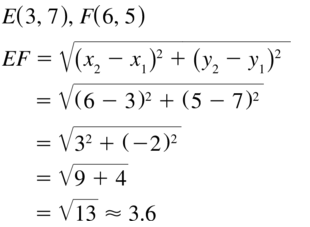
Question 26.
G (- 5, 4) and H (2, 6)
Answer:
\(\sqrt{53}\),
Explanation:
The given points are G (-5, 4), H (2, 6),
Comparing the given points with A (x1, y1), B (x2, y2),
So the distance between points A and B is given as D = \(\sqrt{(x2 – x1)² + (y2 – y1)²}\),
D = \(\sqrt{(2 + 5)² + (6 – 4)²}\),
D = \(\sqrt{(7)² + (2)²}\)
D = \(\sqrt{49 + 4}\),
D = \(\sqrt{53}\),
Hence, from the above we can conclude that the distance between 2 given points is \(\sqrt{53}\).
Question 27.
J (- 8, 0) and K (1, 4)
Answer:
The distance between the two points is approximately 9.8,
Explanation:

Question 28.
L (7, – 1) and M (- 2, 4)
Answer:
The distance between the two points is \(\sqrt{106}\),
Explanation:
The given points are L (7, -1), M (-2, 4),
Comparing the given points with A (x1, y1), B (x2, y2), So the distance between points A and B is given as:
D = \(\sqrt{(x2 – x1)² + (y2 – y1)²}\),
D = \(\sqrt{(-2 – 7)² + (4 + 1)²}\),
D = \(\sqrt{(-9)² + (5)²}\),
D = \(\sqrt{81 + 25}\),
D = \(\sqrt{106}\),
Hence, from the above we can conclude that the distance between 2 given points is \(\sqrt{106}\).
Question 29.
R (0, 1) and S (6, 3.5)
Answer:
The distance between the two points is 6.5,
Explanation:
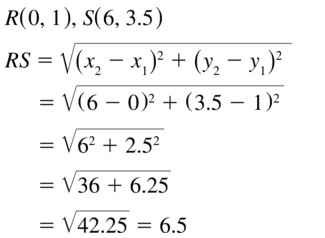
Question 30.
T (13, 1.6) and V (5.4, 3.7)
Answer:
The distance between the two points is 7.884,
Explanation:
The given points are T (13, 1.6), V (5.4, 3.7), Comparing the given points with A (x1, y1), B (x2, y2),
So the distance between points A and B is given as D = \(\sqrt{(x2 – x1)² + (y2 – y1)²}\),
D = \(\sqrt{(13 – 5.4)² + (1.6 – 3.7)²}\),
D = \(\sqrt{(7.6)² + (2.1)²}\),
D = \(\sqrt{57.76 + 4.41}\),
D = \(\sqrt{62.17}\)
D = 7.884, Hence, from the above we can conclude that the distance between 2 given points is 7.884.
ERROR ANALYSIS
In Exercises 31 and 32, describe and correct the error in finding the distance between A(6, 2) and 8(1, – 4).
Question 31.
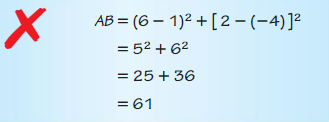
Answer:
The sqaure root should have beentaken as approximately 7.8,
Explanation:
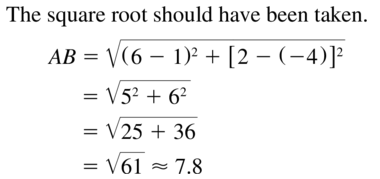
Question 32.
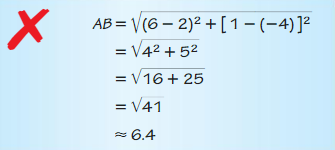
Answer:
the distance between A and B is 7.8 not 6.4,
Explanation:
In the above figure the distance between A and B is given by using the formula:
D = \(\sqrt{(x1 – y1)² + (x2 – y2)²}\), But the used formula is wrong,
Now the given points are: A (6, 2), B (1, -4),
Comparing the given points with A (x1, y1), B (x2, y2)
So the distance between points A and B is given as:
D = \(\sqrt{(x2 – x1)² + (y2 – y1)²}\),
D = \(\sqrt{(6 – 1)² + (2 + 4)²}\),
D = \(\sqrt{(5)² + (6)²}\),
D = \(\sqrt{25 + 36}\),
D = \(\sqrt{61}\),
D = 7.8, Hence from the above we can conclude that the distance between A and B is 7.8.
COMPARING SEGMENTS
In Exercises 33 and 34, the endpoints of two segments are given. Find each segment length. Tell whether the segments are congruent. If they are not congruent, a state which segment length is greater.
Question 33.
\(\overline{A B}\): A(0, 2), B(- 3, 8) and \(\overline{C D}\): C(- 2, 2), D(0, – 4)
Answer:
The segments are not congruent and AB >CD,
Explanation:

Question 34.
\(\overline{E F}\): E(1, 4),F(5, 1) and \(\overline{G H}\): G(-3, 1), H(1, 6)
Answer:
The lengths of \(\overline{E F}\) and \(\overline{G H}\) are not congruent
\(\overline{E F}\) < \(\overline{G H}\),
Explanation:
The given points of \(\overline{E F}\) are E (1, 4), F (5, 1),
Compare the given points with A (x1, y1), B (x2, y2), So the distance between points E and F is given as:
D = \(\sqrt{(x2 – x1)² + (y2 – y1)²}\), D = \(\sqrt{(5 – 1)² + (1 – 4)²}\),
D = \(\sqrt{(4)² + (-3)²}\), D = \(\sqrt{16 + 9}\), D = \(\sqrt{25}\),
D = 5, Now the given points are: G (-3, 1), H (1, 6)
Comparing the given points with A (x1, y1), B (x2, y2), So the distance between points G and H is given as:
D = \(\sqrt{(x2 – x1)² + (y2 – y1)²}\),
D = \(\sqrt{(-1 – 3)² + (1 – 6)²}\),
D = \(\sqrt{(-4)² + (-5)²}\),
D = \(\sqrt{16 + 25}\),
D = \(\sqrt{41}\),
D = 6.4, Hence from the above we can conclude that the lengths of \(\overline{E F}\) and \(\overline{G H}\) are not congruent and The comparison of the lengths is \(\overline{E F}\) < \(\overline{G H}\).
Question 35.
WRITING
Your friend is having trouble understanding the Midpoint Formula.
a. Explain how to find the midpoint when given the two endpoints in your own words.
b. Explain how to find the other endpoint when given one endpoint and the midpoint in your own words.
Answer:

Explanation:

Question 36.
PROBLEM-SOLVING
In baseball, the strike zone is the region a baseball needs to pass through for the umpire to declare it a strike when the butler does not swing. The top of the strike zone is a horizontal plane passing through the midpoint in the top of the batter’s shoulders and the top of the uniform pants when the player is in a batting stance. Find the height of T. (Note: All heights are in inches.)
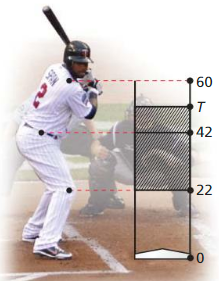
Answer:
The height of T is 51 inches,
Explanation:
It is given that the strike zone is the region a baseball needs to pass through for the umpire to declare it a strike when the butler does not swing. The top of the strike zone is a horizontal plane passing through the midpoint in the top of the batter’s shoulders and the top of the uniform pants when the player is in a batting stance.
So from the figure we can observe that the height of T lies between 60 and 42,
So, When we find the mid value of 60 and 42, we will get the height of T,
So T = \(\frac{60 + 42}{2}\),
T = \(\frac{102}{2}\),
T = 51, We can conclude that the height of T is 51 inches.
Question 37.
MODELING WITH MATHEMATICS
The figure shows the position of three players during part of a water polo match. Player A throws the ball to Player B. who then throws the ball to Player C.

a. How far did Player A throw the hail? Player B?
b. How far would Player A have to throw the ball to throw it directly to Player C?
Answer:
a. Player A threw the ball about 10.4 meters, Player B threw the ball about 9.2 meters,
b. Player A would have to throw the ball about 18.9 meters to throw it directly to Player C,
Explanation:

Question 38.
MODELING WITH MATHEMATICS
Your school is 20 blocks east and 12 blocks south of your house. The mall is 10 blocks north and 7 blocks west of our house. You plan on going to the mall right after school. Find the distance between your school and the mall assuming there is a road directly connecting the school and the mall. One block is 0.1 mile.
Answer:
The representation of the coordinates of school and Mall in the coordinate plane is:
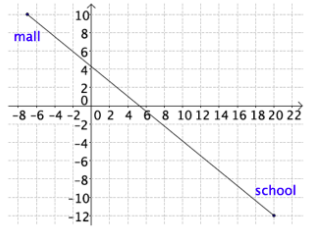
The distance between the school and the Mall is 34.8 miles,
Explanation:
From the above graph the coordinates of the school and Mall are: S (20, -12), M (-7, 10),
Comparing the given points with A (x1, y), B (x2, y2), So the distance between the schoola and Mall is given as:
SM = \(\sqrt{(x2 – x1)² + (y2 – y1)²}\),
SM = \(\sqrt{(-7 – 20)² + (10 + 12)²}\),
SM = \(\sqrt{(-27)² +(22)²}\),
SM = \(\sqrt{1213}\),
SM = 34.8 miles, Hence, from the above we can conclude that the distance between the school and the Mall is 34.8 miles.
Question 39.
PROBLEM-SOLVING
A path goes around a triangular park, as shown.
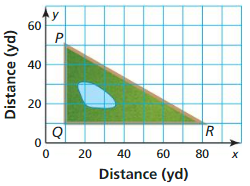
a. Find the distance around the park to the nearest yard.
b. A new path and a bridge are constructed from point Q to the midpoint M of \(\overline{P R}\). Find QM to the nearest yard.
c. A man jogs from P to Q to M Lo R to Q and back to P at an average speed of 150 yards per minute. About how many minutes does it take? Explain your reasoning.
Answer:
a. The distance around the park to the nearest yard is about 191 yards,
b. The length of QM is about 40 yards,
c. It takes the man about 1.5 minutes,
Explanation:


Question 40.
MAKING AN ARGUMENT
Your friend claims there is an easier way to find the length of a segment than the Distance Formula when the x-coordinates of the endpoints are equal. He claims all you have to do is subtract the y-coordinates. Do you agree with his statement? Explain your reasoning.
Answer:
Yes, my friend is correct,
Explanation:
Given my friend claims there is an easier way to find the length of a segment than the distance formula when the x-coordinates of the endpoints are equal. He claims all we have to do is subtract the y-coordinates.
We know that distance between 2 points = \(\sqrt{(x2 – x1)² + (y2 – y1)²}\),
It is given that the x-coordinates are equal, So x1 = x2 = 0,
Distance between 2 points = y2 – y1, Hence from the above we can conclude that your friend is correct.
Question 41.
MATHEMATICAL CONNECTIONS
Two points are located at (a, c) and (b, c). Find the midpoint and the distance between the two points.
Answer:

Explanation:

Question 42.
HOW DO YOU SEE IT?
\(\overline{A B}\) contains midpoint M and points C and D. as shown. Compare the lengths. If you cannot draw a conclusion. write impossible to tell. Explain your reasoning.
a. AM and MB
b. AC and MB
c. MC and MD
d. MB and DB
Answer:
Question 43.
ABSTRACT REASONING
Use the diagram in Exercise 42. The points on \(\overline{A B}\) represent locations you pass on your commute to work. You travel from your home at location A to location M before realizing that your left your lunch at home. You could turn around to get your lunch and then continue to work at location B. Or you could go to work and go to location D for lunch today. You want to choose the option that involves the least distance you must travel. which option should you choose? Explain your reasoning.
Answer:
Location D for lunch,
Explanation:

Question 44.
THOUGHT-PROVOKING
Describe three ways to divide a rectangle into two congruent regions. Do the regions have to he triangles? Use a diagram to support your answer.
Answer:
Case(i) : The 2 regions are rectangles,
Casr(ii) : The 2 regions are triangles,
Case(iii) : The 2 regions are squares,
Explanation:
The division of triangles into 2 congruent regions don’t have to be a triangle, Now
case (i):

In the above case, The 2 regions are rectangles,
case (ii):
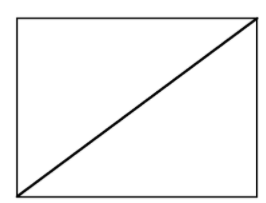
In the above case, The 2 regions are triangles,
case (iii):
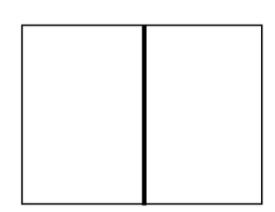
In the above case, The 2 regions are squares.
Question 45.
ANALYZING RELATIONSHIPS
The length of \(\overline{X Y}\) is 24 centimeters. The midpoint of \(\overline{X Y}\) is M. and C is on \(\overline{X M}\) so that XC is \(\frac{2}{3}\) of XM. Point D is on \(\overline{M Y}\) so that MD is \(\frac{3}{4}\) of MY. What is the length of \(\overline{C D}\)?
Answer:
The length of \(\overline{C D}\) is 13 cm,
Explanation:
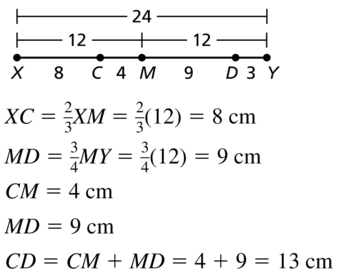
Maintaining Mathematical Proficiency
Find the perimeter and area of the figure.
Question 46.

Answer:
The perimeter of a square is 20 cm, The area of a square is: 25 cm²,
Explanation:
The given figure is

The above figure is square so we know that the perimeter of a square = 4 X Side and the area of a square = Side², From the above figure the length of the side = 5 cm, So the perimeter of a square = 4 (5) = 20 cm, The area of a square = 5² = 25 cm².
Question 47.

Answer:
The perimeter of a rectangle is 26 ft, The area of a rectangle is 30 ft²,
Explanation:

Question 48.
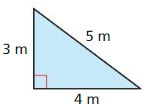
Answer:
The perimeter of triangle is 12 m, The area of triangle is 6 m²,
Explanation:
The given figure is

From the above, The given figure is triangle, We know that
The perimeter of triangle = The sum of all the sides of the given triangle,
The area of triangle = \(\frac{1}{2}\) X Base X Height,
So, The perimeter of triangle = 3 m + 4 m + 5 m = 12 m,
The area of triangle = \(\frac{1}{2}\) X 3 m X 4 m
= \(\frac{1}{2}\) X \(\frac{4}{1}\) m X 3 m
= 6 m², Hence, from the above we can conclude that the perimeter of triangle is 12 m and the area oftriangle is 6 m².
Question 49.
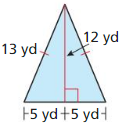
Answer:
The perimeter of triangle is 36 yd, The area of triangle is 60 yd²,
Explanation:
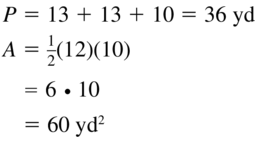
Solve the inequality. Graph the solution.
Question 50.
a + 18 < 7
Answer:
The given inequality is a < -11,

Explanation:
The given inequality is a + 18 < 7,
So, a < 7 – 18,
a < -11, Hence, from the above,
We can conclude that the solution to the given inequality is a < -11,
The representation of the solution of the given inequality in the graph is:

Question 51.
y – 5 ≥ 8
Answer:
y ≥ 13,
Explanation:
The given inequality is y – 5 ≥ 8,
y ≥ 8 + 5,
y ≥ 13 Hence, from the above,
We can conclude that the solution to the given inequality is y ≥ 13,
The representation of the solution of the given inequality in the graph is:

Question 52.
– 3x > 24
Answer:
The given inequality is x < -8,

Explanation:
Given -3x > 24 solving
x < –\(\frac{24}{3}\),
x < -8
Hence, from the above we can conclude that the solution to the given inequality is x < -8,
The representation of the solution of the given inequality in the graph is:

Question 53.
\(\frac{z}{4}\) ≤ 12
Answer:

Explanation:
Given \(\frac{z}{4}\) ≤ 12 solving
z ≤ 12 X 4,
z ≤ 48,
Hence, from the above we can conclude that the solution to the given inequality is z ≤ 48,
The representation of the solution of the given inequality in the graph is:

Study Skills: Keeping Your Mind Focused
1.1 – 1.3 What did you learn
Mathematical Practices
Question 1.
Sketch an example of the situation described in Exercise 49 on page 10. Label your figure.
Answer:

Explanation:
The representation of the example of the situation described in Exercise 49 on page 10 is as shown above.
Question 2.
Explain how you arrived at your answer for Exercise 35 on page 18.
Answer:
The distance between the 2 points = \(\sqrt{(x2 – x1)² + (y2 – y1)²}\),
Explanation:
We arrived at the answer for Exercise 35 on page 18 by using the distance formula between 2 points.
We know that the distance between the 2 points = \(\sqrt{(x2 – x1)² + (y2 – y1)²}\).
Question 3.
What assumptions did you make when solving Exercise 43 0n page 26?
Answer:
All the lengths between the 2 points in the segment are equal,
Explanation:
The assumptions we make when solving Exercise 43 on page 26 is all the lengths between the 2 points in the segment are equal.
1.1 – 1.3 Quiz
Use the diagram
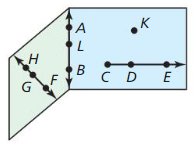
Question 1.
Name four points.
Answer:
A, L, B, and K,
Explanation:
A point is a location represented by a dot. A point does not have any length, width, shape or size, it only has a position. From the above figure the four points are: A, L, B, and K.
Question 2.
Name three collinear points.
Answer:
A, L, and B,
Explanation:
We know that the points that lie in the same line are called “Collinear points”, Hence, from the above figure, The three collinear points are: A, L, and B.
Question 3.
Name two lines.
Answer:
The lines are GHF, ALB,
Explanation:
We know that a line has a starting point but no ending point, From the above figure the lines are GHF, ALB.
Question 4.
Name three coplanar points.
Answer:
The coplanar points are: G, H, and F,
Explanation:
We know that the points that are present in the same plane are called “Co-planar points”,
Hence, from the above figure the coplanar points are: G, H, and F.
Question 5.
Name the plane that is shaded green.
Answer:
Plane GHF,
Explanation:
From the above figure the plane that is shaded green is named as Plane GHF.
Question 6.
Give two names for the plane that is shaded blue.
Answer:
Plane AKL, Plane BCD,
Explanation:
From the figure the two names for the plane that is shaded blue are: Plane AKL, Plane BCD.
Question 7.
Name three line segments.
Answer:
CD, HG, DE,
Explanation:
From the figure the 3 line segments are: CD, HG, DE.
Question 8.
Name three rays.
Answer:
Ray GHF, Ray CDE, Ray ALB,
Explanation:
From the figure the names of the 3 rays are: Ray GHF, Ray CDE, Ray ALB.
Sketch the figure described.
Question 9.
\(\vec{Q}\)R and 
Answer:
The representation of \(\vec{Q}\)R and QS is
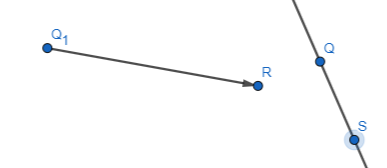
Explanation:
Sketched the fiqure \(\vec{Q}\)R and QS above.
Question 10.
plane P intersecting  at Z
at Z
Answer:
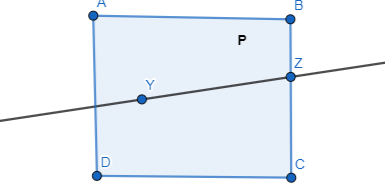
Explanation:
The representation of plane P intersecting YZ at z is shown above.
Plot the points in a coordinate plane. Then determine whether \(\overline{A B}\) and \(\overline{C D}\) are congruent.
Question 11.
A(- 3, 3), B( 1, 3), C(3, 2), D(3, – 2)
Answer:
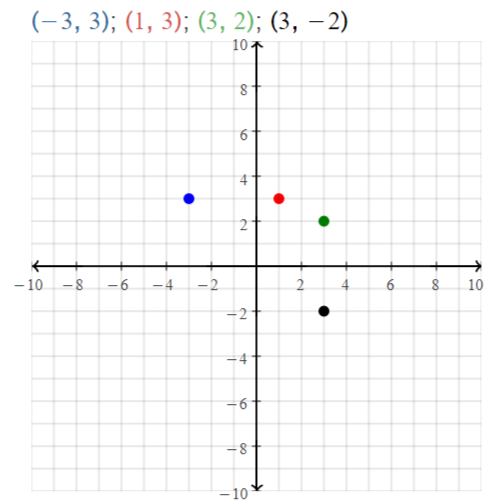
\(\overline{A B}\) is congruent to \(\overline{C D}\),
Explanation:
The given points are: A (-3, 3), B (1, 3), C (3, 2), D (3, -2),
Comparing any 2 points with (x1, y1), (x2, y2), We know that
The distance can be calculated by using D = \(\sqrt{(x2 – x1)² + (y2 – y1)²}\),
So \(\overline{A B}\) = \(\sqrt{(1 + 3)² + (3 – 3)²}\),
= \(\sqrt{(4)²}\) = 4,
\(\overline{C D}\) = \(\sqrt{(3 – 3)² + (2 + 2)²}\),
= \(\sqrt{(4)²}\) = 4,
So, from the above \(\overline{A B}\) is congruent to \(\overline{C D}\) since both the lengths are the same represented of the given points in the coordinate plane above.
Question 12.
A(- 8, 7), B(1, 7), C(- 3, – 6), D(5, – 6)
Answer:
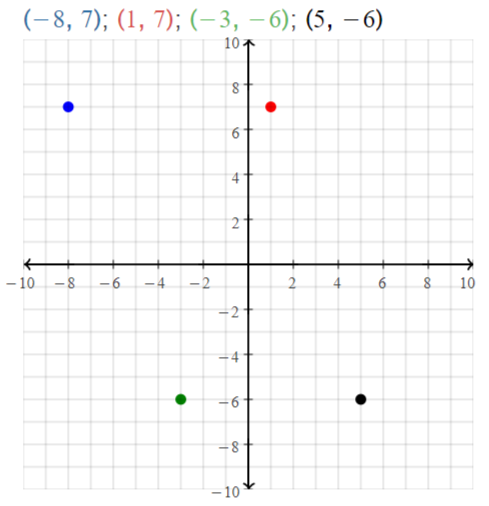
\(\overline{A B}\) is not congruent to \(\overline{C D}\),
Explanation:
The given points are A (-8, 7), B (1, 7), C (-3, -6), D (5, -6),
Comparing any 2 points with (x1, y1), (x2, y2) we know that the distance can be calculated by using:
D = \(\sqrt{(x2 – x1)² + (y2 – y1)²}\) So \(\overline{A B}\) = \(\sqrt{(1 + 8)² + (7 – 7)²}\) = \(\sqrt{(9)²}\) = 9, \(\overline{C D}\) = \(\sqrt{(5 + 3)² + (6 – 6)²}\)
= \(\sqrt{(8)²}\) = 8, So from the above
\(\overline{A B}\) is not congruent to \(\overline{C D}\) since both the lengths are not the same. Hence, from the above the representation of the given points in the coordinate plane is shown above.
Find AC. (Section 1.2)
Question 13.

Answer:
The length of \(\overline{A C}\) is 39,
Explanation:
The given line segment is:

So, From the Segment Addition Postulate
\(\overline{A C}\) = \(\overline{A B}\) + \(\overline{B C}\),
\(\overline{A C}\) = 13 + 26,
\(\overline{A C}\) = 39,
Hence, from the above we can conclude that the length of \(\overline{A C}\) is 39.
Question 14.

Answer:
The length of \(\overline{A C}\) is 51,
Explanation:
The given line segment is:

So from the Segment Addition Postulate
\(\overline{A B}\) = \(\overline{A C}\) + \(\overline{B C}\),
62 = \(\overline{A C}\) + 11,
\(\overline{A C}\) = 62 – 11,
\(\overline{A C}\) = 51,
Hence, from the above, We can conclude that the length of \(\overline{A C}\) is 51.
Find the coordinates of the midpoint M and the distance between the two points.
Question 15.
J(4, 3) and K(2, – 3)
Answer:
Midpoint M(3,0),
Explanation:
The given points are J (4, 3), K (2, -3), We know that
M = (\(\frac{x1 + x2}{2}\), \(\frac{y1 + y2}{2}\))
So M = (\(\frac{4 + 2}{2}\), \(\frac{3 – 3}{2}\)),
M = (\(\frac{6}{2}\), \(\frac{0}{2}\)),
M = (3, 0). Hence from the above we can conclude that the coordinates of the midpoint are (3, 0).
Question 16.
L(- 4, 5) and N(5, – 3)
Answer:
(\(\frac{1}{2}\), 1),
Explanation:
The given points are L (-4, 5), N (5, -3),
We know that M = (\(\frac{x1 + x2}{2}\), \(\frac{y1 + y2}{2}\)),
So M = (\(\frac{-4 + 5}{2}\), \(\frac{5 – 3}{2}\)),
M = (\(\frac{1}{2}\), \(\frac{2}{2}\)),
M = (\(\frac{1}{2}\), 1),
Hence, from the above we can conclude that the coordinates of the midpoint are (\(\frac{1}{2}\), 1).
Question 17.
P(- 6, – 1) and Q(1, 2)
Answer:
(-\(\frac{5}{2}\), \(\frac{1}{2}\)),
Explanation:
The given points are P (-6, -1), Q (1, 2),
We know that M = (\(\frac{x1 + x2}{2}\), \(\frac{y1 + y2}{2}\)),
So M = (\(\frac{-6 + 1}{2}\), \(\frac{2 – 1}{2}\)),
M = (\(\frac{-5}{2}\), \(\frac{1}{2}\)),
M = (-\(\frac{5}{2}\), \(\frac{1}{2}\)),
Hence, from the above we can conclude that the coordinates of the midpoint are: (-\(\frac{5}{2}\), \(\frac{1}{2}\)).
Question 18.
Identify the segment bisector of \(\overline{R S}\). Then find RS.

Answer:
The length of [altex]\overline{R S}[/latex] is 32,
Explanation:
The given line segment is

We know that a bisector is a point or a line that divides a line segment into 2 congruent parts
So from the above figure M is the bisector of \(\overline{R S}\),
So 6x – 2 = 3x + 7, 6x – 3x = 7 + 2, 3x = 9,
x = \(\frac{9}{3}\), x = 3,
So \(\overline{R S}\) = 6x – 2 + 3x + 7,
= 9x + 5,
= 9 (3) + 5,
= 27 + 5,
= 32, Hence from the above we can conclude that the length of [altex]\overline{R S}[/latex] is 32.
Question 19.
The midpoint of \(\overline{J K}\) is M(0, 1). One endpoint is J(- 6, 3). Find the coordinates of endpoint K.
Answer:
The other endpoint K is (12, -5),
Explanation:
The given points of \(\overline{J K}\) are M (0, 1), J (-6, 3)
Let the point G be: (x1, y1),
We know that M = (\(\frac{x1 + x2}{2}\), \(\frac{y1 + y2}{2}\)),
So (0, 1) = (\(\frac{x1 -6}{2}\), \(\frac{y1 + 3}{2}\)),
\(\frac{x1 – 6}{2}\) = 0 \(\frac{y1 + 3}{2}\) = 1
x1 – 12 = 0 (2) y1 + 7 = 1 (2)
x1 = 0 + 12 y1 = 2 – 7
x1 = 12 y1 = -5
Hence from the above we can conclude that the other endpoint K is (12, -5).
Question 20.
Your mom asks you to run some errands on your way home from school. She wants you to Stop at the post office and the grocery store, which is both on the same straight road between your school and your house. The distance from your school to the post office is 376 yards. the distance from the post office to your house is 929 yards. and the distance from the grocery store to your house is 513 yards.
a. Where should you stop first?
Answer:
At the post office,
Explanation:
It is given that my mom asks me to run some errands on your way home from school. She wants me to stop at the post office and the grocery store, which is both on the same straight road between my school and my house. Hence, from the above we can conclude that you should first stop at the post office.
b. What is the distance from the post office to the grocery store?
Answer:
The distance from the post office to the grocery store is 1442 yards,
Explanation:
It is given that the distance from your school to the post office is 376 yards, the distance from the post office to your house is 929 yards and the distance from the grocery store to your house is 513 yards.
So, the distance from the post office to the grocery store = (The distance from the post office to your house) + (The distance from the grocery store to your house) = 929 + 513,
= 1442 yards, Hence, from the above we can conclude that the distance from the post office to the grocery store is: 1442 yards.
c. What is the distance from your school to your house?
Answer:
The distance from your school to your house is 1818 yards,
Explanation:
It is given that the distance from your school to the post office is 376 yards. the distance from the post office to your house is 929 yards. and the distance from the grocery store to your house is 513 yards.
So, The distance from your school to your house = (The distance from your school to the post office) + (The distance from the post office to the grocery store),
= 376 + 1442 = 1818 yards,Hence from the above we can conclude that the distance from your school to your house is 1818 yards.
d. you walk at a speed of 75 yards per minute. How long does it take you to walk straight home from school? Explain your answer.
Answer:
The time taken for you to walk straight home from school is 24.24 minutes,
Explanation:
We know that Time = \(\frac{Distance}{Speed}\),
From part (c) the total distance is 1818 yards,
The given speed is 75 yards per minute, So Time = \(\frac{1818}{75}\),
Time = 24.24 minutes, Hence from the above we can conclude that the time taken for you to walk straight home from school is: 24.24 minutes.
Question 21.
The figure shows a coordinate plane on a baseball held. The distance from home plate to first base is 90 feet. The pitching mound is the midpoint between home plate and second base. Find the distance from home plate to second base. Find the distance between the home plate and the pitching mound. Explain how you found our answers.
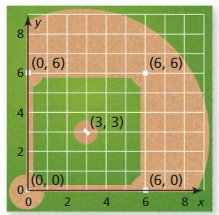
Answer:
The distance from the home plate to the second base is (0, 0),
The distance from the home plate to the pitching mound is: (3, 3),
Explanation:
From the figure the coordinates to the home plate are: (0, 0), and (0, 6), The coordinates to the second plate are: (6, 6), and (6, 0), The coordinate of the pitching mound is: (3, 3),
Now the length of the home plate is D = \(\sqrt{(x2 – x1)² + (y2 – y1)²}\),
= \(\sqrt{(0 – 0)² + (6 – 6)²}\),
= (0, 6),
The length of the second plate is D = \(\sqrt{(x2 – x1)² + (y2 – y1)²}\),
= \(\sqrt{(6 – 6)² + (6 – 0)²}\),
= (0, 6),
Now the distance from the home plate to the second base is D = (0, 6) – (0, 6),
D = (0, 0). The distance between the home plate and the pitching mound is D = (3, 3) – (0, 0),
D = (3, 3), Hence from the above we can conclude that the distance from the home plate to the second base is (0, 0) and the distance from the home plate to the pitching mound is (3, 3).
1.4 Perimeter and Area in the Coordinate Plane
Essential Question
How can you find the perimeter and area of a polygon in a coordinate plane?
Answer:
The perimeter of any polygon may be found by adding up the lengths of its sides,
Using the basic area formulas for triangles and rectangles to determine the area of the figure,
Explanation:
When two-dimensional figures are shown on the coordinate plane, a mix of counting and the Pythagorean Theorem can be used to determine the lengths of each side. Then add up the lengths to determine the perimeter or use the basic area formulas for triangles and rectangles to determine the area of the figure.
Exploration 1
Finding the Perimeter and Area of a Quadrilateral
Work with a partner
a. On a piece of centimeter graph paper. draw quadrilateral ABCD in a coordinate plane. Label the points A(1, 4), B(- 3, 1) C(0, – 3), and D(4, 0).
Answer:

Explanation:
The given points are A (1, 4), B (-3, 1), C (0, -3), and D (4, 0),
Hence the representation of the given points in the coordinate plane are drawn as a quadrilateral ABCD in a coordinate plane as shown above.
(A quadrilateral is a plane figure that has four sides or edges, and also has four corners or vertices. The angles are present at the four vertices or corners of the quadrilateral. If ABCD is a quadrilateral then angles at the vertices are ∠A, ∠B, ∠C and ∠D. The sides of a quadrilateral are AB, BC, CD and DAb. Find the perimeter of quadrilateral ABCD).
Answer:
The perimeter of the Quadrilateral ABCD is 20 cm,
Explanation:
The given points are A (1, 4), B (-3, 1), C (0, -3), and D (4, 0),
We know that the perimeter is defined as the sum of all the sides of a polygon
So in a coordinate plane, the perimeter of the polygon can be found by finding the lengths of the given sides
We know that the length of the side of a polygon in a coordinate plane is
D = \(\sqrt{(x2 – x1)² + (y2 – y1)²}\)
So AB = \(\sqrt{(1 + 3)² + (4 – 1)²}\)
= \(\sqrt{(4)² + (3)²}\)
= \(\sqrt{16 + 9}\)
= \(\sqrt{25}\)
= 5 cm,
BC = \(\sqrt{(0 + 3)² + (1 + 3)²}\)
= \(\sqrt{(3)² + (4)²}\)
=\(\sqrt{9 + 16}\)
= \(\sqrt{25}\)
= 5 cm,
CD = \(\sqrt{(4 – 0)² + (0 + 3)²}\)
= \(\sqrt{(4)² + (3)²}\)
= \(\sqrt{(16 + 9}\)
= \(\sqrt{25}\)
= 5 cm,
DA = \(\sqrt{(4 – 1)² + (4 – 0)²}\)
= \(\sqrt{(3)² + (4)²}\)
= \(\sqrt{9 + 16}\)
= \(\sqrt{25}\)
= 5 cm,
Hence the perimeter of the Quadrilateral ABCD = AB + BC + CD + DA = 5 cm + 5 cm + 5 cm + 5 cm = 20 cm.
c. Are adjacent sides of quadrilateral ABCD perpendicular to each other? How can you tell?
Answer:
Yes, ABCD are perpendicular to each other,
Explanation:
From part (a),
The lengths of all the sides of a quadrilateral are 5 cm, We know that for a square, the lengths of all the sides are equal and the angle between all the sides of the square is 90°, Hence from the above we can conclude that the adjacent sides of quadrilateral ABCD are perpendicular to each other.
d. What is the definition of a square? Is quadrilateral ABCD a square? Justify your answer. Find the area of quadrilateral ABCD.
Answer:
Definition of the square : A “Square” is a quadrilateral that has the length of all the sides equal and all the angles 90°, The area of quadrilateral ABCD is 25 cm²,
Explanation:
From part (b), We found out the lengths of all the sides are equal and all the angles are 90°,
So, Quadrilateral ABCD is a square, Area of a square = Side²,
= 5² = 25 cm².
Exploration 2
Finding the Area of a Polygon Work with a partner.
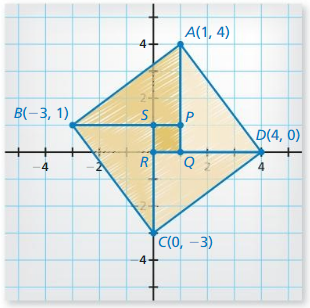
a. Partition quadrilateral ABCD into four right triangles and one square, as shown. Find the coordinates of the vertices for the five smaller polygons.
Answer:
The coordinates of ΔAQD are: (1, 4), Q (1, 0), and D (4, 0),
The coordinates of ΔBPA are B (-3, 1), P (1, 1), and A (1, 4),
The coordinates of ΔDRC are D (4, 0), R (0, 0), and C (0, -3),
The coordinates of ΔCSB are C (0, -3), S (0, 1), and B (-3, 1),
The coordinates of square PQRS are P (1, 1), Q (1, 0), R (0, 0), and S (0, 1),
Explanation:
From the figure The five smaller polygons are ΔAQD, ΔBPA, ΔDRC, ΔCSB, and square PQRS
Now the coordinates for the given vertices polygons are :
The coordinates of ΔAQD are A (1, 4), Q (1, 0), and D (4, 0),
The coordinates of ΔBPA are B (-3, 1), P (1, 1), and A (1, 4),
The coordinates of ΔDRC are D (4, 0), R (0, 0), and C (0, -3),
The coordinates of ΔCSB are C (0, -3), S (0, 1), and B (-3, 1),
The coordinates of square PQRS are P (1, 1), Q (1, 0), R (0, 0), and S (0, 1).
b. Find the areas of the five smaller polygons.
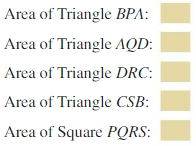
Answer:
Area of ΔBPA is 6,
Area of Δ AQD is 6,
Area of Δ DRC is 6,
Area of Δ CSB is 6,
Area of square PQRS is 1,
Explanation:
From part (a) the coordinates of ΔAQD are A (1, 4), Q (1, 0), and D (4, 0),
The coordinates of ΔBPA are B (-3, 1), P (1, 1), and A (1, 4),
The coordinates of ΔDRC are D (4, 0), R (0, 0), and C (0, -3),
The coordinates of ΔCSB are C (0, -3), S (0, 1), and B (-3, 1),
The coordinates of square PQRS areP (1, 1), Q (1, 0), R (0, 0), and S (0, 1),
Now the area of Δ BPA:
The length of BP = \(\sqrt{(x2 – x1)² + (y2 – y1)²}\) = \(\sqrt{(1 + 3)² + (1 – 1)²}\) = 4,
The length of PA = \(\sqrt{(x2 – x1)² + (y2 – y1)²}\) = \(\sqrt{(1 – 1)² + (4 – 1)²}\) = 3,
The length of BA = \(\sqrt{(x2 – x1)² + (y2 – y1)²}\) = \(\sqrt{(4 – 1)² + (1 + 3)²}\) = 5,
So the area of ΔBPA = \(\frac{1}{2}\) × Base × Height = \(\frac{1}{2}\) (4) (3) = 6,
The area of Δ AQD:
The length of AQ = \(\sqrt{(x2 – x1)² + (y2 – y1)²}\) = \(\sqrt{(1 – 1)² + (4 – 0)²}\) = 4,
The length of QD = \(\sqrt{(x2 – x1)² + (y2 – y1)²}\) = \(\sqrt{(4 – 1)² + (0 – 0)²}\) = 3,
The length of DA = \(\sqrt{(x2 – x1)² + (y2 – y1)²}\) = \(\sqrt{(4 – 1)² + (4 – 0)²}\) = 5,
So the area of ΔAQD = \(\frac{1}{2}\) × Base × Height = \(\frac{1}{2}\) (4) (3) = 6.
The area of Δ DRC:
The length of DR = \(\sqrt{(x2 – x1)² + (y2 – y1)²}\) = \(\sqrt{(0 – 0)² + (4 – 0)²}\) = 4,
The length of RC = \(\sqrt{(x2 – x1)² + (y2 – y1)²}\) = \(\sqrt{(3 + 0)² + (0 – 0)²}\) = 3,
The length of CD = \(\sqrt{(x2 – x1)² + (y2 – y1)²}\) = \(\sqrt{(0 + 3)² + (4 – 0)²}\) = 5,
So, The area of ΔDRC = \(\frac{1}{2}\) × Base × Height = \(\frac{1}{2}\) (4) (3) = 6.
The area of Δ CSB:
The length of CS = \(\sqrt{(x2 – x1)² + (y2 – y1)²}\) = \(\sqrt{(0 – 0)² + (1 + 3)²}\) = 4,
The length of SB = \(\sqrt{(x2 – x1)² + (y2 – y1)²}\) = \(\sqrt{(1 – 1)² + (0 + 3)²}\) = 3,
The length of BC = \(\sqrt{(x2 – x1)² + (y2 – y1)²}\) = \(\sqrt{(1 + 3)² + (0+ 3)²}\) = 5,
So, The area of ΔCSB = \(\frac{1}{2}\) × Base × Height = \(\frac{1}{2}\) (4) (3) = 6.
The area of square PQRS:
The length of PQ = \(\sqrt{(x2 – x1)² + (y2 – y1)²}\) = \(\sqrt{(1 – 1)² + (1 – 0)²}\) = 1,
The length of QR = \(\sqrt{(x2 – x1)² + (y2 – y1)²}\) = \(\sqrt{(1 – 0)² + (0 – 0)²}\) = 1,
The length of RS = \(\sqrt{(x2 – x1)² + (y2 – y1)²}\) = \(\sqrt{(1 – 0)² + (0 – 0)²}\) = 1,
The length of PS = \(\sqrt{(x2 – x1)² + (y2 – y1)²}\) =\(\sqrt{(1 – 0)² + (1 – 1)²}\) = 1,
So the area of square PQRS = Side² = 1.
c. Is the sum of the areas of the five smaller polygons equal to the area of quadrilateral ABCD? Justify your answer.
Answer:
Yes, The sum of the areas of the five smaller polygons equal to the area of quadrilateral ABCD,
Explanation:
From the given figure the coordinates of the quadrilateral ABCD are A (1, 4), B(-3, 1), C (0, -3), and D (4, 0)
Now, The length of AB = \(\sqrt{(x2 – x1)² + (y2 – y1)²}\) = \(\sqrt{(1 + 3)² + (4 – 1)²}\) = 5,
The length of BC = \(\sqrt{(x2 – x1)² + (y2 – y1)²}\) = \(\sqrt{(0 + 3)² + (1 + 3)²}\) = 5,
The length of CD = \(\sqrt{(x2 – x1)² + (y2 – y1)²}\) = \(\sqrt{(4 – 0)² + (0 + 3)²}\) = 5,
The length of DA = \(\sqrt{(x2 – x1)² + (y2 – y1)²}\) = \(\sqrt{(4 – 0)² + (4 – 1)²}\) = 5,
So, from the above we can observe that all the lengths of the sides are equal and the product of the slopes of the perpendicular sides is -1, Hence the area of quadrilateral ABCD = Side² = 5² = 25.
Now the sum of the areas of the five smaller polygons = 6 + 6 + 6 + 6 + 1 = 25,
Hence, from the above we can conclude that the sum of the areas of the five smaller polygons equal to the area of quadrilateral ABCD.
Communicate Your Answer
Question 3.
How can you find the perimeter and area of a polygon in a coordinate plane?
Answer:
The perimeter of any polygon may be found by adding up the lengths of its sides,
Using the basic area formulas for triangles and rectangles to determine the area of the figure,
Explanation:
When two-dimensional figures are shown on the coordinate plane, a mix of counting and the Pythagorean Theorem can be used to determine the lengths of each side. Then add up the lengths to determine the perimeter or use the basic area formulas for triangles and rectangles to determine the area of the figure.
Question 4.
Repeat Exploration 1 for quadrilateral EFGH. where the coordinates of the vertices are E(- 3, 6), F(- 7, 3), G(- 1, – 5), and H(3, – 2).
Answer:
The perimeter of quadrilateral EFGH is 30, The area of quadrilateral EFGH is 50,
Explanation:
The coordinates of the vertices of quadrilateral EFGH are E (-3, 6), F (-7, 3), G (-1, -5), and H (3, -2).
Now the length of EF = \(\sqrt{(x2 – x1)² + (y2 – y1)²}\) =\(\sqrt{(7 – 3)² + (6 – 3)²}\) = 5,
The length of FG = \(\sqrt{(x2 – x1)² + (y2 – y1)²}\) =\(\sqrt{(7 – 1)² + (3 + 5)²}\) = 10,
The length of GH = \(\sqrt{(x2 – x1)² + (y2 – y1)²}\) = \(\sqrt{(3 + 1)² + (5 – 2)²}\) = 5,
The length of HE = \(\sqrt{(x2 – x1)² + (y2 – y1)²}\) =\(\sqrt{(3 + 3)² + (6 + 2)²}\) = 10,
Hence the perimeter of quadrilateral EFGH = EF + FG + GH + HE = 5 + 5 + 10 + 10 = 30.
From the lengths of the sides, We can observe that the opposite sides have the same lengths and the product of the slopes of the perpendicular sides is -1, So the figure is rectangle we know that the area of a rectangle = Length × Width, So the area of quadrilateral EFGH = 5 × 10 = 50,
Hence, from the above we can conclude that the perimeter of quadrilateral EFGH is 30, The area of quadrilateral EFGH is 50.
Lesson 1.4 Perimeter and Area in the Coordinate Plane
Monitoring Progress
Classify the polygon the number of sides. Tell whether it is convex or concave.
Question 1.

Answer:
“Pentagon” and it is convex,
Explanation:
The given polygon is

From the given polygon the number of sides is 5, So the given polygon is “Pentagon”,
We know that the figure is concave if all the interior angles are greater than 180°, The figure is convex if all the interior angles are less than 180°, Hence, from the above, We can conclude that the given polygon is “Pentagon” and it is convex.
Question 2.

Answer:
“Hexagon” and it is convex,
Explanation:
The given polygon is

From the above polygon, We can observe that the number of sides is 6, So the given polygon is Hexagon. We know that the figure is concave if all the interior angles are greater than 180°,
The figure is convex if all the interior angles are less than 180°, Hence, from the above we can conclude that the given polygon is “Hexagon” and it is convex.
Find the perimeter of the polygon with the given vertices.
Question 3.
D(- 3, 2), E(4, 2), F(4, – 3)
Answer:
The perimeter of the given vertices is 20.60,
Explanation:
The given vertices are D (-3, 2), E (4, 2), F (4, -3) , Now the length of DE = \(\sqrt{(x2 – x1)² + (y2 – y1)²}\) =\(\sqrt{(4 + 3)² + (2 – 2)²}\) = 7, The length of EF = \(\sqrt{(x2 – x1)² + (y2 – y1)²}\)
= \(\sqrt{(4 – 4)² + (3 + 2)²}\) = 5, The length of FD = \(\sqrt{(x2 – x1)² + (y2 – y1)²}\) = \(\sqrt{(4 + 3)² + (2 + 3)²}\) = 8.60,
So the perimeter of the given vertices = 7 + 5 + 8.60 = 20.60, Hence, from the above we can conclude that the perimeter of the given vertices is 20.60.
Question 4.
G(- 3, 2), H(2, 2), J(- 1, – 3)
Answer:
The perimeter of the given vertices is 16.1,
Explanation:
The given vertices are G (-3, 2), H (2, 2), I (-1, -3),
Now the length of GH = \(\sqrt{(x2 – x1)² + (y2 – y1)²}\) = \(\sqrt{(2 + 3)² + (2 – 2)²}\) = 5,
The length of HI = \(\sqrt{(x2 – x1)² + (y2 – y1)²}\) = \(\sqrt{(2 + 1)² + (3 + 2)²}\) = 5.8,
The length of IG = \(\sqrt{(x2 – x1)² + (y2 – y1)²}\) = \(\sqrt{(3 – 1)² + (2 + 3)²}\) = 5.3,
So the perimeter of the given vertices = 5 + 5.8 + 5.3 = 16.1, Hence from the above we can conclude that the perimeter of the given vertices is 16.1.
Question 5.
K( – 1, 1), L(4, 1), M(2, – 2), N(- 3, – 2)
Answer:
The perimeter of the given vertices is 17.2,
Explanation:
The given vertices are K (-1, 1), L (4, 1), M (2, -2), N (-3, -2), Now the length of KL = \(\sqrt{(x2 – x1)² + (y2 – y1)²}\) = \(\sqrt{(4 + 1)² + (1 – 1)²}\) = 5,
The length of LM = \(\sqrt{(x2 – x1)² + (y2 – y1)²}\) = \(\sqrt{(4 – 2)² + (1 + 2)²}\) = 3.6,
The length of MN = \(\sqrt{(x2 – x1)² + (y2 – y1)²}\) = \(\sqrt{(2 + 3)² + (2 – 2)²}\) = 5,
The length of NK = \(\sqrt{(x2 – x1)² + (y2 – y1)²}\) = \(\sqrt{(3- 1)² + (1 + 2)²}\) = 3.6,
So the perimeter of the given vertices = 5 + 5 + 3.6 + 3.6 = 17.2,
Hence from the above we can conclude that the perimeter of the given vertices is 17.2.
Question 6.
Q(- 4, – 1), R(1, 4), S(4, 1), T(- 1, – 4)
Answer:
The perimeter of the given vertices is 22.54,
Explanation:
The given vertices are Q (-4, -1), R (1, 4), S (4, 1), T (-1, -4),
Now The length of QR = \(\sqrt{(x2 – x1)² + (y2 – y1)²}\) =\(\sqrt{(4 + 1)² + (4 + 1)²}\) = 7.07, The length of RS = \(\sqrt{(x2 – x1)² + (y2 – y1)²}\) = \(\sqrt{(4 – 1)² + (4 – 1)²}\) = 4.2,
The length of ST = \(\sqrt{(x2 – x1)² + (y2 – y1)²}\) = \(\sqrt{(4 + 1)² + (1 + 4)²}\) = 7.07,
The length of TQ = \(\sqrt{(x2 – x1)² + (y2 – y1)²}\) = \(\sqrt{(4- 1)² + (4 – 1)²}\) = 4.2,
So the perimeter of the given vertices = 7.07 + 7.07 + 4.2 + 4.2 = 22.54. Hence from the above we can conclude that the perimeter of the given vertices is 22.54.
Find the area of the polygon with the given vertices.
Question 7.
G(2, 2), H(3, – 1), J(- 2, – 1)
Answer:
The area of the given vertices is 12.5,
Explanation:
The given vertices are G (2, 2), H (3, -1), I (-2, -1),
Now the length of GH = \(\sqrt{(x2 – x1)² + (y2 – y1)²}\) = \(\sqrt{(2 – 3)² + (2 + 1)²}\) = 3.16,
The length of HI = \(\sqrt{(x2 – x1)² + (y2 – y1)²}\) = \(\sqrt{(1 – 1)² + (3 + 2)²}\) = 5,
The length of IG = \(\sqrt{(x2 – x1)² + (y2 – y1)²}\) = \(\sqrt{(2 + 2)² + (2 + 1)²}\) = 5,
So the area of the given vertices = \(\frac{1}{2}\) × Base × Height = \(\frac{1}{2}\) × 5 × 5
= 12.5, Hence from the above we can conclude that the area of the given vertices is 12.5.
Question 8.
N(- 1, 1), P(2, 1), Q(2, – 2), R(- 1, – 2)
Answer:
The area of the given vertices is 9,
Explanation:
The given vertices are: N (-1, 1), P (2, 1), Q (2, -2), R (-1, -2)
Now The length of NP = \(\sqrt{(x2 – x1)² + (y2 – y1)²}\) = \(\sqrt{(2 + 1)² + (1 – 1)²}\) = 3,
The length of PQ = \(\sqrt{(x2 – x1)² + (y2 – y1)²}\) = \(\sqrt{(2 – 2)² + (1 + 2)²}\) = 3,
The length of QR = \(\sqrt{(x2 – x1)² + (y2 – y1)²}\)= \(\sqrt{(2 + 1)² + (2 – 2)²}\) = 3,
The length of RN = \(\sqrt{(x2 – x1)² + (y2 – y1)²}\) = \(\sqrt{(1- 1)² + (1 + 2)²}\) = 3,
So from the lengths of all of the sides we can say that the vertices belong to a square,
So the area of a square = Side² = 3² = 9,
Hence, from the above, We can conclude that the area of the given vertices is 9.
Question 9.
F(- 2, 3), G(1, 3), H(1, – 1), J(- 2, – 1)
Answer:
The area of the given vertices is 12,
Explanation:
The given vertices are F (-2, 3), G (1, 3), H (1, -1), J (-2, -1),
Now the length of FG = \(\sqrt{(x2 – x1)² + (y2 – y1)²}\) = \(\sqrt{(2 + 1)² + (3 – 3)²}\) = 3, The length of GH = \(\sqrt{(x2 – x1)² + (y2 – y1)²}\) =\(\sqrt{(1 – 1)² + (1 + 3)²}\) = 4,
The length of HJ = \(\sqrt{(x2 – x1)² + (y2 – y1)²}\) = \(\sqrt{(2 + 1)² + (1 – 1)²}\) = 3,
The length of JF = \(\sqrt{(x2 – x1)² + (y2 – y1)²}\) = \(\sqrt{(2- 2)² + (1 + 3)²}\) = 4,
So from the lengths of all of the sides, We can say that the vertices belong to a rectangle since the lengths of the opposite sides are the same, So the area of a rectangle = Length × Width = 3 × 4 = 12. Hence from the above we can conclude that the area of the given vertices is 12.
Question 10.
K(- 3, 3), L(3, 3), M(3, – 1), N(- 3, – 1)
Answer:
The area of the given vertices is 24,
Explanation:
The given vertices are K (-3, 3), L (3, 3), M (3, -1), N (-3, -1),
Now the length of KL = \(\sqrt{(x2 – x1)² + (y2 – y1)²}\) = \(\sqrt{(3 + 3)² + (3 – 3)²}\) = 6, The length of LM = \(\sqrt{(x2 – x1)² + (y2 – y1)²}\) = \(\sqrt{(3 – 3)² + (1 + 3)²}\) = 4,
The length of MN = \(\sqrt{(x2 – x1)² + (y2 – y1)²}\) = \(\sqrt{(3 + 3)² + (1 – 1)²}\) = 6,
The length of NK = \(\sqrt{(x2 – x1)² + (y2 – y1)²}\) = \(\sqrt{(3- 3)² + (1 + 3)²}\) = 4,
So from the lengths of all of the sides we can say that the vertices belong to a rectangle.
The area of a rectangle = Length × Width = 6 × 4 = 24, Hence from the above we can conclude that the area of the given vertices is 24.
Question 11.
You are building a patio in your school’s courtyard. In the diagram at the left, the coordinates represent the four vertices of the patio. Each unit in the coordinate plane represents 1 foot. Find the area of the patio.
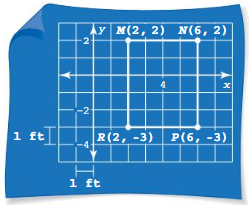
Answer:
The area of the patio is 20,
Explanation:
From the given graph the coordinates of a patio is: M (2, 2), N (6, 2), P (6, -3), R (2, -3)
Now, The length of MN = \(\sqrt{(x2 – x1)² + (y2 – y1)²}\) = \(\sqrt{(6 – 2)² + (2 – 2)²}\) = 4,
The length of NP = \(\sqrt{(x2 – x1)² + (y2 – y1)²}\) = \(\sqrt{(6 – 6)² + (3 + 2)²}\) = 5,
The length of PR = \(\sqrt{(x2 – x1)² + (y2 – y1)²}\) = \(\sqrt{(6 – 2)² + (3 – 3)²}\) = 4,
The length of RM = \(\sqrt{(x2 – x1)² + (y2 – y1)²}\) = \(\sqrt{(2- 2)² + (3 + 2)²}\) = 5,
So, From the lengths of all of the sides, We can say that the vertices belong to a rectangle
So, The area of a rectangle = Length × Width = 5 × 4 = 20. Hence from the above we can conclude that the area of the patio is 20.
Exercise 1.4 Perimeter and Area in the Coordinate Plane
Question 1.
COMPLETE THE SENTENCE
The perimeter of a square with side length s is P = _________ .
Answer:
P = 4s,
Explanation:
The perimeter of a square is defined as the length that its boundary covers. 
Question 2.
WRITING
What formulas can you use to find the area of a triangle in a coordinate plane?
Answer:
A = \(\frac{1}{2}\) × Base × Height,
Explanation:
We know that the formula you can use to find the area of a triangle in a coordinate plane is
Area of a triangle (A) = \(\frac{1}{2}\) × Base × Height.
Monitoring Progress and Modeling with Mathematics
In Exercises 3 – 6, classify the polygon by the number of sides. Tell whether it is convex or concave.
Question 3.

Answer:
Four sides, Quadrilateral, Concave,
Explanation:

Question 4.

Answer:
Polygon is a triangle and it is a concave polygon as it has interior angles greater than 180°,
Explanation:
From the given polygon we can observe that the number of sides is 3, We know that the figure is concave if all the interior angles are greater than 180°, The figure is convex if all the interior angles are less than 180°
Hence, from the above, We can conclude that the given polygon is a triangle and it is a concave polygon as it has interior angles greater than 180°.
Question 5.

Answer:
Five sides, Pentagon, Convex,
Explanation:

Question 6.

Answer:
Polygon is a hexagon and it is a concave polygon as it has interior angles greater than 180°,
Explanation:
From the given polygon we can observe that the number of sides is 6,
We know that, the figure is concave if all the interior angles are greater than 180°,
The figure is convex if all the interior angles are less than 180°, Hence, from the above, We can conclude that the given polygon is a hexagon and it is a concave polygon as it has interior angles greater than 180°.
In Exercises 7 – 12. find the perimeter of the polygon with the given vertices.
Question 7.
G(2, 4), H(2, – 3), J(- 2, – 3), K(- 2, 4)
Answer:
The perimeter of the polygon with the given vertices is 22 units,
Explanation:
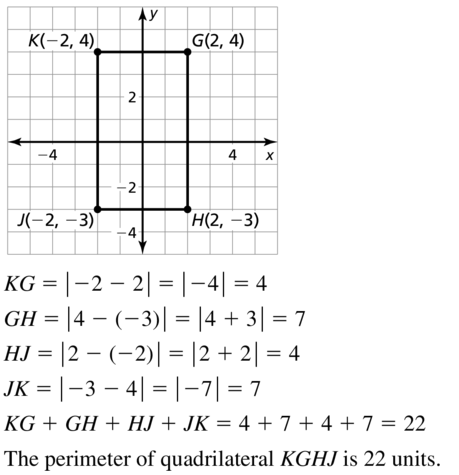
Question 8.
Q(- 3, 2), R(1, 2), s(1, – 2), T(- 3, – 2)
Answer:
The perimeter of the given polygon is 16,
Explanation:
The given vertices of a polygon are Q (-3, 2), R (1, 2), S (1, -2), T (-3, -2), Now,
The length of QR = \(\sqrt{(x2 – x1)² + (y2 – y1)²}\) = \(\sqrt{(1 + 3)² + (2 – 2)²}\) = 4,
The length of RS = \(\sqrt{(x2 – x1)² + (y2 – y1)²}\) = \(\sqrt{(1 – 1)² + (2 + 2)²}\) = 4,
The length of ST = \(\sqrt{(x2 – x1)² + (y2 – y1)²}\) = \(\sqrt{(2 – 2)² + (1 + 3)²}\) = 4,
The length of TQ = \(\sqrt{(x2 – x1)² + (y2 – y1)²}\) = \(\sqrt{(3- 3)² + (2 + 2)²}\) = 4,
So, From the lengths of all of the sides we can say that the vertices belong to a square. So, The perimeter of a square = 4 × Side = 4 × 4 = 16. Hence, from the above we can conclude that the perimeter of the given polygon is 16.
Question 9.
U(- 2, 4), V(3, 4), W(3, – 4)
Answer:
The perimeter is 22.43 units,
Explanation:

Question 10.
X(- 1, 3), Y(3, 0), Z(- 1, – 2)
Answer:
The perimeter of the given polygon is 14.47,
Explanation:
The given vertices of a polygon are X (-1, 3), Y (3, 0), Z (-1, -2),
Now, The length of XY = \(\sqrt{(x2 – x1)² + (y2 – y1)²}\) =\(\sqrt{(3 + 1)² + (3 – 0)²}\) = 5,
The length of YZ = \(\sqrt{(x2 – x1)² + (y2 – y1)²}\) = \(\sqrt{(3 + 1)² + (0 + 2)²}\) = 4.47,
The length of ZX = \(\sqrt{(x2 – x1)² + (y2 – y1)²}\)= \(\sqrt{(1 – 1)² + (3 + 2)²}\) = 5,
So, The perimeter of the given polygon = 5 + 5 + 4.7 = 14.47, Hence from the above we can conclude that the perimeter of the given polygon is 14.47.
Question 11.
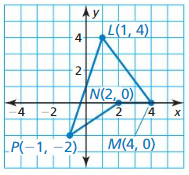
Answer:
The perimeter is 16.93 units,
Explanation:

Question 12.
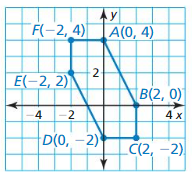
Answer:
The perimeter of the given hexagon is 16.94,
Explanation:
From the given coordinate plane, The given vertices of the hexagon are: A (0, 4), B (2, 0), C (2, -2), D (0, -2), E (-2, 2), F (-2, 4). Now, The length of AB = \(\sqrt{(x2 – x1)² + (y2 – y1)²}\) = \(\sqrt{(2 – 0)² + (4 – 0)²}\) = 4.47,
The length of BC = \(\sqrt{(x2 – x1)² + (y2 – y1)²}\) = \(\sqrt{(2 – 2)² + (0 + 2)²}\) = 2,
The length of CD = \(\sqrt{(x2 – x1)² + (y2 – y1)²}\) = \(\sqrt{(2 – 0)² + (2 – 2)²}\) = 2,
The length of DE = \(\sqrt{(x2 – x1)² + (y2 – y1)²}\) = \(\sqrt{(0 + 2)² + (2 + 2)²}\) = 4.47,
The length of EF = \(\sqrt{(x2 – x1)² + (y2 – y1)²}\)= \(\sqrt{(2 – 2)² + (4 – 2)²}\) = 2,
The length of FA = \(\sqrt{(x2 – x1)² + (y2 – y1)²}\) = \(\sqrt{(0 + 2)² + (4 – 4)²}\) = 2,
So, The perimeter of the hexagon = AB + BC + CD + DE + EF + FA = 4.47 + 2 + 2 + 4.47 + 2 + 2 = 16.94,
Hence, from the above we can conclude that the perimeter of the given hexagon is 16.94.
In Exercises 13 – 16. find the area of the polygon with the given vertices.
Question 13.
E(3, 1), F(3, – 2), G(- 2, – 2)
Answer:
The area of the polygon is 7.5 square units,
Explanation:
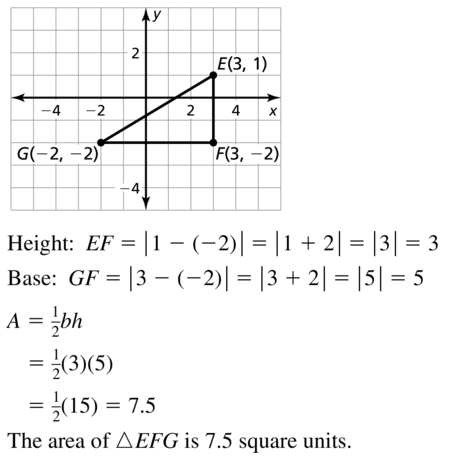
Question 14.
J(- 3, 4), K(4, 4), L(3, – 3)
Answer:
The area of the given vertices is 24.74,
Explanation:
The given vertices are J (-3, 4), K (4, 4), L (3, -3),
Now the length of JK = \(\sqrt{(x2 – x1)² + (y2 – y1)²}\) = \(\sqrt{(4 + 3)² + (4 – 4)²}\) = 7, The length of KL = \(\sqrt{(x2 – x1)² + (y2 – y1)²}\) = \(\sqrt{(4 – 3)² + (4 + 3)²}\) = 7.07,
The length of LJ = \(\sqrt{(x2 – x1)² + (y2 – y1)²}\) = \(\sqrt{(3 + 3)² + (3 + 4)²}\) = 9.21,
So, The area of the given vertices = \(\frac{1}{2}]/latex] × JK ×KL = [latex/]frac{1}{2}\) × 7 × 7.07
= 24.74. Hence from the above we can conclude that the area of the given vertices is 24.74.
Question 15.
W(0, 0), X(0, 3), Y(- 3, 3), Z(- 3, 0)
Answer:
The area of quadrilateral XWZY is 9 square units,
Explanation:
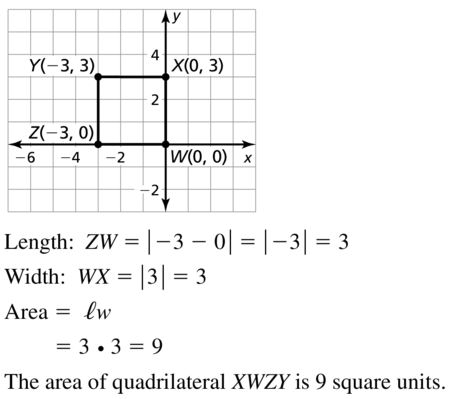
Question 16.
N(- 2, 1), P(3, 1), Q(3, – 1), R(- 2, 1)
Answer:
The area of the given vertices is 28.97,
Explanation:
The given vertices are: N (-2, 1), P (3, 1), Q (3, -1), R (-2, 1)
Now, The length of NP = \(\sqrt{(x2 – x1)² + (y2 – y1)²}\) = \(\sqrt{(3 + 2)² + (1 – 1)²}\) = 5,
The length of PQ = \(\sqrt{(x2 – x1)² + (y2 – y1)²}\) = \(\sqrt{(3 – 3)² + (1 + 1)²}\) = 2,
The length of QR = \(\sqrt{(x2 – x1)² + (y2 – y1)²}\) = \(\sqrt{(3 + 2)² + (1 + 1)²}\) = 5.38,
The length of RN = \(\sqrt{(x2 – x1)² + (y2 – y1)²}\) = \(\sqrt{(2 – 2)² + (1 – 1)²}\) = 0,
So,The area of the given vertices = 5 × 2 × 5.38 = 28.97. Hence from the above we can conclude that the area of the given vertices is 28.97.
In Exercises 17 – 24, use the diagram.

Question 17.
Find the perimeter of △CDE.
Answer:
The perimeter is 9.66 units,
Explanation:
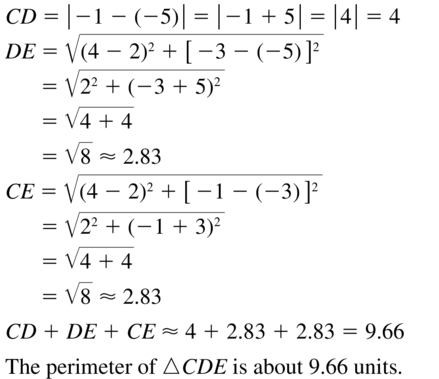
Question 18.
Find the perimeter of the rectangle BCEF.
Answer:
The perimeter of the rectangle BCEF is 16.94,
Explanation:
From the given figure the coordinates of the rectangle BCEF are: B (0, 3) C (4, -1), E (2, -3), F (-2, 1), Now,
The length of BC = \(\sqrt{(x2 – x1)² + (y2 – y1)²}\) = \(\sqrt{(4 – 0)² + (3 + 1)²}\) = 5.65,
The length of CE = \(\sqrt{(x2 – x1)² + (y2 – y1)²}\) = \(\sqrt{(4 – 2)² + (3 – 1)²}\) = 2.82,
The length of EF = \(\sqrt{(x2 – x1)² + (y2 – y1)²}\) = \(\sqrt{(1 + 3)² + (2 + 2)²}\) = 5.65,
The length of FB = \(\sqrt{(x2 – x1)² + (y2 – y1)²}\) = \(\sqrt{(0 + 2)² + (3 – 1)²}\) = 2.82,
So, The perimeter of the rectangle BCEF = BC + CE + EF + FB = 5.65 + 2.82 + 5.65 + 2.82 = 16.94
Hence from the above we can conclude that the perimeter of the rectangle BCEF is 16.94.
Question 19.
Find the perimeter of △ABF.
Answer:
The perimeter is about 12.17 units,
Explanation:

Question 20.
Find the perimeter of quadrilateral ABCD.
Answer:
The perimeter of quadrilateral ABCD is 31.37,
Explanation:
From the given figure the given vertices of the quadrilateral ABCD are A (-5, 4), B (0, 3), C (4, -1), D (4, -5)
Now, The length of AB = \(\sqrt{(x2 – x1)² + (y2 – y1)²}\) = \(\sqrt{(0 + 5)² + (4 – 3)²}\) = 5.09,
The length of BC = \(\sqrt{(x2 – x1)² + (y2 – y1)²}\) = \(\sqrt{(4 – 0)² + (1 + 3)²}\) = 5.65,
The length of CD = \(\sqrt{(x2 – x1)² + (y2 – y1)²}\) = \(\sqrt{(4 – 4)² + (5 – 1)²}\) = 4,
The length of DA = \(\sqrt{(x2 – x1)² + (y2 – y1)²}\) = \(\sqrt{(4 + 5)² + (4 + 5)²}\) = 12.72,
So, The perimeter of quadrilateral ABCD = AB + BC + CD + DA = 5.09 + 5.65 + 4 + 12.72 = 31.37, Hence from the above we can conclude that the perimeter of quadrilateral ABCD is 31.37.
Question 21.
Find the area of △CDE.
Answer:
The area is 4 square units,
Explanation:

Question 22.
Find the area of rectangle BCEF
Answer:
The area of the rectangle BCEF is 15.93,
Explanation:
From the given figure the coordinates of the rectangle BCEF are: B (0, 3) C (4, -1), E (2, -3), F (-2, 1)
Now the length of BC = \(\sqrt{(x2 – x1)² + (y2 – y1)²}\) = \(\sqrt{(4 – 0)² + (3 + 1)²}\) = 5.65,
The length of CE = \(\sqrt{(x2 – x1)² + (y2 – y1)²}\) = \(\sqrt{(4 – 2)² + (3 – 1)²}\) = 2.82,
The length of EF = \(\sqrt{(x2 – x1)² + (y2 – y1)²}\) = \(\sqrt{(1 + 3)² + (2 + 2)²}\) = 5.65,
The length of FB = \(\sqrt{(x2 – x1)² + (y2 – y1)²}\) = \(\sqrt{(0 + 2)² + (3 – 1)²}\) = 2.82,
So the area of the rectangle BCEF = Length × Width = 2.82 × 5.65 = 15.93, Hence from the above we can conclude that the area of the rectangle BCEF is 15.93.
Question 23.
Find the area of △ABF
Answer:
The area is 6 square units,
Explanation:
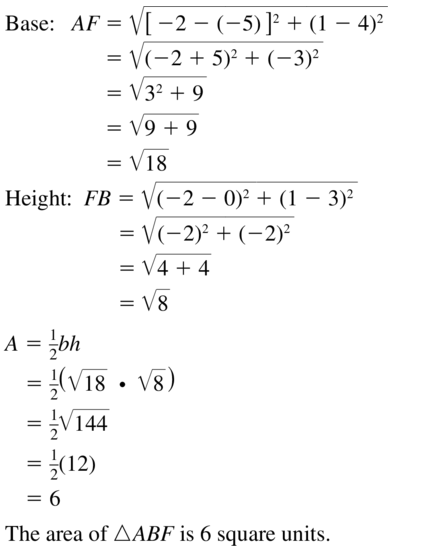
Question 24.
Find the area of quadrilateral ABCD.
Answer:
The area of the quadrilateral ABCD is 45.99,
Explanation:
The given vertices of the quadrilateral ABCD are: A (-5, 4), B (0, 3), C (4, -1), D (4, -5), Now
The length of AB = \(\sqrt{(x2 – x1)² + (y2 – y1)²}\) = \(\sqrt{(0 + 5)² + (4 – 3)²}\) = 5.09,
The length of BC = \(\sqrt{(x2 – x1)² + (y2 – y1)²}\) = \(\sqrt{(4 – 0)² + (1 + 3)²}\) = 5.65,
The length of CD = \(\sqrt{(x2 – x1)² + (y2 – y1)²}\) = \(\sqrt{(4 – 4)² + (5 – 1)²}\) = 4,
The length of DA = \(\sqrt{(x2 – x1)² + (y2 – y1)²}\) = \(\sqrt{(4 + 5)² + (4 + 5)²}\) = 12.72,
The length of AC = \(\sqrt{(x2 – x1)² + (y2 – y1)²}\) = \(\sqrt{(4 + 5)² + (4 + 1)²}\) = 10.29 ,The length of BD = \(\sqrt{(x2 – x1)² + (y2 – y1)²}\) = \(\sqrt{(4 – 0)² + (3 + 5)²}\) = 8.94,
So the area of the quadrilateral ABCD = \(\frac{1}{2}\) ×AC × BD = \(\frac{1}{2}\) × 10.29 × 8.94 = 45.99. Hence from the above we can conclude that the area f the quadrilateral ABCD is 45.99.
ERROR ANALYSIS
In Exercises 25 and 26, describe and correct the error in finding the perimeter or area of the polygon.
Question 25.
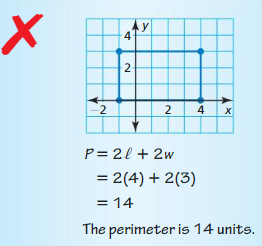
Answer:
The perimeter is 16 units,
Explanation:

Question 26.

Answer:
The area of ΔABC is 4.46 sq. units,
Explanation:
From the given figure the coordinates of the vertices of ΔABC are: A (4, 3), B (5, 1), C (1, 1) .Now,
The length of AB = \(\sqrt{(x2 – x1)² + (y2 – y1)²}\) = \(\sqrt{(5 – 4)² + (3 – 1)²}\) = 2.23,
The length of BC = \(\sqrt{(x2 – x1)² + (y2 – y1)²}\) = \(\sqrt{(5 – 1)² + (1 – 1)²}\) = 4,
The length of CA = \(\sqrt{(x2 – x1)² + (y2 – y1)²}\) = \(\sqrt{(4 – 1)² + (3 – 1)²}\) = 3.60,
So the area of ΔABC = \(\frac{1}{2}\) ×AB × BC = \(\frac{1}{2}\) × 2.23 × 4 = 4.46,
Hence from the above we can conclude that the area of ΔABC is 4.46 sq. units.
In Exercises 27 and 28, use the diagram.
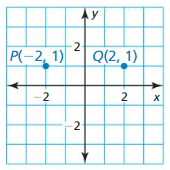
Question 27.
Determine which point is the remaining vertex of a triangle with an area of 4 square units.
A. R(2, 0)
B. S(- 2, – 1)
C. T(- 1, 0)
D. U(2, – 2)
Answer:
B. S(-2,-1),
Explanation:
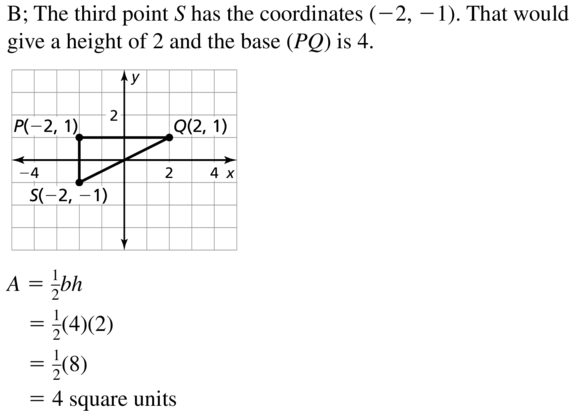
Question 28.
Determine which points are the remaining vertices of a rectangle with a perimeter of 14 units.
A. A(2, – 2) and B(2, – 1)
B. C(- 2, – 2) and D(- 2, 2)
C. E(- 2, – 2) and F(2, – 2)
D. G(2, 0) and H(2, 0)
Answer:
C (-2, -2), and D (-2, 2),
Explanation:
From the given figure the given vertices are: P (-2, 1), Q (2, 1),
We know that the perimeter is defined as the sum of all the sides of a given polygon, Now let A (x, y), and B(p, q) are the remaining 2 points of a rectangle.
Now the length of PQ = \(\sqrt{(x2 – x1)² + (y2 – y1)²}\) = \(\sqrt{2 + 2)² + (1 – 1)²}\) = 4,
The length of QA = \(\sqrt{(x2 – x1)² + (y2 – y1)²}\) = \(\sqrt{(x – 2)² + (y – 1)²}\),
The length of AB = \(\sqrt{(x2 – x1)² + (y2 – y1)²}\) = \(\sqrt{(x – p)² + (y – q)²}\),
The length of BP = \(\sqrt{(x2 – x1)² + (y2 – y1)²}\) = \(\sqrt{(p + 2)² + (q – 1)²}\)
So the perimeter of the rectangle = PQ + QA + AB + BP = 4 + \(\sqrt{(x – 2)² + (y – 1)²}\) + \(\sqrt{(x – p)² + (y – q)²}\) + \(\sqrt{(p + 2)² + (q – 1)²}\). It is given that the perimeter of the rectangle = 14. So, 4 + \(\sqrt{(x – 2)² + (y – 1)²}\) + \(\sqrt{(x – p)² + (y – q)²}\) + \(\sqrt{(p + 2)² + (q – 1)²}\) = 14,
\(\sqrt{(x – 2)² + (y – 1)²}\) + \(\sqrt{(x – p)² + (y – q)²}\) + \(\sqrt{(p + 2)² + (q – 1)²}\) = 14 – 4,
\(\sqrt{(x – 2)² + (y – 1)²}\) + \(\sqrt{(x – p)² + (y – q)²}\) + \(\sqrt{(p + 2)² + (q – 1)²}\) = 10,
Now, from the given options,
a. The given remaining vertices are: A (2, -2), B (2, -1)
Compare the above vertices with A (x, y), and B (p, q)
So \(\sqrt{(2- 2)² + (-2 – 1)²}\) + \(\sqrt{(2 – 2)² + (-2 + 1)²}\) + \(\sqrt{(2 + 2)² + (-1 – 1)²}\) = 10 ,3 + 1 + 4.47 = 10, 8.47 ≠ 10
b. The given remaining vertices are: C (-2, -2), and D (-2, 2)
Compare the above vertices with A (x, y), and B (p, q)
So \(\sqrt{(-2 – 2)² + (-2 – 1)²}\) + \(\sqrt{(2 – 2)² + (-2 – 2)²}\) + \(\sqrt{(-2 + 2)² + (2 – 1)²}\) = 10, 5 + 4 +1 = 10, 10 = 10
Hence from the above we can conclude that the remaining two vertices which gives the perimeter of 14 units are: C (-2, -2), and D (-2, 2).
Question 29.
USING STRUCTURE
Use the diagram.
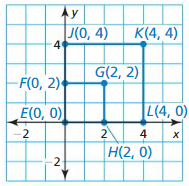
a. Find the areas of square EFGH and square EJKL. What happens to the area when the perimeter of square EFGH is doubled?
b. Is this true for every square? Explain.
Answer:
a. Area of square EFGH = 8, square EJKL = 16, The area of the original square is multiplied by 4,
b. Yes,
Explanation:
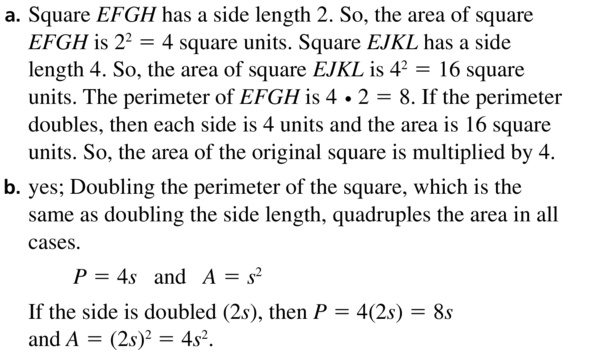
Question 30.
MODELING WITH MATHEMATICS
You are growing zucchini plants in your garden. In the figure. the entire garden is rectangle QRST. Each unit in the coordinate plane represents 1 foot.
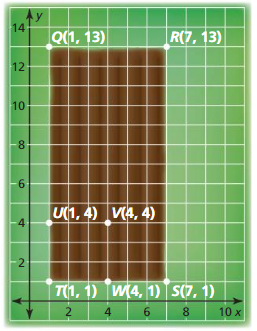
a. Find the area of the garden.
Answer:
The area of the garden is 72 square feet,
Explanation:
It is given that the rectangle QRST represents the garden, So from the figure the coordinates of the garden are: Q (1, 13), R (7, 13), S (7, 1), and T (1, 1), Now the length of QR = \(\sqrt{(x2 – x1)² + (y2 – y1)²}\)
= \(\sqrt{13 – 13)² + (7 – 1)²}\) = 6,
The length of RS = \(\sqrt{(x2 – x1)² + (y2 – y1)²}\) = \(\sqrt{13 – 1)² + (7 – 7)²}\) = 12,
The length of ST = \(\sqrt{(x2 – x1)² + (y2 – y1)²}\) = \(\sqrt{1 – 1)² + (7 – 1)²}\) = 6,
The length of TQ = \(\sqrt{(x2 – x1)² + (y2 – y1)²}\) = \(\sqrt{13 – 1)² + (1 – 1)²}\) = 12,
So, The area of the garden = (Length of the garden) × (Width of the garden) = 12 × 6 = 72 square feet
Hence from the above we can conclude that the area of the garden is 72 square feet.
b. Zucchini plants require 9 square feet around each plant. How many zucchini plants can you plant?
Answer:
The number of zucchini plants we can plant is 8 plants,
Explanation:
From part (a), The area of the entire garden is: 72 square feet, It is given that zucchini plants require 9 square feet around each plant. So, The number of zucchini plants you can plant = \(\frac{The area of the entire garden}{The area required for each zucchini plant}\) = \(\frac{72}{9}\) = 8,
Hence from the above we can conclude that the number of zucchini plants we can plant is 8 plants.
c. You decide to use square TUVW to grow lettuce. you can plant lour heads of lettuce per square loot. How many of each vegetable can you plant? Explain.
Answer:
We can plant 36 vegetables of each type,
Explanation:
From the figure, The coordinates of the vertices of the rectangle TUVW are: T (1, 1), U (1, 4), V (4, 4), W (4, 1)
Now, The length of TU = \(\sqrt{(x2 – x1)² + (y2 – y1)²}\) = \(\sqrt{1 – 1)² + (4 – 1)²}\) = 3,
The length of UV = \(\sqrt{(x2 – x1)² + (y2 – y1)²}\) = \(\sqrt{4 – 4)² + (4 – 1)²}\) = 3,
The length of VW = \(\sqrt{(x2 – x1)² + (y2 – y1)²}\) = \(\sqrt{4 – 4)² + (4 – 1)²}\) = 3,
The length of WT = \(\sqrt{(x2 – x1)² + (y2 – y1)²}\) = \(\sqrt{4 – 1)² + (1 – 1)²}\)= 3,
So, The area of square TUVW = Side² = 3² = 9 square feet, It is given that 1 square foot = 4 heads of lettuce
So 9 square feet = 9 × 4 = 36 heads of lettuce. Hence from the above we can conclude that we can plant 36 vegetables of each type.
Question 31.
MODELING WITH MATHEMATICS
You are going for a hike in the woods. You hike to a waterfall that is 4 miles east of where you left your car. You then hike to a lookout point that is 2 miles north of your car. From the lookout point. you return to our ear.
a. Map out your route in a coordinate plane with our car at the origin. Let each unit in the coordinate plane represent 1 mile. Assume you travel along straight paths.
b. How far do you travel during the entire hike?
c. When you leave the waterfall, you decide to hike to an old wishing well before going to the lookout point. The wishing well is 3 miles north and 2 miles west of the lookout point. How far do you travel during the entire hike?
Answer:
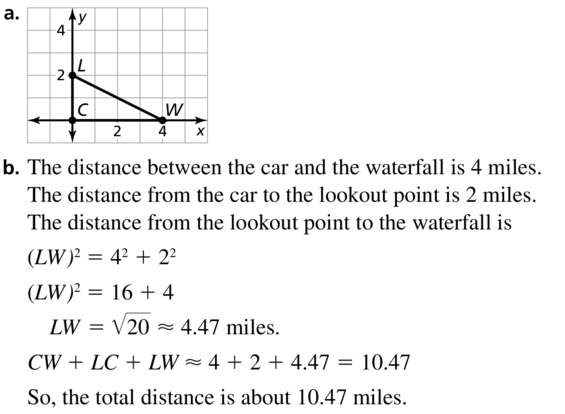
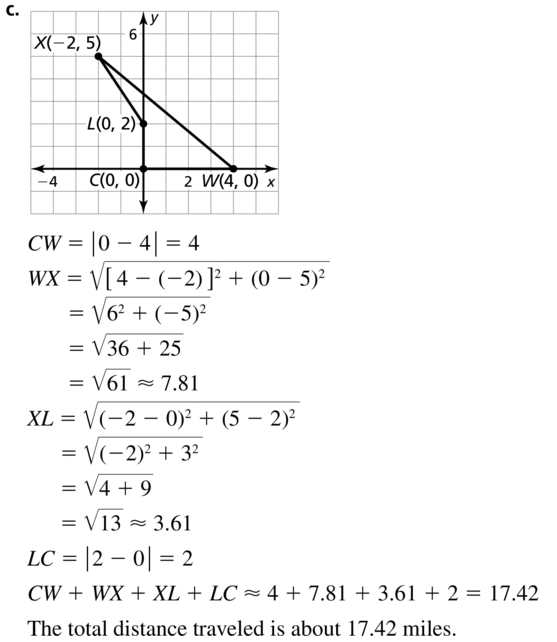
Explanation:
a. Mapped out my route in a coordinate plane with our car at the origin. By each unit in the coordinate plane represent 1 mile. Assuming my travel along straight paths as shown above,
b. The total distance is about 10.47 miles,
c. When we leave the waterfall, w decide to hike to an old wishing well before going to the lookout point. The wishing well is 3 miles north and 2 miles west of the lookout point. So far do I travel during the entire hike is about 17.42 miles.
Question 32.
HOW DO YOU SEE IT?
Without performing any calculations, determine whether the triangle or the rectangle has a greater area. Which one has a greater perimeter? Explain your reasoning.

Answer:
The area and the perimeter of the rectangle is greater than the area and the perimeter of the triangle,
Explanation:
From the given graph, We can observe that the size of the rectangle is greater than the size of the triangle
So, We can say that the area of the rectangle is greater than the area of the triangle. The perimeter of the rectangle is greater than the perimeter of the triangle. Hence, from the above, We can conclude that
the area and the perimeter of the rectangle is greater than the area and the perimeter of the triangle.
Question 33.
MATHEMATICAL CONNECTIONS
The lines y1 = 2x – 6, y2 = – 3x + 4, and y3 = – \(\frac{1}{2}\) + 4 are the sides of a right triangle.
a. Use slopes to determine which sides are perpendicular.
b. Find the vertices of the triangle.
c. Find the perimeter and area of the triangle.
Answer:
a. y1 and y3 are perpendicular,
b. The vertices are (0,4), (4,2) and (2, -2),
c. The perimeter is 15.27 units and area is 10 square units.
Explanation:
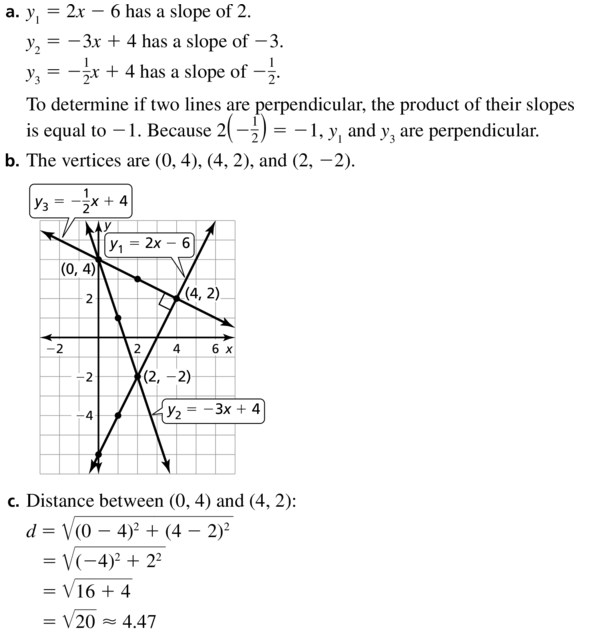

Question 34.
THOUGHT-PROVOKING
Your bedroom has an area of 350 square feet. You are remodeling to include an attached bathroom that has an area of 150 square feet. Draw a diagram of the remodeled bedroom and bathroom in a coordinate plane.
Answer:
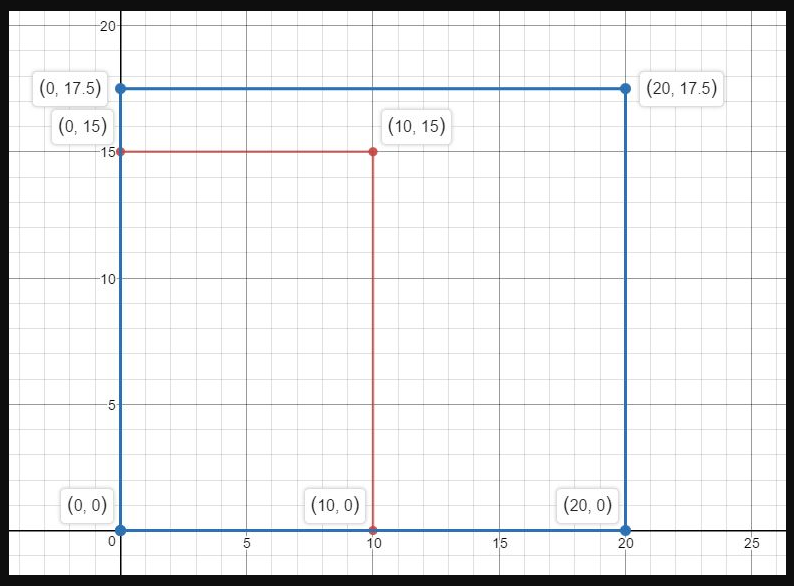
Explanation:
It is given that your bedroom has an area of 350 square feet. You are remodeling to include an attached bathroom that has an area of 150 square feet. So, The dimensions of the bedroom that has an area of 350 square feet are: Length: 20 feet and Width: 17.5 feet (Remember that any of the factor products of 350 will be the dimensions of the bedroom). So the dimensions of the bedroom that has an area of 350 square feet in the coordinate plane are: (0, 0), (0, 17.5), (20, 17.5), and (20, 0). Now, The dimensions of an attached bathroom that has an area of 150 square feet are: Length: 10 feet and Width: 15 feet (Remember that any of the factor products of 350 will be the dimensions of the bedroom). So, The dimensions of the attached bathroom that has an area of 150 square feet in the coordinate plane are: (0, 0), (0, 5), (10, 15), (5, 0).
Hence, The representation of the attached bedroom and the bathroom in a coordinate plane is shown above.
Question 35.
PROBLEM-SOLVING
Use the diagram
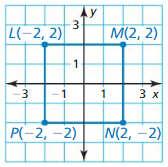
a. Find the perimeter and area of the square.
b. Connect the midpoints of the sides of the given square to make a quadrilateral. Is this quadrilateral a square? Explain our reasoning.
c. Find the perimeter and area of the quadrilateral you made in part (b). Compare this area to the area you found in part (a).
Answer:
a. Perimeter is 16 units, Area is 16 sqaure units,
b. Yes A square,
c. Perimeter is about 11.31 units and area is 8 square units, The area of the inner square is half the area of the larger square,
Explanation:
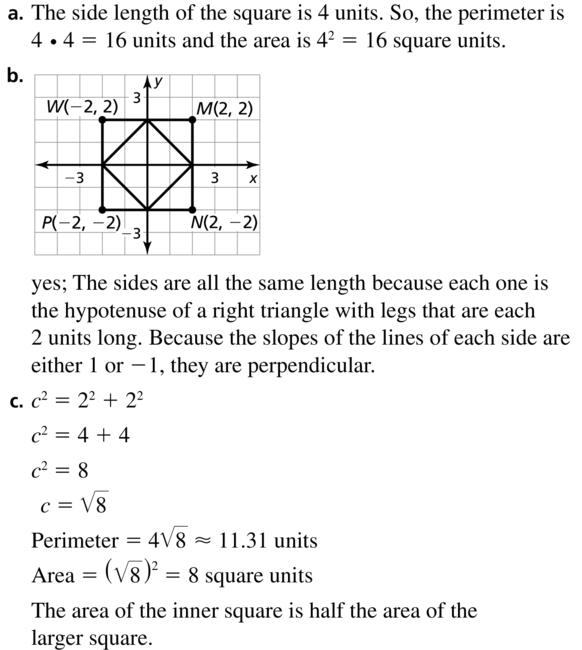
Question 36.
MAKING AN ARGUMENT
Your friend claims that a rectangle with the same perimeter as △QRS will have the same area as the triangle. Is your friend correct? Explain your reasoning.
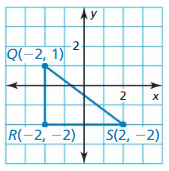
Answer:
No, my friend is not correct,
Explanation:
It is given that my friend claims that a rectangle with the same perimeter as △QRS will have the same area as the triangle. But, We know that the size of the rectangle is greater than the size of the triangle,
So, The area of the rectangle will be greater than the area of the triangle even though the perimeter of the rectangle and the triangle are the same. Hence from the above we can conclude that your friend is not correct.
Question 37.
REASONING
Triangle ABC has a perimeter of 12 units. The vertices of the triangle are A(x, 2), B(2, – 2), and C(- 1, 2). Find the value of x.
Answer:
x = 2,
Explanation:
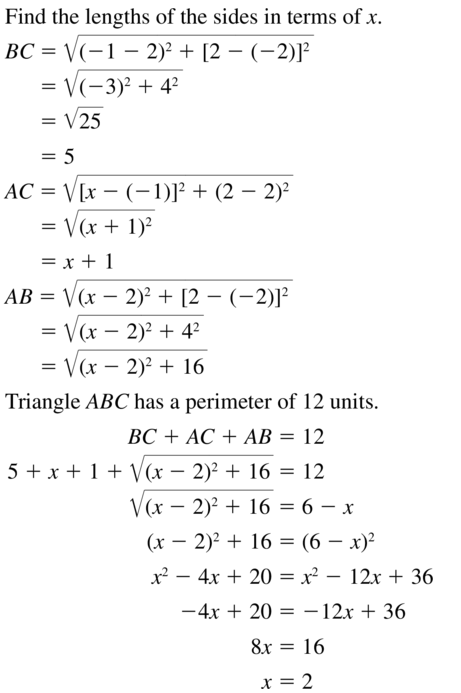
Maintaining Mathematical Proficiency
Solve the equation.
Question 38.
3x – 7 = 2
Answer:
x = 3,
Explanation:
The given equation is 3x – 7 = 2,
So 3x = 2 + 7,
3x = 9,
x = \(\frac{9}{3}\),
x = 3, We can conclude that the value of x to the given equation is 3.
Question 39.
5x + 9 = 4
Answer:
x = -1,
Explanation:

Question 40.
x + 4 = x – 12
Answer:
No solution,
Explanation:
The given equation is
x + 4 = x – 12,
x – x + 4 = -12,
4 = -12, Hence from the above we can conclude that the given equation has no solution.
Question 41.
4x- 9 = 3x + 5
Answer:
x = 14,
Explanation:

Question 42.
11 – 2x = 5x – 3
Answer:
The value of x to the given equation is 2,
Explanation:
The given equation is 11 – 2x = 5x – 3, 11 + 3 = 5x + 2x
7x = 14, x = \(\frac{14}{7}\), x = 2, Hence from the above we can conclude that the value of x to the given equation is 2.
Question 43.
\(\frac{x+1}{2}\) = 4x – 3
Answer:
x = 1,
Explanation:

Question 44.
Use a compass and straightedge to construct a copy of the line segment.

Answer:
The steps used to construct a line segment are:
Step 1:
We are given line segment AB to copy.
Step 2:
Draw a line segment that is longer than line segment AB. Label one of its endpoints C.
Step 3:
Open your compass so that the anchor is on one endpoint of line segment AB and the pencil point is on the other endpoint.
Explanation:
Used a compass and straightedge to construct a copy of the line segment.
1.5 Measuring and Constructing Angles
Essential Question
How can you measure and classify an angle?
Answer:
“Angle” will be measured by using a protractor,
Explanation:
An angle is formed when two rays have the same endpoint or vertex.
An “Angle” will be measured by using a protractor,
Classification of angles: An angle can be classified according to the size of the opening between its rays.
An acute angle measures greater than 0° and less than 90°.
A right-angle forms a square corner and measures 90°.
An obtuse angle measures greater than 90° and less than 180°.
Exploration 1
Measuring and Classifying Angles
Work with a partner: Find the degree measure of each of the following angles. Classify each angle as acute, right, or obtuse.

a. ∠AOB
b. ∠AOC
c. ∠BOC
d. ∠BOE
e. ∠COE
f. ∠COD
g. ∠BOD
h. ∠AOE
Answer:
a. ∠AOB = 35°, Acute,
b. ∠AOC = 65°, Acute,
c. ∠BOC = 30°, Acute,
d. ∠BOE = 110°, Obtuse,
e. ∠COE = 80°, Acute,
f. ∠COD = 5°, Acute,
g. ∠BOD = 35°, Acute,
h. ∠AOE = 145°, Obtuse,
Explanation:
a. ∠AOB, From the above figure ∠AOB = 35°,
We know that the angle that is greater than 0° and less than 90° is an “Acute angle”.
Hence ∠AOB is an acute angle.
b. ∠AOC, From the above figure ∠AOC = 65°,
We know that the angle that is greater than 0° and less than 90° is an “Acute angle”.
Hence ∠AOC is an acute angle.
c. ∠BOC, From the above figure ∠BOC = |65° – 35°| = 30°,
We know that the angle that is greater than 0° and less than 90° is an “Acute angle”.
Hence ∠BOC is an acute angle.
d. ∠BOE, From the above figure ∠BOE = |145° – 35°| = 110°,
We know that the angle that is greater than 90° and less than 180° is an “Obtuse angle”.
Hence ∠BOE is an obtuse angle.
e. ∠COE,From the above figure ∠COE = |145° – 65°| = 80°,
We know that the angle that is greater than 0° and less than 90° is an “Acute angle”.
Hence ∠COE is an acute angle.
f. ∠COD, From the above figure ∠COD =|70° – 65°| = 5°,
We know that the angle that is greater than 0° and less than 90° is an “Acute angle”.
Hence ∠COD is an acute angle.
g. ∠BOD, From the above figure ∠BOD = |70° – 35°| = 35°,
We know that the angle that is greater than 0° and less than 90° is an “Acute angle”,
Hence ∠BOD is an acute angle.
h. ∠AOE, From the above figure ∠AOE = 145°,
We know that the angle that is greater than 90° and less than 180° is an “Obtuse angle”,
Hence ∠AOE is an obtuse angle.
Exploration 2
Drawing a Regular Polygon
Work with a partner.
a. Use a ruler and protractor to draw the triangular pattern shown at the right.
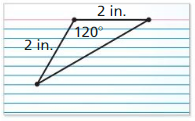
Answer:

Explanation:
The representation of the triangular pattern by using a ruler and a protractor is shown above.
b. Cut out the pattern and use it to draw three regular hexagons

Explanation:
Cutted out the pattern and used it to draw three regular hexagons above.
C. The sum of the angle measures of a polygon with n sides is equal to 180(n – 2)°. Do the angle measures at your hexagons agree with this rule? Explain.
ATTENDING TO PRECISION
To be proficient in math, you need to calculate and measure accurately and efficiently.
Answer:
Yes,
Explanation:
It is given that the sum of the angle measures of a polygon with n sides is equal to 180 (n – 2)°.
This rule will be applicable for all the angle measures of all polygons, Hence we can conclude that the above rule will be applicable for the angle measures of the hexagon.
d. Partition your hexagons into smaller polygons. as shown below. For each hexagon. find the sum of the angle measures of the smaller polygons Does each sum equal the sum of the angle measures of a hexagon? Explain.

Answer:
1. 360°,
2. 240°,
3. 120°,
Explanation:
We know that if a polygon is divided into n partitions, then the angle measures of that polygon will also be divided into n partitions. So The sum of the angle measures of hexagon = 180(n – 2)°,
= 180 ( 6 – 2 )° = 720°,
So, In the first figure, the polygon is divided into 2 partitions So,
The sum of the angle measures of each partition = 720 / 2 = 360°,
In the second figure, the polygon is divided into 3 partitions,
So, The sum of the angle measures of each partition = 720 / 3 = 240°,
In the third figure, the polygon is divided into 6 partitions,
So, The sum of the angle measures of each partition = 720 / 6 = 120°.
Communicate Your Answer
Question 3.
How can you measure and classify an angle?
Answer:
“Angle” will be measured by using a protractor,
Explanation:
An angle is formed when two rays have the same endpoint or vertex.
An “Angle” will be measured by using a protractor,
Classification of angles: An angle can be classified according to the size of the
opening between its rays. An acute angle measures greater than 0° and less
than 90°. A right-angle forms a square corner and measures 90°.
An obtuse angle measures greater than 90° and less than 180°
Lesson 1.5 Measuring and Constructing Angles
Monitoring Progress
Write three names for the angle.
Question 1.

Answer:
∠Q, ∠PQR, and ∠RQP,
Explanation:
An “Angle” is formed when two rays have the same endpoint or vertex.
So here the angle is Q, Hence, The three names for the given angle are: ∠Q, ∠PQR, and ∠RQP.
Question 2.

Answer:
∠1, ∠XYZ, and ∠ZYX,
Explanation:
An “Angle” is formed when two rays have the same endpoint or vertex.
So, Here, the angle is Y, Hence,The three names for the given angle are: ∠1, ∠XYZ, and ∠ZYX.
Question 3.
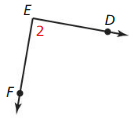
Answer:
∠2, ∠FED, and ∠DEF,
Explanation:
An “Angle” is formed when two rays have the same endpoint or vertex.
So, Here, the angle is E. Hence, The three names for the given angle are: ∠2, ∠FED, and ∠DEF.
Use the diagram in Example 2 to find the angle measure. Then classify the angle.
Question 4.
∠JHM
Answer:
∠JHM = 145°, ∠JHM is an obtuse angle,
Explanation:
From the above figure ∠JHM =|145° – 0°| = 145°,
We know that the angle that is greater than 90° and less than 180° is an “Obtuse angle”.
Hence ∠JHM is an obtuse angle.
Question 5.
∠MHK
Answer:
∠MHK = 110°, ∠MHK is an obtuse angle,
Explanation:
From the above figure ∠MHK =|145° – 55°| = 110°,
We know that the angle that is greater than 90° and less than 180° is an “Obtuse angle”
Hence ∠MHK is an obtuse angle.
Question 6.
∠MHL
Answer:
∠MHL = 55°, ∠MHL is an acute angle,
Explanation:
From the above figure ∠MHL =|145° – 90°| = 55°,
We know that the angle that is greater than 0° and less than 90° is an “Acute angle”,
Hence ∠MHL is an acute angle.
Question 7.
Without measuring, is ∠DAB ≅ ∠FEH in Example 3? Explain your reasoning. Use a protractor to verify your answer.
Answer:
From the given figure ∠DAB is not congruent to ∠FEH,
Explanation:
We can observe that ∠DAB ≅ 90°, ∠FEH > 90°,
Hence from the above we can conclude that ∠DAB is not congruent to ∠FEH.
Find the indicated angle measures.
Question 8.
Given that ∠KLM is a straight angle. find in ∠KLN and, m∠NLM.
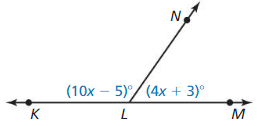
Answer:
∠KLN = 125°, ∠NLM = 55°,
Explanation:
Applying Angle Addition Postulate:
If point B lies in the interior of angle AOC, then. the postulate describes that putting two angles side by side with their vertices together creates a new angle whose measure equals the sum of the measures of the two original angles. It is given that ∠KLM is a straight angle,
So ∠KLM = 180°,
180° = (10x – 5)° + (4x + 3)°,
180° = (14x -2)°,
180 + 2 = 14x,
14x = 182,
x = \(\frac{182}{14}\),
x = 13°, As
∠KLN = (10x – 5)°,
= 10 (13) – 5,
= 130 – 5,
= 125°,
∠NLM = (4x + 3)°,
= 4 (13) + 3,
= 52 + 3,
= 55°, Hence from the above we can conclude that ∠KLN and ∠NLM are 125° and 55° respectively.
Question 9.
Given that ∠EFG is a right angle. find, m∠EFH and m∠HFG.

Answer:
∠EFH = 60°, ∠HFG = 30°,
Explanation:
Applying Angle Addition Postulate:
If point B lies in the interior of angle AOC, then. the postulate describes that putting two angles side by side with their vertices together creates a new angle whose measure equals the sum of the measures of the two original angles, It is given that ∠EFG is a right angle. So ∠EFG = 90°,
90° = (2x + 2)° + (x + 1)°,
90° = (3x + 3)°,
90 – 3 = 3x,
3x = 87,
x = \(\frac{87}{3}\),
x = 29°,
So ∠EFH = (2x + 2)°,
= 2 (29) + 2,
= 58 + 2,
= 60°,
∠HFG = (x + 1)°,
= 29 + 1,
= 30°
Hence from the above we can conclude that ∠EFH and ∠HFG are 60° and 30° respectively.
Question 10.
Angle MNP is a straight angle, and \(\vec{N}\)Q bisects ∠MNP. Draw ∠MNP and \(\vec{N}\)Q. Use arcs to mark the congruent angles in your diagram. Find the angle measures of these congruent angles.
Answer:
The angle measure of each congruent angle is 55.3°,
Explanation:
It is given that angle MNP is a straight angle and \(\vec{N}\)Q bisects ∠MNP. Draw ∠MNP and \(\vec{N}\)Q, So the representation of the above statement is:

Hence from the above we can conclude that the angle measure of each congruent angle is 55.3°.
Exercise 1.5 Measuring and Constructing Angles
Vocabulary and Core Concept Check
Question 1.
COMPLETE THE SENTENCE
Two angles are __________ angles when they have the same measure.
Answer:
Congurent,
Explanation:

Question 2.
WHICH ONE DOES DOESN’T BELONG?
Which angle name does not belong with the other three? Explain your reasoning.

∠BCA
∠BAC
∠1
∠CAB
Answer:
∠BCA doesn’t belong with the other three,
Explanation:
We know that an angle can be defined as the figure formed by two rays meeting at a common endpoint
So, From the given figure A, B, and C are the given angles,
In ∠BCA, C is the angle,
In ∠BAC, A is the angle,
In ∠1, A is the angle,
In ∠CAB, A is the angle,
Hence from the above we can conclude that ∠BCA doesn’t belong with the other three.
Monitoring Progress and Modeling with Mathematics
In Exercises 3 – 6. write three names for the angle.
Question 3.

Answer:
∠B, ∠ABC, ∠CBA,
Explanation:

Question 4.
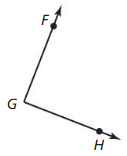
Answer:
∠G, ∠FGH, ∠HGF,
Explanation:
We know that an angle can be defined as the figure formed by two rays meeting at a common endpoint
Hence the names for the given angle are ∠G,∠FGH and ∠HGF ,
Question 5.
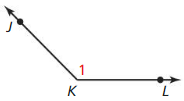
Answer:
∠K or ∠1, ∠JKL, ∠LKJ,
Explanation:

Question 6.
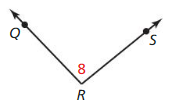
Answer:
∠8 or ∠R, ∠QRS, ∠SRQ
Explanation:
We know that an angle can be defined as the figure formed by two rays meeting at a common endpoint, Hence the names for the given angle are ∠8 or ∠R, ∠QRS, ∠SRQ.
In Exercises 7 and 8, name three different angles in the diagram.
Question 7.
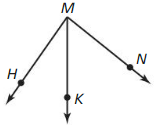
Answer:
∠HMN, ∠HMK, ∠KMN,
Explanation:

Question 8.
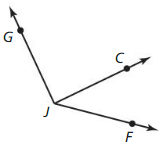
Answer:
∠GJF, ∠CJF, ∠CJG,
Explanation:
We know that an angle can be defined as the figure formed by two rays meeting at a common endpoint,
Hence the three different angles are ∠GJF, ∠CJF ∠CJG.
In Exercises 9 – 12 find the angle measure. Then classify the angle.
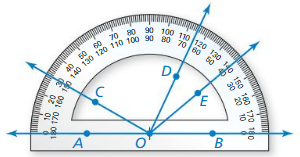
Question 9.
m∠AOC
Answer:
m∠AOC = 30°, Acute,
Explanation:

Question 10.
m∠BOD
Answer:
m∠BOD = 65°, Acute,
Explanation:
From the above figure ∠BOD = |0° – 65°| = 65°, We know that the angle that is greater than 0° and less than 90° is an “Acute angle”, Hence ∠BOD is an acute angle.
Question 11.
m∠COD
Answer:
m∠COD = 85°, Acute,
Explanation:

Question 12.
m∠EOD
Answer:
m∠EOD = 25°, Acute,
Explanation:
From the above figure ∠EOD = |40° – 65°| = 25°,
We know that the angle that is greater than 0° and less than 90° is an “Acute angle”, Hence ∠EOD is an acute angle.
ERROR ANALYSIS
In Exercises 13 and 14. describe and correct the error in finding the angle measure. Use the diagram from Exercises 9 – 12.
Question 13.

Answer:
Oter scale was used, m∠BOC = 30°,
Explanation:

Question 14.

Answer:
m∠DOE = 25° not 65°,
Explanation:
From the given figure we can observe that ∠D is at 40° and ∠E is at 65°,
So ∠DOE = |40° – 65°| = 25°, Hence ∠DOE = 25°.
CONSTRUCTION
In Exercises 15 and 16. use a compass and straightedge to copy the angle.
Question 15.
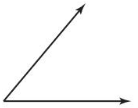
Answer:
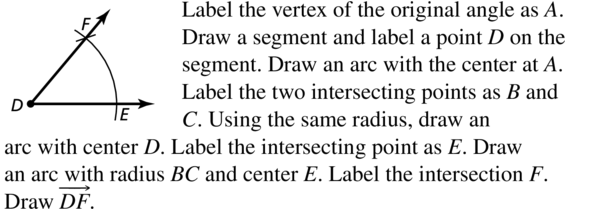
Explanation:
Used a compass and straightedge to copy the angle as shown above.
Question 16.

Answer:
The steps to copy the angle are:
Step 1: Labelled the vertex of the original angle as A. Draw a segment and label a point D on the segment.
Step 2: Drawn an arc with the center at A. Label the two intersecting points as B and C.
Step 3: Using the same radius, draw an arc with center D. Label the intersecting point as E.
Step 4: Drawn an arc with radius BC and center E. Label the intersection F.
Step 5: Drawn \(\overline{D F}\),
Explanation:
Used a compass and straightedge to copy the angle as shown above.
In Exercises 17 – 20, in m∠AED = 34° and m∠EAD = 112°.

Question 17.
Identify the angles congruent to ∠AED.
Answer:
∠EDA, ∠BDC, ∠BCD,
Explanation:

Question 18.
Identify the angles congruent to ∠EAD.
Answer:
∠DBC, ∠ADB, ∠DAE,
Explanation:
From the given figure the angles congruent to ∠EAD are ∠DBC, ∠ADB and ∠DAE.
Question 19.
Find m∠BDC.
Answer:
∠BDC = 34°,
Explanation:
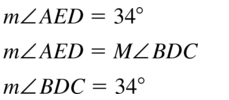
Question 20.
Find m∠ADB.
Answer:
∠ADB = 112°,
Explanation:
From the given figure ∠EAD = 112°, Hence by the property of Congruence ∠EAD ≡ ∠ADB
Hence from the above we can conclude that ∠ADB = 112°.
In Exercises 21 – 24, find the indicated angle measure.
Question 21.
Find m∠ABC.
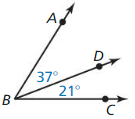
Answer:
m∠ABC = 58°,
Explanation:

Question 22.
Find m∠LMN.

Answer:
m∠LMN = 108°,
Explanation:
By using the Angle Addition postulate ∠LMN = ∠LMP + ∠PMN,
∠LMN = 85° + 23°,
∠LMN = 108°.
Question 23.
m∠RST = 114°. Find m∠RSV.
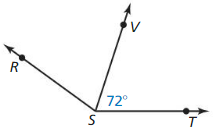
Answer:
m∠RSV = 42°,
Explanation:

Question 24.
∠GHK is a straight angle. Find m∠LHK.
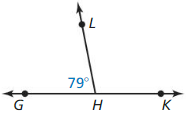
Answer:
∠LHK = 101°,
Explanation:
By using the Angle Addition Postulate ∠GHK = ∠GHL + ∠LHK,
It is given that ∠GHK is a straight line. So ∠GHK = 180°,
180° = 79° + ∠LHK,
∠LHK = 180° – 79°,
∠LHK = 101°,
Hence from the above we can conclude that ∠LHK = 101°.
In Exercises 25 – 30. find the indicated angle measures.
Question 25.
m∠ABC = 95°. Find m∠ABD and m∠DBC.

Answer:
m∠ABD = 37°, m∠DBC = 58°,
Explanation:
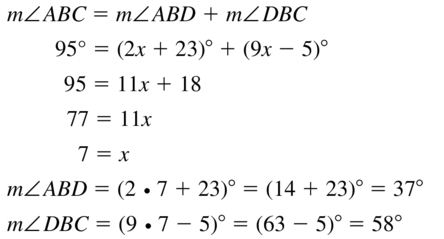
Question 26.
m∠XYZ = 117°. Find m∠XYW and m∠WYZ
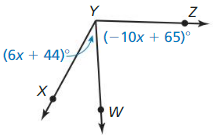
Answer:
m∠XYW = 32°, m∠WYZ = 85°,
Explanation:
By using the Angle Addition Postulate ∠XYZ = ∠XYW + ∠WYZ,
It is given that ∠XYZ = 117°, So 117° = (6x + 44)° + (-10x + 65)°,
117° = (-4x + 109)°,
-4x = 117 – 109,
-4x = 8,
x = \(\frac{-8}{4}\),
x = -2, Hence ∠XYW = (6x + 44)°
= 6 (-2) + 44,
= 44 – 12,
= 32°,
∠WYZ = (-10x + 65)°,
= -10 (-2) + 65,
= 20 + 65,
= 85°, Hence from the above we can conclude that ∠XYW = 32° and ∠WYZ = 85°.
Question 27.
∠LMN is a straight angle. Find m∠LMP and m∠NMP
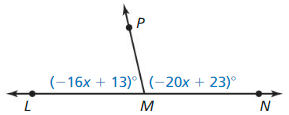
Answer:
m∠LMP = 77°, m∠PMN = 103°,
Explanation:
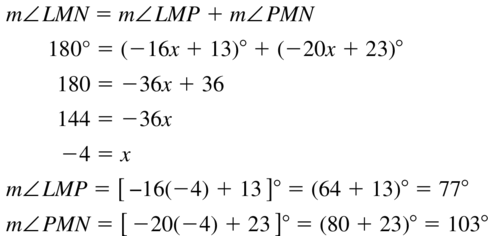
Question 28.
∠ABC is a straight angle. Find m∠ABX and m∠CBX.

Answer:
m∠ABX = 112°, m∠CBX = 68°,
Explanation:
From the Angle Addition Postulate ∠ABC = ∠ABX + ∠CBX,
It is given that ∠ABC is a straight angle. So ∠ABC = 180°,
180° = (14x + 70)° + (20x + 8)°,
180° = 34x + 78,
180 – 78 = 34x,
34x = 102°,
x = \(\frac{102}{34}\),
x = 3°, So ∠ABX = (14x + 70)°,
= 14 (3) + 70,
= 42 + 70,
= 112°,
∠CBX = (20x + 8)°,
= 20 (3) + 8,
= 60 + 8,
= 68°, Hence from the above we can conclude that ∠ABX = 112° and ∠CBX = 68°.
Question 29.
Find m∠RSQ and M∠TSQ.

Answer:
m∠RSQ = 32° and m∠QST = 58°,
Explanation:

Question 30.
Find m∠DEH and m∠FEH.
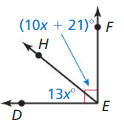
Answer:
m∠DEH = 39°, m∠FEH = 51°,
Explanation:
From the Angle Addition Postulate ∠DEF = ∠DEH + ∠FEH,
From the figure we can observe that ∠DEF is a right angle,
So ∠DEF = 90°,
90° = 13x° + (10x + 21)°,
90° = 23x + 21,
90 – 21 = 23x,
23x = 69°,
x = \(\frac{69}{23}\),
x = 3°,
So ∠DEH = 13x°,
= 13 (3),
= 39°,
∠FEH = (10x + 21)°,
= 10 (3) + 21,
= 30 + 21,
= 51°, Hence from the aboven we can conclude that m∠DEH = 39° and m∠FEH = 51°.
CONSTRUCTION
In Exercises 31 and 32. copy the angle. Then construct the angle bisector with a compass and straightedge.
Question 31.
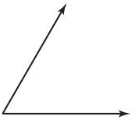
Answer:
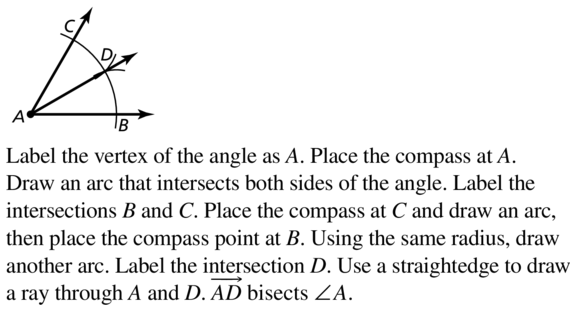
Explanation:
constructed the angle bisector with a compass and straightedge above.
Question 32.

Answer:
The steps for the construction of the angle bisector and copying of the angle is:
Step 1: Labelled the vertex of the angle as A. Place the compass at A.
Step 2: Drawn an arc that intersects both sides of the angle. Label the intersections B and C.
Step 3: Placed the compass at C and draw an arc, then place the compass point at B. Using the same radius, draw another arc. Label the intersection D.
Step 4: Used a straightedge to draw a ray through A and D.
Step 5: \(\overline{A D}\) bisects ∠A
Explanation:
Constructed the angle bisector with a compass and straightedge.
In Exercises 33 – 36, \(\vec{Q}\)S bisects ∠PQR. Use the diagram and the given angle measure to find the indicated angle measures.
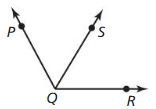
Question 33.
m∠PQS = 63°. Find m∠RQS and m∠PQR.
Answer:
m∠RQS = 63° and m∠PQR = 126°,
Explanation:

Question 34.
m∠RQS = 71°. Find m∠PQS and m∠PQR.
Answer:
m∠PQS = 71° and m∠PQR = 142°,
Explanation:
We know that an “Angle Bisector” makes the two angles congruent i.e., equal,
So from the above figure we can say that ∠PQS = ∠RQS,
Now by using the Angle Addition Postulate ∠PQR = ∠PQS + ∠RQS,
It is given that ∠RQS = 71°,
So ∠PQS = 71°,
∠PQR = 71 + 71 = 142°,
Hence, from the above we can conclude that m∠PQS = 71° and m∠PQR = 142°.
Question 35.
m∠PQR = 124°. Find m∠PQS and m∠RQS.
Answer:
m∠PQS = 62° and m∠RQS = 62°,
Explanation:

Question 36.
m∠PQR = 119°. Find m∠PQS and m∠RQS.
Answer:
m∠PQS = 59.5°, m∠RQS = 59.5°,
Explanation:
We know that an “Angle Bisector” makes the two angles congruent i.e., equal
So from the above figure we can say that ∠PQS = ∠RQS
Now by using the Angle Addition Postulate ∠PQR = ∠PQS + ∠RQS,
It is given that ∠PQR = 119°, So
119° = 2 (∠PQS), ∠PQS = 59.5°, Hence from the above we can conclude that m∠PQS = 59.5° and m∠RQS = 59.5°.
In Exercises 37 – 40, \(\overrightarrow{B D}\) bisects ∠ABC. Find m∠ABD, m∠CBD, and m∠ABC.
Question 37.

Answer:
m∠ABD = 44°, m∠DBC = 44°, m∠ABC = 88°,
Explanation:

Question 38.

Answer:
∠ABC = 48°, ∠ABD = 24°, ∠CBD = 24°,
Explanation:
It is given that \(\overrightarrow{B D}\) bisects ∠ABC,
So by using the bisector property ∠ABD = ∠DBC,
So (3x + 6)° = (7x – 18)°,
3x – 7x = -18 – 6,
-4x = -24,
4x = 24,
x = \(\frac{24}{4}\),
x = 6°,
So ∠ABD = (3x + 6)°
= 3 (6) + 6,
= 18 + 6,
= 24°,
∠DBC = (7x – 18)°,
= 7 (6) – 18,
= 42 – 18,
= 24°, ∠ABC = ∠ABD + ∠DBC,
= 24 + 24 = 48°, Hence from the above we can conclude that ∠ABC = 48°, ∠ABD = 24°, and ∠CBD = 24°.
Question 39.
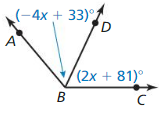
Answer:
m∠ABD = 65°, m∠CBD = 65°, and m∠ABC = 130°,
Explanation:
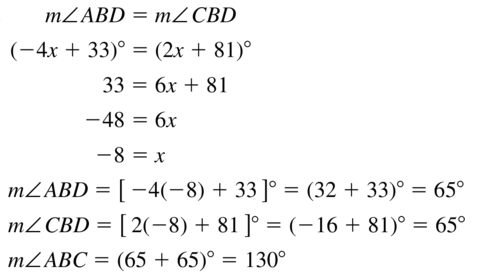
Question 4o.

Answer:
∠ABC = 134°, ∠ABD = 67°, ∠CBD = 67°,
Explanation:
It is given that \(\overrightarrow{B D}\) bisects ∠ABC,
So by using the bisector property ∠ABD = ∠DBC,
So (8x + 35)° = (11x + 23)°,
8x – 11x = 23 – 35,
-3x = -12,
3x = 12,
x = \(\frac{12}{3}\),
x = 4°,
So ∠ABD = (8x + 35)°,
= 8 (4) + 35,
= 32 + 35,
= 67°,
∠DBC = (11x + 23)°,
= 11 (4) + 23,
= 44 + 23,
= 67°,
∠ABC = ∠ABD + ∠DBC,
= 67 + 67 = 134°, Hence from the above we can conclude that ∠ABC = 134°, ∠ABD = 67° and ∠CBD = 67°.
Question 41.
WRITING
Explain how to find m∠ABD when you are given m∠ABC and m∠CBD.

Answer:
Angle Addition Postulate,
Explanation:

Question 42.
ANALYZING RELATIONSHIPS
The map shows the intersections of three roads. Malcolm Way intersects Sydney Street at an angle of 162°. Park Road intersects Sydney Street at an anÌe of 87°. Find the angle at which Malcom Way intersects Park Road.
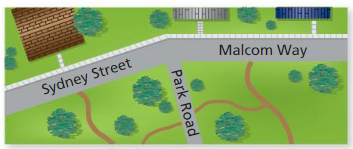
Answer:
Malcolm Way intersects Park Road is 75°,
Explanation:
It is given that Malcolm Way intersects Sydney Street at an angle of 162°.
Park Road intersects Sydney Street at an anÌe of 87°. From the figure we can observe that
The angle between Malcolm Way and Sydney street = The angle between Sydney street and Park Road + The angle between Malcolm way and Park road,
So 162° = 87° + The angle between Malcolm way and Park Road,
The angle between Malcolm Way and Park Road = 162 – 87,
The angle between Malcolm Way and Park Road = 75°,
Hence, from the above we can conclude that the angle at which Malcolm Way intersects Park Road is 75°.
Question 43.
ANALYZING RELATIONSHIPS
In the sculpture shown in the photograph. the measure of ∠LMN is 76° and the measure of ∠PMN is 36°. What is the measure of ∠LMP?
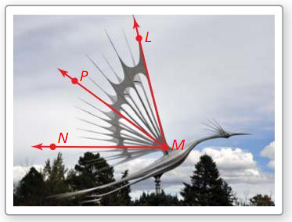
Answer:
m∠LMP = 40°,
Explanation:

USING STRUCTURE
In Exercise 44 – 46. use the diagram of the roof truss.
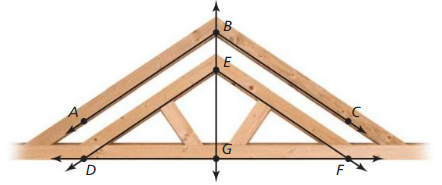
Question 44.
In the roof truss, \(\vec{B}\)G bisects ∠ABC and ∠DEF. m∠ABC = 112°. and ∠ABC ≅ ∠DEF Find the measure of each angle.
a. m∠DEF
Answer:
m∠DEF = 112°,
Explanation:
It is given that \(\vec{B}\)G bisects ∠ABC and ∠DEF,
It is also given that ∠ABC = ∠DEF, As ∠ABC = 112°. Hence m∠DEF = 112°.
b. m∠ABG
Answer:
m∠ABG = 56°,
Explanation:
It is given that \(\vec{B}\)G bisects ∠ABC and ∠DEF,
So for ∠ABC by congruence property ∠ABG = ∠CBG,
Hence ∠ABG = ∠ABC / 2,
= 112 / 2,
= 56°.
c. m∠CBG
Answer:
m∠CBG = 56°,
Explanation:
It is given that \(\vec{B}\)G bisects ∠ABC and ∠DEF,
So for ∠ABC, By congruence property ∠ABG = ∠CBG,
Hence ∠CBG = ∠ABC / 2,
= 112 / 2,
= 56°. So m∠CBG = 56°.
d. m∠DEG
Answer:
m∠DEG = 56°,
Explanation:
It is given that \(\vec{B}\)G bisects ∠ABC and ∠DEF,
So for ∠DEF, By congruence property ∠DEG = ∠EGF
Hence ∠DEG = ∠DEF / 2,
= 112 / 2 = 56°, So m∠DEG = 56°.
Question 45.
In the roof truss, ∠DGF is a straight angle, and \(\vec{G}\)B bisects ∠DGF Find m∠DGE and m∠FGE.
Answer:
m∠DGE = 90°, m∠FGE = 90°,
Explanation:

Question 46.
Name an example of each of the four types of angles according to their measures in the diagram.
Answer:
Acute angle, Obtuse angle, Straight angle, Right angle,
Explanation:
There are 4 types of angles. They are:
a. Acute angle:
The angle that is greater than 0° and less than 90° is an “Acute angle”.
b. Obtuse angle:
The angle that is greater than 90° and less than 180° is an “Obtuse angle”.
c. Straight angle:
The angle 180° is called a “Straight angle”.
d. Right angle:
The angle 90° is called a “Right angle”.
MATHEMATICAL CONNECTIONS
47. In ∠ABC. \(\vec{B}\)X is in the interior of the angle. m∠ABX is 12 more than 4 times m∠CBX. and in m∠ABC = 92°.
a. Draw a diagram to represent the situation.
b. Write and solve an equation to find m∠ABX and, m∠CBX.
Answer:
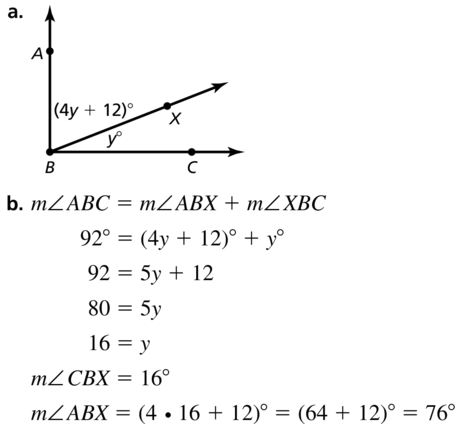
Explanation:
a. Drawn a diagram to represent the situation as shown above,
b. Wrote and solved an equation to find m∠ABX and m∠CBX as m∠ABC = m∠ABX + m∠XBC.
Question 48.
THOUGHT-PROVOKING
The angle between the minute hand and the hour hand of a clock is 90° What time is it? Justify your answer.
Answer:
3:00 or 9:00,
Explanation:
From the clock we can observe that the angle between the minute hand and the hour hand of a clock is 90°, Then the time will be 3:00 and 9:00.
Question 49.
ABSTRACT REASONING
Classify the angles that result from bisecting each type of angle.
a. acute angle
b. right angle
c. obtuse angle
d. straight angle
Answer:

Explanation:
Classified the angles that result from bisecting each type of angle as
a. acute angle, b. right angle, c. obtuse angle, d. straight angle above.
Question 50.
ABSTRACT REASONING
Classify the angles that result from drawing a ray in the interior of each type of angle. Include all possibilities and explain your reasoning.
a. acute angle
b. right angle
c. obtuse angle
d. straight angle
Answer:
a. Acute angle is greater than 0° and less than 90°,
b. Right angle is 90°,
c. Obtuse angle greater than 90° and less than 180°,
d. Straight angle is 180°,
Explanation:
The classification of angles that result from drawing a ray in the interior of each type of angle is: a. Acute angle: The angle that is greater than 0° and less than 90° is an “Acute angle”,
b. Right angle: The angle 90° is called a “Right angle”,
c. Obtuse angle: The angle that is greater than 90° and less than 180° is an “Obtuse angle”,
d. Straight angle: The angle 180° is called a “Straight angle”.
Question 51.
CRITICAL THINKING
The ray from the origin through (4, 0) forms one side of an angle. Use the numbers below as x- and y-coordinates to create each type of angle in a coordinate plane.
– 2 – 1 0 1 2
a. acute angle
b. right angle
c. obtuse angle
d. straight angle
Answer:
a. Point (2,1) creates an acute angle,
b. Point (0,2) creates an right angle,
c. Point (-1,2) creates an obtuse angle,
d. Point (-2,0) creates an straight angle,
Explanation:
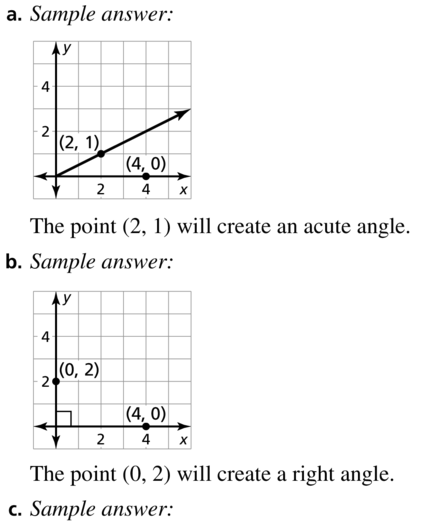
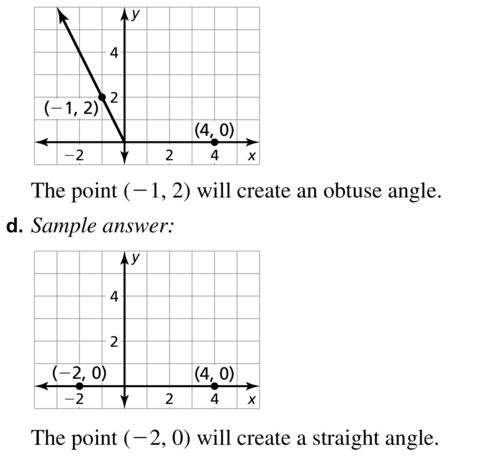
Question 52.
MAKING AN ARGUMENT
Your friend claims it is possible for a straight angle to Consist of two obtuse angles. Is your friend correct? Explain your reasoning.
Answer:
No, My friend is not correct,
Explanation:
We know that a straight angle consists of 2 Right angles or a Right angle and an obtuse angle
So the claim of your friend which is a straight angle consists of two obtuse angles is not correct. Hence from the above we can conclude that the claim of my friend is not correct.
Question 53.
CRITICAL THINKING
Two acute angles are added together. What type(s) of angle(s) do they form? Explain your reasoning.
Answer:
Acute angle, right angle or an obtuse angle,
Explanation:

Question 54.
HOW DO YOU SEE IT?
Use the diagram
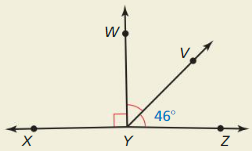
a. Is it possible for ∠XYZ to be a straight angle? Explain your reasoning.
Answer:
Yes,
Explanation:
From the figure ∠XYZ is a flat line i.e., there is no angle,
So ∠XYZ = 0° or 180°,
We know that the line that has an angle of 0° or 180° is called a “Straight line”.
Hence from the above we can conclude that ∠XYZ is a straight angle.
b. What can you change in the diagram so that ∠XYZ is a straight angle?
Answer:
No change already a straight angle,
Explanation:
From the given figure ∠XYZ is already a straight angle, So there is no change to make ∠XYZ a straight line.
Question 55.
WRITING
Explain the process of bisecting an angle in your own words. Compare it to bisecting a segment.
Answer:
To bisect a segment or an angle means to divide it into two congruent parts.
A bisector of a line segment will pass through the midpoint of the line segment.
A perpendicular bisector of a segment passes through the midpoint of the
line segment and is perpendicular to the line segment.
Explanation:

Question 56.
ANALYZING RELATIONSHIPS
\(\vec{S}\)Q bisects ∠RST, \(\vec{S}\)P bisects ∠RSQ. and \(\vec{S}\)V bisects ∠RSP. The measure of ∠VSP is 17°. Find in m∠TSQ. Explain.
Answer:
Question 57.
ABSTRACT REASONING
A bubble level is a tool used
to determine whether a surface is horizontal. like the top of a picture frame. If the bubble is not exactly in the middle when the level is placed on the surface. then the surface is not horizontal. What is the most realistic type of angle Formed by the level and a horizontal line when the bubble is not in the middle? Explain your reasoning.

Answer:
Acute angle,
Explanation:

Maintaining Mathematical Proficiency
Solve the equation.
Question 58.
x + 67 = 180
Answer:
x = 113,
Explanation:
The given equation is x + 67 = 180,
So x = 180 – 67, x = 113. Hence from the above we can conclude that the value of x is 113.
Question 59.
x + 58 = 90
Answer:
x = 32,
Explanation:
The given equation is x + 58 = 90,
So x = 90 – 58, x = 32. Hence from the above we can conclude that the value of x is 32.
Question 60.
16 + x = 90
Answer:
x = 74,
Explanation:
The given equation is 16 + x = 90,
So x = 90 – 16, x = 74, Hence from the above we can conclude that the value of x is 74.
Question 61.
109 + x = 180
Answer:
x = 71,
Explanation:
The given equation is 109 + x = 180,
So x = 180 – 109, x = 71, Hence from the above we can conclude that the value of x is 71.
Question 62.
(6x + 7) + (13x + 21) = 180
Answer:
x = 8,
Explanation:
The given equation is (6x + 7) + (13x + 21) = 180,
So 19x + 28 = 180,
19x = 180 – 28,
19x = 152,
x = \(\frac{152}{9}\),
x = 8,
Hence from the above we can conclude that the value of x is 8.
Question 63.
(3x + 15) + (4x – 9) = 90
Answer:
x = 12,
Explanation:
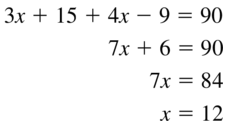
Question 64.
(11x – 25) + (24x + 10) = 90
Answer:
x = 3,
Explanation:
The given equation is (11x – 25) + (24x + 10) = 90,
So 35x – 15 = 90,
35x = 90 + 15,
35x = 105,
x = \(\frac{105}{35}\),
x = 3, Hence from the above we can conclude that the value of x is 3.
Question 65.
(14x – 18) + (5x + 8) = 180
Answer:
x = 10,
Explanation:

1.6 Describing Pairs of Angles
Essential Question
How can you describe angle pair relationships and use these descriptions to find angle measures?
Answer:
A supplementary angles pair is when two angles add together to 180-degrees,
Explanation:
Two adjacent angles are a linear pair when their non-common sides are opposite rays. The angles in a linear pair are supplementary angles. common side L1+22=180°. Two angles are vertical angles when their sides form two pairs of opposite rays.
Exploration 1
Work with a partner: The five-pointed star has a regular pentagon at its center.
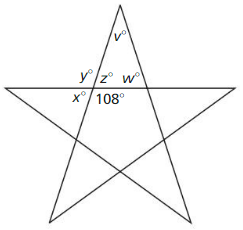
a. What do you notice about the following angle pairs?
x° and y°
Answer:
“Adjacent angles”
Explanation:
From the given figure x and y share a common line,
We know that the angles that share a common side are called “Adjacent angles”,
Hence x° and y° are called “Adjacent angles”
y° and z°
Answer:
“Adjacent angles”,
Explanation:
From the given figure y and z share a common line,
We know that the angles that share a common side are called “Adjacent angles”,
Hence y° and z° are called “Adjacent angles”,
x° and z°
Answer:
“Vertical angles”,
Explanation:
From the given figure x and z share a common vertex,
We know that the angles that share a common vertex are called “Vertical angles”,
Hence x° and z° are called “Vertical angles”.
b. Find the values of the indicated variables. Do not use a protractor to measure the angles.

Explain how you obtained each answer.
Answer:
x° = 72°, y° = 72°, z° = 108°, w° = 72°, v° = 72°,
Explanation:
We know that adjacent angles will always be 180° or 90°,
Vertical angles are equal. So, From the figure we can observe that
x + 108° = 180°,
x° = 180° – 108°,
x° = 72°, Now from the figure we can observe that x and y are the vertical angles,
So y° = 72°. Now from the figure we can observe that y and z are the adjacent angles,
So, y° + z° = 180°,
z° = 180° – 72°, z° = 108°.
Now we know that the vertically opposite angles are equal. So y = v,
So v° = 72°. Now we know that the vertically opposite angles are equal so w = v,
So w° = 72°, Hence from the above we can conclude that the angle measures are
x° = 72°, y° = 72°, z° = 108°, v° = 72° and w° = 72°.
Exploration 2
Finding Angle Measures
Work with a partner: A square is divided by its diagonals into four triangles.

a. What do you notice about the following angle pairs?
a° and b°
Answer:
a° + b° = 90°,
Explanation:
From the above figure we can observe that a° and b° are adjacent angles,
So we can say that a° + b° = 90°.
c° and d°
Answer:
c° + d° = 90°,
Explanation:
From the above figure we can observe that c° and d° are adjacent angles,
So we can say that c° + d° = 90°.
c° and e°
Answer:
c° = e°,
Explanation:
From the above figure we can observe that c and e are the opposite angles,
So, We can say that c° = e°.
b. Find the values of the indicated variables. Do not use a protractor to measure the angles.

Explain how you obtained each answer.
Answer:
Figure = square, c° = 90°, d° = 90°, and e° = 90°,
Explanation:
The given figure is square, So we know that all the angles in the square are 90°,
Hence, from the above we can conclude that c° = 90°, d° = 90°, and e° = 90°.
Communicate Your Answer
Question 3.
How can you describe angle pair relationships and use these descriptions to find angle measures?
Answer:
A supplementary angles pair is when two angles add together to 180-degrees,
Explanation:
Two adjacent angles are a linear pair when their non-common sides are opposite rays. The angles in a linear pair are supplementary angles. common side L1+22=180°. Two angles are vertical angles when their sides form two pairs of opposite rays.
Question 4.
What do you notice about the angle measures of complementary angles, supplementary angles, and vertical angles?
ATTENDING TO PRECISION
To be proficient in math, you need to communicate precisely with others.
Answer:
Complementary angles = 90°,
Supplementary angles = 180°,
Opposite angles : A common side, opposite to each other,
Explanation:
The “Complementary angles” are the angles that the measure of angles is 90°,
The “Supplementary angles” are the angles that the measure of angles is 180°,
The opposite angles are the angles that have a common side and opposite to each other.
Lesson 1.6 Describing Pairs of Angles
Monitoring Progress
In Exercises 1 and 2. use the figure.
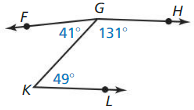
Question 1.
Name a pair of complementary angles, a pair of supplementary angles, and a pair of adjacent angles.
Answer:
The pair of complementary angles are ∠FGK and ∠LKG,
The pair of supplementary angles are ∠HGK and ∠GKL,
The pair of adjacent angles are ∠FGK and ∠HGK,
Explanation:
We know that the pair of angles that the sum of the angle measures is 90° is called “Complementary angles”,
The pair of angles that the sum of the angle measures is 180° is called “Supplementary angles”,
The angle that is the same in more than 1 angle-pair is called “Adjacent Angle”
So from the given figure
The pair of complementary angles are ∠FGK and ∠LKG,
The pair of supplementary angles are ∠HGK and ∠GKL,
The pair of adjacent angles are ∠FGK and ∠HGK,
Question 2.
Are ∠KGH and ∠LKG adjacent angles? Are ∠FGK and ∠FGH adjacent angles? Explain.
Answer:
∠KGH and ∠LKG are not the adjacent angles,
∠FGK and ∠FGH are adjacent angles,
Explanation:
We know that the angle that is the same in more than 1 angle-pair is called “Adjacent Angle”
But, In ∠KGH and ∠LKG, the angle is not the same so ∠KGH and ∠LKG are not the adjacent angles. In ∠FGK and ∠FGH the angle is the same so ∠FGK and ∠FGH are adjacent angles.
Question 3.
∠1 is a complement of ∠2. arid m∠2 = 5°. Find m∠1.
Answer:
∠1 = 85°,
Explanation:
We know that the pair of angles that the sum of the angle measures is 90° is called “Complementary angles”, It is given that ∠1 is a complement of ∠2, So,
∠1 + ∠2 = 90°, It is also given that ∠2 = 5°,
So ∠1 = 90° – ∠2,
∠1 = 90° – 5°,
∠1 = 85°,
Hence from the above we can conclude that ∠1 = 85°.
Question 4.
∠3 is a supplement of ∠4. and m∠3 = 148°. Find m∠4.
Answer:
∠4 = 32°,
Explanation:
We know that the pair of angles that the sum of the angle measures is 180° is called “Supplementary angles”, It is given that ∠3 is a supplement of ∠4,
So ∠3 + ∠4 = 180°, It is also given that ∠3 = 148°,
So ∠4 = 180° – ∠3,
∠4 = 180° – 148°,
∠4 = 32°,
Hence from the above we can conclude that ∠4 = 32°.
Question 5.
∠LMN and ∠PQR are complementary angles. Find the measures of the angles when in m∠LMN = (4x – 2)° and m∠PQR = (9x + 1)°.
Answer:
∠LMN = 26° and ∠PQR = 64°,
Explanation:
We know that the pair of angles that the sum of the angle measures is 90° is called “Complementary angles”, It is given that ∠LMN and ∠PQR are complementary angles,
So ∠LMN + ∠PQR = 90°,
It is also given that ∠LMN = (4x – 2)° and ∠PQR = (9x + 1)°,
So (4x – 2)° + (9x + 1)° = 90°,
13x – 1 = 90°,
13x = 90 + 1,
x = \(\frac{91}{13}\),
x = 7°,
So ∠LMN = (4x – 2)°,
= 4 (7) – 2,
= 28 – 2,
= 26°,
∠PQR = (9x + 1)°,
= 9 (7) + 1,
= 63 + 1,
= 64°,
Hence from the above we can conclude that ∠LMN = 26° and ∠PQR = 64°.
Question 6.
Do any of the numbered angles in the figure form a linear pair? Which angles are vertical angles? Explain your reasoning.
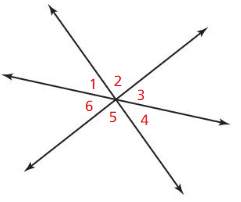
Answer:
The linear pair of angles are ∠1 and ∠2; ∠3 and ∠4; ∠5 and ∠6,
The vertical angles are ∠1 and ∠2; ∠2 and ∠5; ∠3 and ∠6,
Explanation:
From the above figure we can observe that 1, 2, 3, 4, 5, and 6 are the angles,
We know that a linear pair of angles are formed when two lines intersect. Two angles are said to be linear if they are adjacent angles formed by two intersecting lines, Hence
The linear pair of angles in the given figure are ∠1 and ∠2; ∠3 and ∠4; ∠5 and ∠6,
The vertical angles from the given figure are ∠1 and ∠2; ∠2 and ∠5; ∠3 and ∠6.
Question 7.
The measure of an angle is twice the measure of its complement. Find the measure of each angle.

Answer:
∠1 = ∠3 = ∠5 = 30°,
∠2 = ∠4 = ∠6 = 60°,
Explanation:
We know that a linear pair of angles are formed when two lines intersect. Two angles are said to be linear if they are adjacent angles formed by two intersecting lines, So ∠1 and ∠2 (or) ∠3 and ∠4 (or) ∠5 and ∠6 are the complementary angles, It is given that the measure of an angle is twice the measure of its component, Let the angle be x°, So
x + 2x = 90°,
3x = 90°,
x = \(\frac{90}{3}\),
x = 30°,
Hence from the above we can conclude that ∠1 = ∠3 = ∠5 = 30° and ∠2 = ∠4 = ∠6 = 60°.
Question 8.
Two angles form a linear pair. The measure of one angle is 1\(\frac{1}{2}\) times the measure of the other angle. Find the measure of each angle.

Answer:
∠1 = ∠3 = ∠5 = 72°,
∠2 = ∠4 = ∠6 = 108°,
Explanation:
We know that a linear pair of angles are formed when two lines intersect. Two angles are said to be linear if they are adjacent angles formed by two intersecting lines, So ∠1 and ∠2 (or) ∠3 and ∠4 (or) ∠5 and ∠6 are the supplementary angles. It is given that the measure of one angle is 1\(\frac{1}{2}\) times the measure of the other angle,
Let the angle be x°, So
x + 1\(\frac{1}{2}\)x = 180°,
x + \(\frac{3}{2}\)x = 180°,
\(\frac{5x}{2}\) = 180°,
5x = 180° (2),
5x = 360°,
x = \(\frac{360}{5}\),
x = 72°,
Hence from the above we can conclude that ∠1 = ∠3 = ∠5 = 72° and ∠2 = ∠4 = ∠6 = 108°.
Exercise 1.6 Describing Pairs of Angles
Vocabulary and Core Concept Check
Question 1.
WRITING
Explain what is different between adjacent angles and vertical angles.
Answer:
Adjacent angles are two angles that share a common arm and vertex,
Vertical angles are formed when two lines connect at the vertex and form a pair of opposite angles,
Explanation:

Question 2.
WHICH ONE DID DOESN’T BELONG?
Which one does hot belong with the other three? Explain your reasoning.

Answer:
The first figure does not belong with the other three,
Explanation:
The angle that is the same in more than 1 angle-pair and has a common side is called “Adjacent Angle”, So from the above figure we can observe that only the first figure has an adjacent angle whereas all the three figures don’t have any adjacent angles
Hence, from the above, We can conclude that the first figure does not belong with the other three.
Monitoring Progress and Modeling with Mathematics
In Exercises 3-6, use the figure.
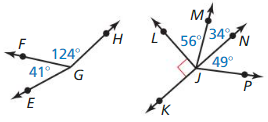
Question 3.
Name a pair of adjacent complementary angles.
Answer:
∠LJM and ∠MJN,
Explanation:

Question 4.
Name a pair of adjacent supplementary angles.
Answer:
A pair of adjacent supplementary angles are ∠LJN + ∠LJK,
Explanation:
We know that the angles that have the sum of the angle measures 180° are called “Supplementary angles, Hence, from the figure pair of adjacent supplementary angles are ∠LJN + ∠LJK.
Question 5.
Name a pair of nonadjacent complementary angles.
Answer:
∠FGE, ∠NJP,
Explanation:

Question 6.
Name a pair of nonadjacent supplementary angles.
Answer:
A pair of nonadjacent supplementary angles are ∠MJP + ∠MJK,
Explanation:
We know that the angles that have the sum of the angle measures 180° are called “Supplementary angles.Hence from the figure a pair of nonadjacent supplementary angles are ∠MJP + ∠MJK ≠ 180°.
In Exercises 7 – 10. find the angle measure.
Question 7.
∠1 is a complement of ∠2, and m∠1 = 23°. Find, m∠2.
Answer:
m∠2 = 67°,
Explanation:
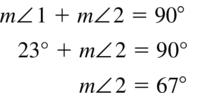
Question 8.
∠3 is a complement of ∠4. and m∠3 = 46°. Find, m∠4.
Answer:
m∠4 = 44°,
Explanation:
We know that the pair of angles that the sum of the angle measures is 90° is called “Complementary angles”, It is given that ∠3 is a complement of ∠4,
So ∠3 + ∠4 = 90°, It is also given that ∠3 = 46°,
So ∠4 = 90° – ∠3,
m∠4 = 90° – 46°,
m∠4 = 44°, Hence from the above we can conclude that m∠4 = 44°.
Question 9.
∠5 is a supplement of ∠6. and m∠5 = 78°. Find m∠6.
Answer:
∠6 = 102°,
Explanation:

Question 10.
∠7 is a supplement of ∠8. and m∠7 = 109°. Find m∠8.
Answer:
m∠8 = 71°,
Explanation:
We know that the pair of angles that the sum of the angle measures is 180° is called “Supplementary angles”, It is given that ∠7 is a supplement of ∠8,
So ∠7 + ∠8 = 180°, It is also given that ∠7 = 109°,
So ∠8 = 180° – ∠7,
m∠8 = 180° – 109°,
m∠8 = 71°, Hence from the above we can conclude that m∠8 = 71°.
In Exercises 11 – 14. find the measure of each angle.
Question 11.
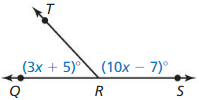
Answer:
m∠QRT = 47°, m∠TRS = 133°,
Explanation:

Question 12.
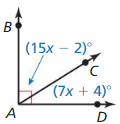
Answer:
∠CAB = 58° and ∠CAD = 32°,
Explanation:
We know that by using the Angle Addition Postulate,∠BAD = ∠CAB + ∠CAD,
From the given figure we can observe that ∠BAD = 90°,
So (15x – 2)° + (7x + 4)° = 90°,
22x + 2 = 90°,
22x = 88°,
x = \(\frac{88}{22}\),
x = 4°,
So ∠CAB = (15x – 2)°,
= 15 (4) – 2,
= 60 – 2,
= 58°,
∠CAD = (7x + 4)°,
= 7 (4) + 4,
= 28 + 4,
= 32°,
Hence from the above we can conclude that ∠CAB = 58° and ∠CAD = 32°.
Question 13.
∠UVW and ∠XYZ arc complementary angles, m∠UVW = (x – 10)°. and m∠XYZ = (4x – 10)°.
Answer:
m∠UVW = 12° and m∠XYZ = 78°,
Explanation:

Question 14.
∠EFG and ∠LMN are supplementary angles. m∠EFG = (3x + 17)°, and m∠LMN = (\(\frac{1}{2} x\) – 5)°
Answer:
∠LMN = 19° and ∠EFG = 161°,
Explanation:
We know that the pair of angles that the sum of the angle measures is 180° is called “Supplementary angles”, It is given that ∠EFG and ∠LMN are supplementary angles,
So ∠LMN + ∠EFG = 180°,
It is also given that ∠LMN = (\(\frac{1}{2} x\) – 5)° and ∠EFG = (3x + 17)°,
So (\(\frac{1}{2} x\) – 5)° + (3x + 17)° = 180°,
\(\frac{7}{2} x\) + 12 = 180°,
\(\frac{7}{2} x\) = 180 – 12,
\(\frac{7}{2} x\) = 168°,
7x = 168 (2),
7x = 336,
x = \(\frac{336}{7}\),
x = 48°,
So ∠LMN = (\(\frac{1}{2} x\) – 5)°,
= \(\frac{1}{2} \) × 48 – 5,
= 24 – 5,
= 19°,
∠EFG = (3x + 17)°,
= 3 (48) + 17,
= 144 + 17,
= 161°,
Hence from the above we can conclude that ∠LMN = 19° and ∠EFG = 161°.
In Exercises 15 – 18. use the figure.

Question 15.
Identify the linear pair(s) that include ∠1.
Answer:
∠1 and ∠5,
Explanation:
Linear pair of angles are formed when two lines intersect each other at a single point. The angles are said to be linear if they are adjacent to each other after the intersection of the two lines. The sum of angles of a linear pair is always equal to 180°, So

Question 16.
Identify the linear pair(s) that include ∠7.
Answer:
∠6 and ∠7, ∠7 and ∠8,
Explanation:
We know that the angle that is the same in more than 1 angle-pair is called “Adjacent Angle”
Hence from the figure we can conclude that the linear pairs that include ∠7 are ∠6 and ∠7, ∠7 and ∠8.
Question 17.
Are ∠6 and ∠8 vertical angles? Explain your reasoning.
Answer:
Yes,
Explanation:

Question 18.
Are ∠2 and ∠5 vertical angles? Explain your reasoning.
Answer:
Yes,
Explanation:
We know that the angles that have the same vertex are called “Vertical angles”,
Hence from the figure we can conclude that ∠2 and ∠5 are vertical angles.
In Exercises 19 – 22, find the measure of each angle.
Question 19.
Two angles form a linear pair. The measure of one angle is twice the measure of the other angle.
Answer:
60°, 120°,
Explanation:
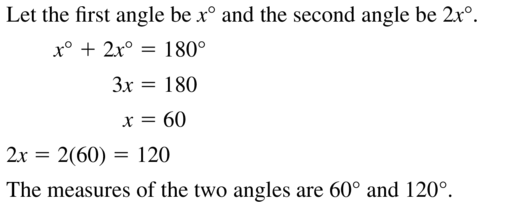
Question 20.
Two angles form a linear pair. The measure of one angle is \(\frac{1}{3}\) the measure of the other angle.
Answer:
The measure of one angle is 135° and the measure of the other angle is 270°,
Explanation:
We know that a linear pair of angles are formed when two lines intersect. Two angles are said to be linear if they are adjacent angles formed by two intersecting lines, So the given angles are the supplementary angles.It is given that the measure of one angle is \(\frac{1}{3}\) times the measure of the other angle. Let the angle be x°,
So x + \(\frac{1}{3}\)x = 180°,
\(\frac{4}{3}\)x = 180°,
4x = 180° (3),
4x = 540°,
x = \(\frac{540}{4}\),
x = 135°, Hence from the above we can conclude that the measure of one angle is 135° and the measure of the other angle is 270°.
Question 21.
The measure of an angle is nine times the measure of its complement.
Answer:
The measure of two angles are 81° and 9°,
Explanation:
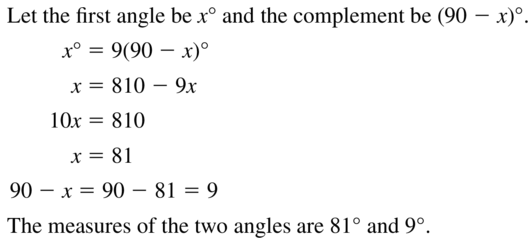
Question 22.
The measure of an angle is \(\frac{1}{4}\) the measure of its complement.
Answer:
The measure of one angle is 72° and the measure of the other angle is 144°,
Explanation:
We know that a linear pair of angles are formed when two lines intersect. Two angles are said to be linear if they are adjacent angles formed by two intersecting lines. So the given angles are the complementary angles. It is given that the measure of one angle is \(\frac{1}{4}\) times the measure of the other angle, Let the angle be x°,
So x + \(\frac{1}{4}\)x = 90°,
\(\frac{5}{4}\)x = 90°,
5x = 90° (4),
5x = 360°,
x = \(\frac{360}{5}\),
x = 72°, Hence from the above we can conclude that the measure of one angle is 72° and the measure of the other angle is 144°.
ERROR ANALYSIS
In Exercises 23 and 24, describe and correct the error in identifying pairs of angles in the figure.

Question 23.

Answer:
∠1 and ∠2 are adjacent angles,
Explanation:

Question 24.

Answer:
∠1 and ∠3 do not form a linear pair,
Explanation:
We know that a linear pair of angles are formed when two lines intersect. Two angles are said to be linear if they are adjacent angles formed by two intersecting lines, Hence from the figure we can conclude that ∠1 and ∠3 do not form a linear pair.
In Exercises 25 and 26. the picture shows the Alamillo Bridge in Seville, Spain. In the picture, m∠1 = 58° and m∠2 = 24°.

Question 25.
Find the measure of the supplement of ∠1
Answer:
∠1 =122°,
Explanation:
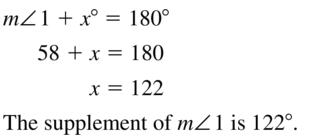
Question 26.
Find the measure of the supplement of ∠2.
Answer:
∠2 = 156°,
Explanation:
Let the other angle with ∠2 be x°, We know that the sum of the angle measures of supplementary angles is 180°, So ∠2 + x° = 180°,
Fro the above it is given that ∠2 = 24°,
So 24° + x° = 180°,
x° = 180° – 24°,
x° = 156°, Hence from the above we can conclude that the supplement of ∠2 is 156°.
Question 27.
PROBLEM-SOLVING
The arm of a crossing gate moves 42° from a vertical position. How many more degrees does the arm have to move so that it is horizontal?
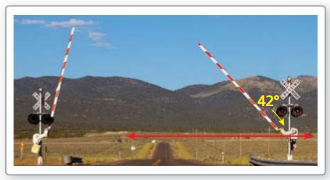
A. 42°
B. 138°
C. 48°
D. 90°
Answer:
C. 48°,
Explanation:

Question 28.
REASONING
The foul lines of a baseball field intersect at home plate to form a right angle. A batter hits a fair ball such that the path of the baseball forms an angle of 27° with the third base foul line. What is the measure of the angle betwe en the first base foul line and the path of the baseball?
Answer:
The angle between the first base foul line and the path of the baseball is 63°,
Explanation:
It is given that the foul lines of a baseball field intersect at home plate to form a right angle. A batter hits a fair ball such that the path of the baseball forms an angle of 27° with the third base foul line. So we can say that the angle between the path of the baseball and the third base foul line is complementary i.e., 90° with the angle between the path of the baseball and the base of the first foul line. So the angle between the first base foul line and the path of the baseball = 90° – (The angle between the path of the baseball and the third base foul line)
= 90° – 27° = 63°, Hence from the above we can conclude that the angle between the first base foul line and the path of the baseball is 63°.
Question 29.
CONSTRUCTION
Construct a linear pair where one angle measure is 115°.
Answer:
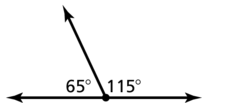
Question 30.
CONSTRUCTION
Construct a pair of adjacent angles that have angle measures of 45° and 97°.
Answer:
The representation of the pair of adjacent angles that has the angle measures of 45° and 97° is
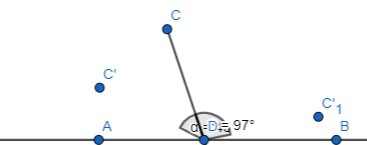
Explanation:
The two angles are said to be adjacent angles when they share the common vertex and side. The endpoint of the rays, forming the sides of an angle, is called the vertex of an angle. Adjacent angles can be a complementary angle or supplementary angle when they share the common vertex and side.
Constructed a pair of adjacent angles that have angle measures of 45° and 97° above.
Question 31.
PROBLEM-SOLVING
m∠U = 2x°, and m∠V = 4m∠U. Which value of x makes ∠U and ∠V complements of each other?
A. 25
B. 9
C. 36
D. 18
Answer:
B. 9,
Explanation:

MATHEMATICAL CONNECTIONS
In Exercises 32 – 35, write and solve an algebraic equation to find the measure of each angle based on the given description.
Question 32.
The measure of an angle is 6° less than the measure of its complement.
Answer:
The measures of the angles are 48°, 42°,
Explanation:
It is given that the measure of an angle is 6° less than the measure of its complement,
Let the angle be x°, So the complement of the angle is: (90 – x)°,
So (90 – x)° = x – 6°,
90 + 6 = x + x,
2x = 96°,
x = \(\frac{96}{2}\),
x = 48°,
So the measures of the two angles are: 48°, 90° – 48° = 42°, Hence from the above we can conclude that the measures of the angles are 48°, 42°.
Question 33.
The measure of an angle is 12° more than twice the measure of its complement.
Answer:
The measures of the two angles are 64°, 26°,
Explanation:

Question 34.
The measure of one angle is 3° more than \(\frac{2}{3}\) the measure of its supplement.
Answer:
The measures of the angles are 73.4° and 106.6°,
Explanation:
It is given that the measure of an angle is 3° more than \(\frac{2}{3}\) the measure of its supplement, Now let the measure of an angle be x°,
So the measure of the other angle is (180 – x)°,
So x° = 3° + \(\frac{2}{3}\) (180 – x)°,
3x° = 9° + 360° – 2x°,
5x° = 369°,
x = \(\frac{369}{5}\),
x° = 73.4°,
So the measures of the angles are: 73.4° and 180° – 73.4° = 106.6°,
Hence from the above we can conclude that the measures of the angles are: 73.4° and 106.6°.
Question 35.
Two angles form a linear pair. The measure of one angle is 15° less than \(\frac{2}{3}\) the measure of the other angle.
Answer:
The measures of the two angles are: 117° and 63°,
Explanation:
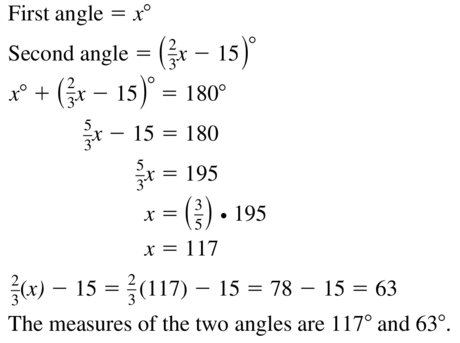
CRITICAL THINKING
In Exercises 36 – 41. tell whether the statement is always, sometimes, or never true. Explain your reasoning.
Question 36.
Complementary angles are adjacent.
Answer:
Yes,
Explanation:
The given statement is “Complementary angles are adjacent”, We know that the complementary angles sometimes will be vertical angles or sometimes adjacent angles or sometimes non-adjacent angles. Hence from the above we can conclude that the given statement is sometimes true.
Question 37.
Angles in a linear pair are supplements of each other.
Answer:
Yes always,
Explanation:

Question 38.
Vertical angles are adjacent.
Answer:
Vertical angles are never adjacent,
Explanation:
The given statement is “Vertical angles are adjacent”, We know that the vertical angles are the angles formed by the intersection of two lines whereas adjacent angles share a common side and a common vertex. Hence from the above we can conclude that vertical angles are never adjacent.
Question 39.
Vertical angles are supplements of each other.
Answer:
Sometimes,
Explanation:

Question 40.
If an angle is acute. then its complement is greater than its supplement.
Answer:
If an angle is acute, then its complement will never be greater than its supplement,
Explanation:
The given statement is “If an angle is acute, then its complement is greater than its supplement”, we know that the sum of complementary angles is 90° i.e., the measures of the angles are always acute, the sum of the supplementary angles is 180° i.e., the measure of 1 angle is acute and the measure of the other angle is obtuse,
Hence from the above we can conclude that if an angle is acute then its complement will never be greater than its supplement.
Question 41.
If two complementary angles are congruent, then the measure of each angle is 45°,
Answer:
Yes always,
Explanation:

Question 42.
WRITING
Explain why the supplement of an acute angle must be obtuse.
Answer:
The supplement of an acute angle must be obtuse,
Explanation:
We know that the sum of the measures of the supplementary angles is 180°,
So if one angle is acute i.e., the angle less than 90°, then the other angle must be obtuse to make the sum 180°, Hence the supplement of an acute angle must be obtuse.
Question 43.
WRITING
Explain why an obtuse angle does not have a complement.
Answer:
Angles that are already more than 90 degrees do not have complements,
it is already more than 90 degrees just by itself,
Explanation:

Angles that are already more than 90 degrees do not have complements,
it is already more than 90 degrees just by itself, So obtuse angle does not have a complement.
Question 44.
THOUGHT-PROVOKING
Sketch an intersection of roads. Identify any supplementary, complementary, or vertical angles.
Answer:
The representation of the intersection of roads is:

The supplementary angles are 1 and ∠2; ∠2 and ∠3; ∠3 and ∠4; ∠4 and ∠1,
There are no complementary angles, The vertical angles are ∠1 and ∠3; ∠2 and ∠4,
Explanation:
We know that the angles that have the sum of the angle measures 90° are “Complementary angles”, the angles that have the sum of the angle measures 180° are “Supplementary angles”, the angles that form with the intersection of 2 lines are “Vertical angles”,
So, From the figure the supplementary angles are ∠1 and ∠2; ∠2 and ∠3; ∠3 and ∠4; ∠4 and ∠1,There are no complementary angles, The vertical angles are ∠1 and ∠3; ∠2 and ∠4.
Question 45.
ATTENDING TO PRECISION
Use the figure.
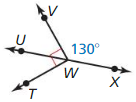
a. Find m∠UWV, m∠TWU, and m∠TWX.
b. YOU write the measures of ∠TWU, ∠TWX, ∠UWV and ∠VWX on separate pieces of paper and place the pieces of paper in a box. Then you pick two pieces of paper out of the box at random. What is the probability that the angle measures you choose are supplementary? Explain your reasoning.
Answer:
a. m∠UWV = 50° , m∠TWU = 40° , and m∠TWX =140° ,
b. The probability that the angle measures I choose are supplementary 1/3,
Explanation:
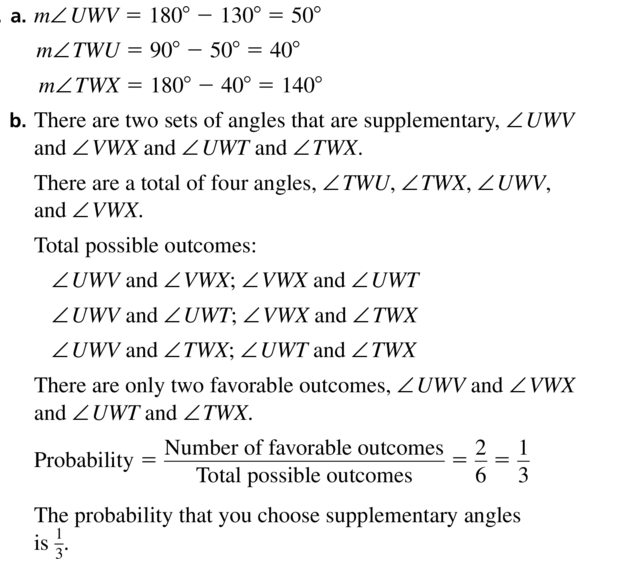
Question 46.
HOW DO YOU SEE IT?
Tell whether you can conclude that each statement is true based on the figure. Explain your reasoning.
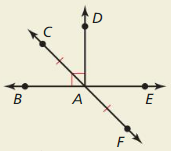
a. \(\overline{C A}\) ≅ \(\overline{A F}\)
Answer:
Yes, \(\overline{C A}\) ≅ \(\overline{A F}\),
Explanation:
From the given figure we can observe that \(\overline{C A}\) has the same length as \(\overline{A F}\), Hence from the above we can conclude that \(\overline{C A}\) ≅ \(\overline{A F}\).
b. Points C, A, and F are collinear
Answer:
C, A, and F are collinear points,
Explanation:
We know that the points that are present on the same line are called “Collinear points”,
From the figure we can observe that C, A, and F lie on the same line. Hence from the above
we can conclude that C, A, and F are collinear points.
c. ∠CAD ≅ ∠EAF.
Answer:
Yes, ∠CAD ≅ ∠EAF,
Explanation:
From the figure, we can observe that point A is the angle bisector of C and D,
Hence from the above we can conclude that ∠CAD ≅ ∠EAF.
d. \(\overline{B A}\) ≅ \(\overline{A E}\)
Answer:
Yes, \(\overline{B A}\) ≅ \(\overline{A E}\),
Explanation:
We know that C is the Bisector”, A “Bisector” divides anything into 2 congruent parts
Hence from the above we can conclude that \(\overline{B A}\) ≅ \(\overline{A E}\).
e. 
Answer:
Yes, \(\overline{C F}\), \(\overline{B E}\) and \(\overline{A D}\) intersect at point A,
Explanation:
From the figure we can observe that there are 3 lines intersect at point A, Hence from the above we can conclude that \(\overline{C F}\), \(\overline{B E}\) and \(\overline{A D}\) intersect at point A.
f. ∠BAC and ∠CAD are complementary angles.
Answer:
Yes, ∠BAC and ∠CAD are complementary angles,
Explanation:
From the figure we can observe that ∠A has a complementary angle,
Hence from the above we can conclude that ∠BAC and ∠CAD are complementary angles.
g. ∠DAE is a right angle.
Answer:
Yes, ∠DAE is a right angle,
Explanation:
From the figure we can observe that D is perpendicular to E and A has a complementary angle. Hence, from the above we can conclude that ∠DAE is a right angle.
Question 47.
REASONING
∠KJL and ∠LJM arc complements, and ∠MJN and ∠LJM are complements. Can you show that ∠KJL ≅ ∠MJN? Explain your reasoning.
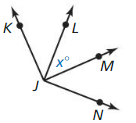
Answer:
Yes, ∠KJL ≅ ∠MJN,
Explanation:

Question 48.
MAKING AN ARGUMENT
Light from a flashlight strikes a mirror and is reflected so that the angle of reflection is congruent to the angle of incidence. Your classmate claims that ∠QPR is congruent to ∠TPU regardless of the measure of ∠RPS. Is your classmate correct? Explain your reasoning.
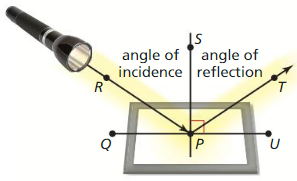
Answer:
Yes, my classmate is correct,
Explanation:
It is given that the light from a flashlight strikes a mirror and is reflected so that the angle of reflection is congruent to the angle of incidence. Your classmate claims that ∠QPR is congruent to ∠TPU regardless of the measure of ∠RPS.
We know that the vertical angle is the intersection of two lines and \(\overline{S P}\) is the angle bisector, So ∠QPR is congruent to ∠TPU regardless of the measure of ∠RPS.
Hence from the above we can conclude that the claim of my friend is correct.
Question 49.
DRAWING CONCLUSIONS
Use the figure.

a. Write expressions for the measures of ∠BAE, ∠DAE, and ∠CAB.
b. What do you notice about the measures of vertical angles? Explain your reasoning.
Answer:
a. m∠BAE= y°, m∠DAE = (180 -y)°, and m∠CAB = (180 – y)°,
b. Equal angle measures,
Explanation:
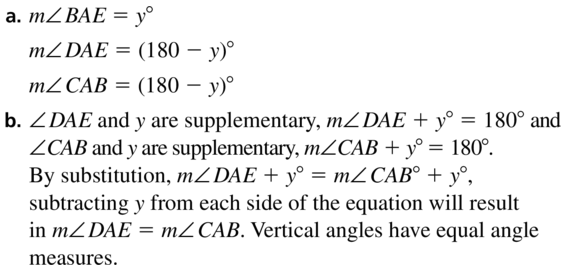
Question 50.
MATHEMATICAL CONNECTIONS
Let m∠1 = x°, m∠2 = y1°, and m∠3 = y2° ∠2 is the complement of ∠1, and ∠3 is the supplement of ∠1.
a. Write equations for y1 as a function of x and for y2 as a function of x. What is the domain of each function? Explain.
Answer:
The domain of y1 can be given as 0° ≤ x ≤ 90°,
The domain of y2 can be given as 0° ≤ x ≤ 180°,
Explanation:
It is given that m∠1 = x°, m∠2 = y1°, and m∠3 = y2°,
∠2 is the complement of ∠1, and ∠3 is the supplement of ∠1,
So ∠1 + ∠2 = 90° and ∠3 + ∠1 = 180°,
x° + y1° = 90° and y2° + x° = 180°,
So y1° = 90° – x° and y2° = 180° – x°,
Hence from the above the domain of y1 can be given as 0° ≤ x ≤ 90°,
the domain of y2 can be given as 0° ≤ x ≤ 180°,
b. Graph each function and describe its range.
Answer:
The representations of the 2 functions in the coordinate plane are:

From the above graph the range of y1 is 90 ≤ y ≤ 200, the range of y2 is 0 ≤ y ≤ 200,
Explanation:
From part (a), The 2 functions are y1° = 90° – x° and y2° = 180° – x°
Hence graphed each function above and the range of y1 is 90 ≤ y ≤ 200, the range of y2 is 0 ≤ y ≤ 200.
Question 51.
MATHEMATICAL CONNECTIONS
The sum of the measures of two complementary angles is 74° greater than the difference of their measures. Find the measure of each angle. Explain how you found the angle measures.
Answer:
53°, 37°,
Exlanation:
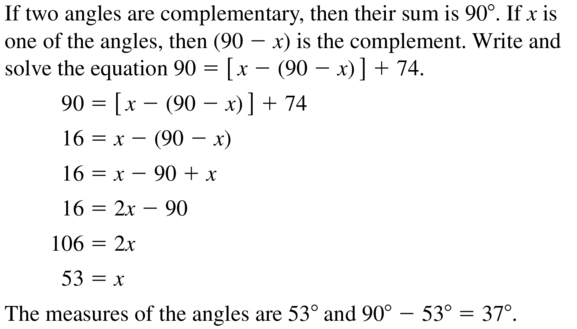
Maintaining MathematicaI Proficiency
Determine whether the statement is always, sometimes, or never true. Explain your reasoning.
Question 52.
An integer is a whole number.
Answer:
An integer is sometimes a whole number,
Explanation:
The given statement is “An integer is a whole number”, We know that all whole numbers must be integers but all integers are not whole numbers,
Example: -6 is an integer but not a whole number,
3 is a whole number and also an integer, Hence from the above we can conclude that an integer is sometimes a whole number.
Question 53.
An integer is an irrational number.
Answer:
Never,

Question 54.
An irrational number is a real number.
Answer:
An irrational number is never a real number,
Explanation:
The given statement is “An irrational number is a real number”,
We know that “Real numbers” are the numbers that can be written in the form of \(\frac{p}{q}\) whereas “Irrational numbers” can’t be written in the form of \(\frac{p}{q}\), Hence from the above ee can conclude that an irrational number is never a real number.
Question 55.
A whole number is negative.
Answer:
Never,
Explanation:

Question 56.
A rational number is an integer.
Answer:
A rational number is sometimes an integer,
Explanation:
The given statement is “A rational number is an integer”, We know that rational numbers are the numbers that can be written in the form of \(\frac{p}{q}\), Hence from the above we can conclude that a rational number is sometimes an integer.
Question 57.
A natural number is an integer.
Answer:
Always,
Explanation:

Question 58.
A whole number is a rational number.
Answer:
A whole number is always a rational number,
Explanation:
The given statement is “A whole number is a rational number”, We know that a whole number can be written in the form of \(\frac{p}{q}\), Hence from the above we can conclude that a whole number is always a rational number.
Question 59.
An irrational number is negative.
Answer:
Sometimes,
Explanation:

1.4 – 1.6 Performance Task: Comfortable Horse Stalls
Mathematical Practices
Question 1.
How could you explain your answers to Exercise 33 on page 36 to a friend who is unable to hear’?
Answer:
Comparing the given vertices with the standard linear equation and find the slopes and x and y-intercepts for the coordinates of the vertices of the triangle,
Explanation:
In Exercise 33 on page 36, The given vertices of the triangle are in the form of the standard linear equation, So comparing the given vertices with the standard linear equation and find the slopes and x and y-intercepts for the coordinates of the vertices of the triangle.
Question 2.
What tool(s) could you use to verify your answers to Exercises 25 – 30 on page 44?
Answer:
“Angle Addition Postulate”,
Explanation:
To verify the answers to Exercise 25 – 30 on page 44, We can use “Angle Addition Postulate”.
Question 3.
Your friend says that the angles in Exercise 28 on page 53 are supplementary angles. Explain why you agree or disagree.
Answer:
Disagree,
Explanation:
In Exercise 28 on page 53, It is given that a right-angled triangle is formed, We know that,
The sum of the complementary angles is 90°, Hence from the above we can conclude that I disagree with my friend about supplementary angle.
Basics of Geometry Chapter Review
1.1 Points, Lines, and Planes
Use the diagram.

Question 1.
Give another name for plane M.
Answer:
Plane XNZ or Plane g,
Explanation:
From the given figure we can conclude that another name for plane M is Plane XNZ or Plane g.
Question 2.
Name a line in the plane.
Answer:
Line PY or Line XZ,
Explanation:
From the given figure we can conclude that the names of lines in the pane are Line PY or Line XZ.
Question 3.
Name a line intersecting the plane.
Answer:
Line PY,
Explanation:
From the above figure we can conclude that the line intersecting the plane is Line PY.
Question 4.
Name two rays.
Answer:
Ray g and Ray h,
Explanation:
From the above figure we can conclude that the two rays are Ray g and Ray h.
Question 5.
Name a pair of opposite rays.
Answer:
Rays g and h,
Explanation:
From the above figure we can conclude that the opposite rays are Rays g and h.
Question 6.
Name a point, not in plane M.
Answer:
Point p,
Explanation:
From the above figure we can conclude that the point that is not in plane M is point p.
1.2 Measuring and Constructing Segments
Find XZ.
Question 7.

Answer:
XZ = 41,
Explanation:
From the given figure by using the Segment Addition Postulate
XZ = XY + YZ,
XZ = 17 + 24,
XZ = 41, Hence from the above we can conclude that the value of XZ is 41.
Question 8.

Answer:
XZ = 11,
Explanation:
From the given figure by using the Segment Addition Postulate,
AZ = AX + XZ,
38 = 27 + XZ,
XZ = 38 – 27,
XZ = 11, Hence from the above we can conclude that the value of XZ is 11.
Question 9.
Plot A(8, – 4), B(3, – 4), C(7, 1), and D(7, – 3) in a coordinate plane.
Then determine whether \(\overline{A B}\) and \(\overline{C D}\) are congruent.
Answer:

\(\overline{A B}\) is not congruent to \(\overline{C D}\),
Explanation:
The given points are A (8, -4), B (3, -4), C (7, 1), and D (7, -3),
Comparing the given points with A (x1, y1), B (x2, y2), C (x3, y3), and D (x4, y4)
Now \(\overline{A B}\) = \(\sqrt{(x2 – x1)² + (y2 – y1)²}\),
= \(\sqrt{(8 – 3)² + (4 – 4)²}\),
= 5,
\(\overline{C D}\) = \(\sqrt{(x2 – x1)² + (y2 – y1)²}\)
= \(\sqrt{(7 – 7)² + (1 + 3)²}\)
= 4,
Represented the given points in the coordinate plane above and
\(\overline{A B}\) is not congruent to \(\overline{C D}\).
1.3 Using Midpoint and Distance Formulas
Find the coordinates of the midpoint M. Then find the distance between points S and T.
Question 10.
S(- 2, 4) and T(3, 9)
Answer:
Midpoint : (\(\frac{1}{2}\), \(\frac{13}{2}\)),
Explanation:
The given points are S (-2, 4) and T (3, 9),
We know that the coordinates of the Midpoint = (\(\frac{x1 + x2}{2}\), \(\frac{y1 + y2}{2}\)), So
The coordinates of the Midpoint = (\(\frac{3 – 2}{2}\), \(\frac{9 + 4}{2}\)),
The coordinates of the Midpoint = (\(\frac{1}{2}\), \(\frac{13}{2}\)).
Question 11.
S(6, – 3) and T(7, – 2)
Answer:
Midpoint : (\(\frac{13}{2}\), \(\frac{-5}{2}\)),
Explanation:
The given points are S (6, -3) and T (7, -2),
We know that the coordinates of the Midpoint = (\(\frac{x1 + x2}{2}\), \(\frac{y1 + y2}{2}\)), So
The coordinates of the Midpoint = (\(\frac{7 + 6}{2}\), \(\frac{-2 – 3}{2}\)),
The coordinates of the Midpoint = (\(\frac{13}{2}\), \(\frac{-5}{2}\)).
Question 12.
The midpoint of \(\overline{J K}\) is M(6, 3). One endpoint is J(14, 9). Find the coordinates of endpoint K.
Answer:
H : (-2, -3),
Explanation:
The given points of \(\overline{J K}\) are M (6, 3) and J (14, 9)
Let H be (x. y), We know that the coordinates of the Midpoint = (\(\frac{x1 + x2}{2}\), \(\frac{y1 + y2}{2}\)), So
(6, 3) = (\(\frac{x + 14}{2}\), \(\frac{y + 9}{2}\))
\(\frac{x + 14}{2}\) = 6 \(\frac{y + 9}{2}\) = 3
x + 14 = 6 (2) y + 9 = 3 (2)
x = 12 – 14 y = 6 – 9
x = -2 y = -3
Hence from the above we can conclude that the coordinates of H are (-2, -3).
Question 13.
Point M is the midpoint of \(\overline{A B}\) here AM = 3x + 8 and MB = 6x – 4. Find AB.
Answer:
AB = 9x -4,
Explanation:
It is given that Point M is the midpoint of \(\overline{A B}\) here AM = 3x + 8 and MB = 6x – 4. Now by using the Segment Addition Postulate,
AB = AM + MB,
AB = (3x + 8) + (6x – 4),
AB = 9x – 4.
1.4 Perimeter and Area in the Coordinate Plane
Find the perimeter and area of the polygon with the given vertices.
Question 14.
W(5, – 1), X(5, 6), Y(2, 1) Z(2, 6)
Answer:
The perimeter of the given polygon is 25.4,
The area of the given polygon is 5.4,
Explanation:
The given points are W (5, -1), X (5, 6), Y (2, 1), Z (2, 6)
Now, \(\overline{W X}\) = \(\sqrt{(x2 – x1)² + (y2 – y1)²}\),
= \(\sqrt{(5 – 5)² + (1 + 6)²}\) = 7,
\(\overline{X Y}\) = \(\sqrt{(x2 – x1)² + (y2 – y1)²}\),
= \(\sqrt{(5 – 2)² + (6 – 1)²}\) = 5.8,
\(\overline{Y Z}\) = \(\sqrt{(x2 – x1)² + (y2 – y1)²}\),
= \(\sqrt{(2 – 2)² + (6 – 1)²}\) = 5,
\(\overline{Z W}\) = \(\sqrt{(x2 – x1)² + (y2 – y1)²}\),
= \(\sqrt{(5 – 2)² + (6 + 1)²}\) = 7.6,
\(\overline{W Y}\) = \(\sqrt{(x2 – x1)² + (y2 – y1)²}\),
= \(\sqrt{(5 – 2)² + (1 + 1)²}\) = 3.6,
\(\overline{X Z}\) = \(\sqrt{(x2 – x1)² + (y2 – y1)²}\),
= \(\sqrt{(5 – 2)² + (6 – 6)²}\) = 3,
Hence the perimeter of the given polygon = WX + XY + YZ + ZW,
= 7 + 5.8 + 5 + 7.6 = 25.4,
Since all the lengths of the sides are different the area of the given polygon = \(\frac{1}{2}\) (d1) (d2) where d1 and d2 are the diagonals, So the area of the polygon = \(\frac{1}{2}\) (WY) (XZ) = \(\frac{1}{2}\) (3) (3.6) = 5.4,
Hence from the above we can conclude that the perimeter of the given polygon is 25.4,
The area of the given polygon is 5.4.
Question 15.
E(6, – 2) , F(6, 5), G(- 1, 5)
Answer:
The perimeter of the given polygon is 23.8,
The area of the given polygon is 24.5,
Explanation:
The given points are E (6, -2), F (6, 5), G (-1, 5),
Now \(\overline{E F}\) = \(\sqrt{(x2 – x1)² + (y2 – y1)²}\),
= \(\sqrt{(6 – 6)² + (2 + 5)²}\) = 7,
\(\overline{F G}\) = \(\sqrt{(x2 – x1)² + (y2 – y1)²}\),
= \(\sqrt{(6 + 1)² + (5 – 5)²}\) = 7,
\(\overline{G E}\) = \(\sqrt{(x2 – x1)² + (y2 – y1)²}\),
= \(\sqrt{(6 + 1)² + (5 + 2)²}\) = 9.8,
Hence the perimeter of the given polygon = EF + FG + GE = 7 + 7 + 9.8 = 23.8,
Now the area of the given polygon = \(\frac{1}{2}\) (Base) (Height), So
the area of the polygon = \(\frac{1}{2}\) (EF) (FG) = \(\frac{1}{2}\) (7) (7)
= 24.5. Hence from the above we can conclude that the perimeter of the given polygon is 23.8 and the area of the given polygon is 24.5.
1.5 Measuring and Constructing Angles
Find m∠ABD and m∠CBD.
Question 16.
m∠ABC = 77°
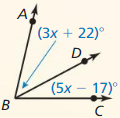
Answer:
m∠ABD = 49° and m∠CBD = 28°,
Explanation:
From the above figure by using the Angle Addition Postulate,
∠ABC = ∠ABD + ∠DBC,
It is given that ∠ABC = 77°,
So 77° = (3x + 22)° + (5x – 17)°,
8x + 5 = 77°,
8x = 77° – 5°,
8x = 72°,
x = \(\frac{72}{8}\),
x = 9°,
So ∠ABD = (3x + 22)°,
= 3 (9) + 22,
= 27 + 22,
= 49°,
∠CBD = (5x – 17)°,
= 5 (9) – 17,
= 45 – 17,
= 28°,
Hence from the above we can conclude that ∠ABD = 49° and ∠CBD = 28°.
Question 17.
m∠ABC = 111°
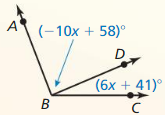
Answer:
∠ABD = 88° and ∠CBD = 23°,
Explanation:
From the above figure by using the Angle Addition Postulate,
∠ABC = ∠ABD + ∠DBC It is given that ∠ABC = 111°,
So 111° = (-10x + 58)° + (6x + 41)°,
-4x + 99 = 111°,
-4x = 111° – 99°,
-4x = 12°,
x = \(\frac{-12}{4}\),
x = -3°,
So ∠ABD = (-10x + 58)°,
= -10 (-3) + 58,
= 30 + 58,
= 88°,
∠CBD = (6x + 41)°,
= 6 (-3) + 41,
= 41 – 18,
= 23°, Hence from the above we can conclude that ∠ABD = 88° and ∠CBD = 23°.
Question 18.
Find the measure of the angle using a protractor.

Answer:
The angle is 127.3°,
Explanation:
The measure of the angle of the given figure using a protractor is
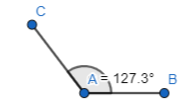
Hence from the above we can conclude that the angle is 127.3°.
1.6 Describing Pairs of Angles
∠1 and ∠2 are complementary angles. Given m∠1, find m∠2.
Question 19.
m∠1 = 12°
Answer:
m∠2 = 78°,
Explanation:
It is given that ∠1 and ∠2 are the complementary angles ∠1 = 12°
So ∠1 + ∠2 = 90°, So ∠2 = 90° – 12°
∠2 = 78°, Hence from the above we can conclude that m∠2 = 78°.
Question 20.
m∠1 = 83°
Answer:
m∠2 = 7°,
Explanation:
It is given that ∠1 and ∠2 are the complementary angles ∠1 = 83°
So ∠1 + ∠2 = 90°, So ∠2 = 90° – 83°,
∠2 = 7°, Hence from the above we can conclude that m∠2 = 7°.
∠3 and ∠4 are supplementary angles. Given m∠3, find m∠4.
Question 21.
m∠3 = 116°
Answer:
m∠4 = 64°,
Explanation:
It is given that ∠3 and ∠4 are the supplementary angles, ∠3 = 116°,
So ∠3 + ∠4 = 180°, So ∠4 = 180° – 116°, ∠4 = 64°,
Hence from the above we can conclude that m∠4 = 64°.
Question 22.
m∠3 = 56°
Answer:
m∠4 = 124°,
Explanation:
It is given that ∠3 and ∠4 are the supplementary angles, ∠3 = 56°,
So ∠3 + ∠4 = 180°, So ∠4 = 180° – 56°, ∠4 = 124°,
Hence from the above we can conclude that ∠4 = 124°.
Basics of Geometry Chapter Test
Find the length of \(\overline{Q S}\). Explain how you found your answer.
Question 1.

Answer:
The length of \(\overline{Q S}\) is 31,
Explanation:
From the given figure by using the Segment Addition Postulate
\(\overline{Q S}\) = \(\overline{Q R}\) + \(\overline{R S}\)
= 12 + 19 = 31, Hence from the above we can conclude that the length of \(\overline{Q S}\) is 31.
Question 2.

Answer:
The length of \(\overline{Q S}\) is 12,
Explanation:
From the given figure by using the Segment Addition Postulate,
\(\overline{Q R}\) = \(\overline{Q S}\) + \(\overline{S R}\)
59 = \(\overline{Q S}\) + 47,
\(\overline{Q S}\) = 59 – 47,
\(\overline{Q S}\) = 12, Hence from the above we can conclude that the length of \(\overline{Q S}\) is 12.
Find the coordinates of tile midpoint M. Then find the distance between the two points.
Question 3.
A(- 4, – 8) and B(- 1, 4)
Answer:
The midpoint are (\(\frac{-5}{2}\), -2),
Explanation:
The given points are A (-4, -8), and B (-1, 4),
We know that the coordinates of the midpoint = (\(\frac{x1 + x2}{2}\), \(\frac{y1 + y2}{2}\)), So the coordinates of the midpoint = (\(\frac{-1 – 4}{2}\), \(\frac{-8 + 4}{2}\)),
The coordinates of the midpoint = (\(\frac{-5}{2}\), \(\frac{-4}{2}\)),
The coordinates of the midpoint = (\(\frac{-5}{2}\), \(\frac{-2}\)),
Hence from the above we can conclude that the coordinates of the midpoint are: (\(\frac{-5}{2}\), -2).
Question 4.
C(- 1, 7) and D(- 8, – 3)
Answer:
The midpoint are (\(\frac{-9}{2}\), 2),
Explanation:
The given points are C (-1, 7), and D (-8, -3),
We know that the coordinates of the midpoint = (\(\frac{x1 + x2}{2}\), \(\frac{y1 + y2}{2}\)), So the coordinates of the midpoint = (\(\frac{-1 – 8}{2}\), \(\frac{-3 + 7}{2}\)),
The coordinates of the midpoint = (\(\frac{-9}{2}\), \(\frac{4}{2}\)),
The coordinates of the midpoint = (\(\frac{-9}{2}\), 2),
Hence from the above we can conclude that the coordinates of the midpoint are: (\(\frac{-9}{2}\), 2).
Question 5.
The midpoint of \(\overline{E F}\) is M(1, – 1). One endpoint is E(- 3, 2). Find the coordinates of endpoint F.
Answer:
(5, -4),
Explanation:
The given points of \(\overline{E F}\) are M (1, -1), and E (-3, 2),
Let the other endpoint be F (x, y), We know that the coordinates of the midpoint = (\(\frac{x1 + x2}{2}\), \(\frac{y1 + y2}{2}\)), So
(1, -1) = (\(\frac{x – 3}{2}\), \(\frac{y + 2}{2}\))
\(\frac{x – 3}{2}\) = 1 \(\frac{y + 2}{2}\) = -1
x – 3 = 2 y + 2 = -2
x = 5 y = -4
Hence from the above we can conclude that the coordinates of the other endpoint are (5, -4).
Use the diagram to decide whether the statement is true or false.
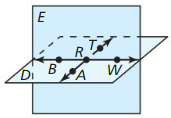
Question 6.
Points A, R, and B are collinear.
Answer:
A, R, and B are not collinear,
Explanation:
We know that the points that lie in the same line are called “Collinear points”,
From the figure we can observe that A, R, and B are in the same plane but not in the same line, Hence from the above we can conclude that A, R, and B are not collinear.
Question 7.

Answer:
Yes,
Explanation:
From the given figure we can observe there are two lines in the plane,
Hence from the above we can conclude that BW and AT are lines.
Question 8.

Answer:
Yes,
Explanation:
From the given figure we can observe that BR and RT are perpendicular lines,
So we can conclude that BR and RT are opposite rays.
Question 9.
Plane D could also be named plane ART.
Answer:
Yes,
Explanation:
We know that the points that are coplanar in the given plane can also be named for the name of the plane, Hence from the above we can conclude that plane D can also be named plane ART.
Find the perimeter and area of the polygon with the given vertices. Explain how you found your answer.
Question 10.
P(- 3, 4), Q(1, 4), R(- 3, – 2), S(3, – 2)
Answer:
The perimeter of the given polygon is 24.4, The area of the given polygon is 36,
Explanation:
The given points are: P(- 3, 4), Q(1, 4), R(- 3, – 2), S(3, – 2),
Now \(\overline{P Q}\) = \(\sqrt{(x2 – x1)² + (y2 – y1)²}\),
= \(\sqrt{(1 + 3)² + (4 – 4)²}\),
= 4,
\(\overline{Q R}\) = \(\sqrt{(x2 – x1)² + (y2 – y1)²}\),
= \(\sqrt{(1 + 3)² + (4 + 2)²}\),
= 7.2,
\(\overline{R S}\) = \(\sqrt{(x2 – x1)² + (y2 – y1)²}\),
= \(\sqrt{(2 – 2)² + (3 + 3)²}\),
= 6,
\(\overline{S P}\) = \(\sqrt{(x2 – x1)² + (y2 – y1)²}\),
= \(\sqrt{(3 + 3)² + (4 + 2)²}\),
= 7.2,
Hence, The perimeter of the given polygon = PQ + QR + RS + SP = 4 + 6 + 7.2 + 7.2 = 24.4,
The area of the given polygon = \(\frac{1}{2}\) (a + b) (h) Where a and b are the sides that are not equal. So the area of the polygon = \(\frac{1}{2}\) (4 + 6) (7.2),
= \(\frac{1}{2}\) (10) (7.2) = 36,
Hence from the above we can conclude that the perimeter of the given polygon is 24.4,
The area of the given polygon is 36.
Question 11.
J(- 1, 3), K(5, 3), L(2, – 2)
Answer:
The perimeter of the given polygon is 17.8, The area of the given polygon is 17.4,
Explanation:
The given points are: J(- 1, 3), K(5, 3), L(2, – 2),
Now \(\overline{J K}\) = \(\sqrt{(x2 – x1)² + (y2 – y1)²}\),
= \(\sqrt{(3 – 3)² + (1 + 5)²}\),
= 6,
\(\overline{K L}\) = \(\sqrt{(x2 – x1)² + (y2 – y1)²}\),
= \(\sqrt{(3 + 2)² + (5 – 2)²}\),
= 5.8,
\(\overline{L J}\) = \(\sqrt{(x2 – x1)² + (y2 – y1)²}\),
= \(\sqrt{(2 + 1)² + (3 + 2)²}\),
= 5.8, Hence the perimeter of the given polygon = JK + KL + LJ,
= 6 + 5.8 + 5.8,
= 17.8,
Now, The area of the given polygon = \(\frac{1}{2}\) (Base) (Height),
So, The area of the polygon = \(\frac{1}{2}\) (JK) (KL)
= \(\frac{1}{2}\) (6) (5.8),
= 17.4,
Hence from the above we can conclude that the perimeter of the given polygon is 17.8,
The area of the given polygon is 17.4.
Question 12.
In the diagram. ∠AFE is a straight angle and ∠CFE is a right angle. Identify all supplementary and complementary angles. Explain. Then find, m∠DFE, m∠BFC, and m∠BFE.

Answer:
Question 13.
Use the clock at the left.

a. What is the measure of the acute angle created when the clock is at 10:00?
Answer:
60°,
Explanation:
We know that 12 sectors = 360°,
From the above clock, We can observe that there are 2 sectors at 10:00,
So the angle created when the clock is at 10:00 = 2 (30) = 60°,
Hence from the above we can conclude that the measure of the acute angle created when the clock is at 10:00 is 60°.
b. What is the measure of the obtuse angle created when the clock is at 5:00?
Answer:
240°,
Explanation:
From the figure we can observe that there are 4 sectors between 12 and at 5:00,
So, The acute angle created when the clock is at 5:00 = 4 (30) = 120°,
So the obtuse angle created when the clock is at 5:00 = 360 – 120 = 240°,
Hence from the above we can conclude that the obtuse angle created when the clock is at 5:00 is 240°.
c. Find a time where the hour and minute hands create a straight angle.
Answer:
The hour and minute hands create a straight angle 6:00 and 2:45,
Explanation:
We know that a straight angle is an angle that is 180°,
Now from the figure we can observe that the hour and minute hands create a straight angle is: 6:00, 2:45. Hence from the above we can conclude that the time where the hour and minute hands create a straight angle is 6:00 and 2:45.
Question 14.
Sketch a figure that contains a plane and two lines that intersect the plane at one point.
Answer:

Explanation:
The representation of a plane and two planes intersection at a point is shown above.
Question 15.
Your parents decide they would like to install a rectangular swimming pool in the backyard. There is a 15-foot by the 20-foot rectangular area available. Your parents request a 3-foot edge around each side of the pool. Draw a diagram of this situation in a coordinate plane. What is the perimeter and area of the largest swimming pool that will fit?
Answer:
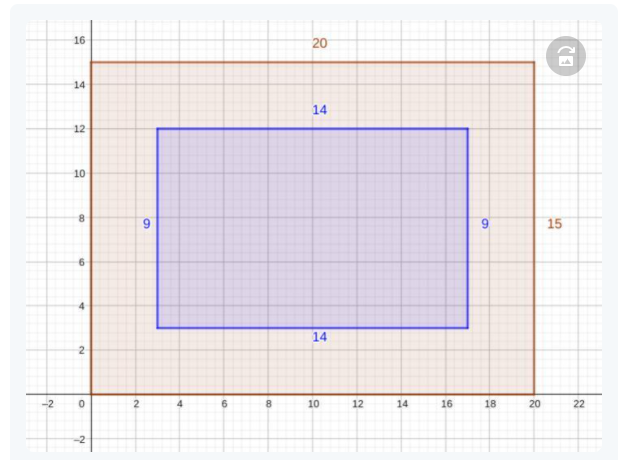
The perimeter of the pool is 46 ft, The area of the pool is 126 ft²,
Explanation:
It is given that my parents decide they would like to install a rectangular swimming pool in the backyard. There is a 15-foot by the 20-foot rectangular area available. My parents request a 3-foot edge around each side of the pool. Since the 3 ft edge is on both sides of the pool, each dimension of the pool is 6 ft shorter than the corresponding dimension of the space.
So,The pool will be 15 ft -6 ft = 9 ft in one direction and 20 ft -6 ft = 14 ft in the other direction. We know that The perimeter of the pool is the sum of its side lengths:
So P = 9 ft + 14 ft + 9 ft + 14 ft = 2(9 ft +14 ft) = 2(23 ft) = 46 ft,
Now, The area of the pool = 14 (9) = 126 ft²
Hence from the above we can conclude that the perimeter of the pool is 46 ft,
The area of the pool is 126 ft²,
The representation of the pool in the coordinate plane is shown above.
Question 16.
The picture shows the arrangement of balls in a game of boccie. The object of the game is to throw your ball closest to the small. while ball, which is called the Pallino. The green ball is the midpoint between the red ball and the Pallino. The distance between the green hail and the red ball is 10 inches. The distance between the yellow ball and the Pallino is 8 inches. Which bail is closer to the Pallino. the green ball or the yellow ball? Explain.
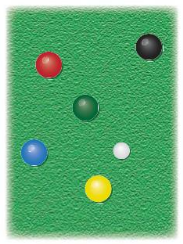
Answer:
Yellow ball is closer to the Pallino,
Explanation:
It is given that the picture shows the arrangement of balls in a game of boccie. The object of the game is to throw your ball closest to the small. while ball, which is called the Pallino. The green ball is the midpoint between the red ball and the Pallino. The distance between the green hail and the red ball is 10 inches. The distance between the yellow ball and the Pallino is 8 inches.Now, When we compare the distances between the Pallino and the green ball and between the yellow ball and the Pallino, We can observe that the distance between the yellow ball and Pallino is less, So we conclude that the yellow ball is closer to the Pallino.
Basics of Geometry Cumulative Assessment
Question 1.
Use the diagram to determine which segments, if any, are congruent. List all congruent segments.
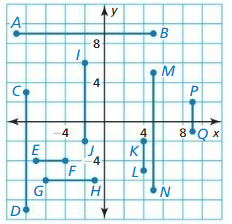
Answer:
There are no congruent line segments in the coordinate plane,
Explanation:
We know that the “Congruency” means having the same size and the same length,
But, from the above coordinate plane, we can observe that there are no congruent lines
Hence from the above we can conclude that there are no congruent line segments in the coordinate plane.
Question 2.
Order the terms so that each consecutive term builds off the previous term.
plane segment line point ray
Answer:
Point, Line, Ray, Segment, and Plane,
Explanation:
The given terms are a. Plane b. Segment c. Line d. Point e. Ray,
Hence the order of the given terms are Point, Line, Ray, Segment, and Plane.
Question 3.
The endpoints of a line segment are (- 6, 13) and (11, 5). Which choice shows the correct midpoint and distance between these two points?
(A) \(\left(\frac{5}{2}, 4\right)\); 18.8 units
(B) \(\left(\frac{5}{2}, 9\right)\); 18.8 units
(C) \(\left(\frac{5}{2}, 4\right)\); 9.4 units
(D) \(\left(\frac{5}{2}, 9\right)\); 9.4 units
Answer:
(B) shows the correct midpoint and distance,
Explanation:
The given endpoints of a line segment are: (-6, 13) and (11, 5), We know that the coordinates of the midpoint = (\(\frac{x1 + x2}{2}\), \(\frac{y1 + y2}{2}\)),
= (\(\frac{11 – 6}{2}\), \(\frac{13 + 5}{2}\)),
= (\(\frac{5}{2}\), \(\frac{18}{2}\)),
= (\(\frac{5}{2}\), 9),
We know that the distance between the coordinates = \(\sqrt{(x2 – x1)² + (y2 – y1)²}\) = \(\sqrt{(11 + 6)² + (13 – 5)²}\) = 18.78 ≈ 18.8,
Hence from the above we can conclude that option (B) shows the correct midpoint and distance.
Question 4.
Find the perimeter and area of the figure shown
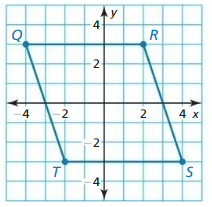
Answer:
The perimeter of the given polygon is 14, The area of the given polygon is 6,
Explanation:
From the coordinate plane, The points are Q (-4, 3), R (2, 3), S (3, 3), and T (-3, 3),
Now \(\overline{Q R}\) = \(\sqrt{(x2 – x1)² + (y2 – y1)²}\),
= \(\sqrt{(3 – 3)² + (4 + 2)²}\) = 6,
\(\overline{R S}\) = \(\sqrt{(x2 – x1)² + (y2 – y1)²}\),
= \(\sqrt{(3 – 2)² + (3 – 3)²}\) = 1,
\(\overline{S T}\) = \(\sqrt{(x2 – x1)² + (y2 – y1)²}\),
= \(\sqrt{(3 + 3)² + (3 – 3)²}\) = 6,
\(\overline{T Q}\) = \(\sqrt{(x2 – x1)² + (y2 – y1)²}\),
= \(\sqrt{(4 – 3)² + (3 – 3)²}\) = 1,
Hence, The perimeter of the given polygon = QR + RS + ST + TQ = 6 + 1 + 6 + 1 = 14,
The area of the given polygon = Length × Width.
So the area of the polygon = 6 (1) = 6.
Hence from the above we can conclude that the perimeter of the given polygon is 14,
The area of the given polygon is 6.
Question 5.
Plot the points W(- 1, 1), X(5, 1), Y(5, – 2), and Z(- 1, – 2) in a coordinate plane. What type of polygon do the points form? Your friend claims that you could use this figure to represent a basketball court with an area of 4050 square feet and a perimeter of 270 feet. Do you support your friend’s claim? Explain.
Answer:
Yes, The claim of my friend is correct,
Explanation:
The given points are: W (-1, 1), X (5, 1), Y (5, -2), and Z (-1, -2),
Now \(\overline{W X}\) = \(\sqrt{(x2 – x1)² + (y2 – y1)²}\) = \(\sqrt{(1 – 1)² + (5 + 1)²}\) = 6,
\(\overline{X Y}\) = \(\sqrt{(x2 – x1)² + (y2 – y1)²}\) = \(\sqrt{(1 + 2)² + (5 – 5)²}\) = 3,
\(\overline{Y Z}\) = \(\sqrt{(x2 – x1)² + (y2 – y1)²}\) = \(\sqrt{(5 + 1)² + (2 – 2)²}\) = 6,
\(\overline{Z W}\) = \(\sqrt{(x2 – x1)² + (y2 – y1)²}\) = \(\sqrt{(1 – 1)² + (2 + 1)²}\) = 3, Hence the perimeter of the given polygon = WX + XY + YZ + ZW
= 6 + 3 + 6 + 3 = 18. But It is given that the actual perimeter is 270 ft, So the scale = 270 / 18 = 15, Now the area of the given polygon = Length × Width,
So The area of the polygon = 6 (3) = 18, The area of the basketball = 15 (15) (18) = 4050 ft²,
Hence from the above we can conclude that the claim of your friend is correct.
Question 6.
Use the steps in the construction to explain how you know that \(\vec{A}\)G is the angle bisector of ∠CAB.

Answer:
Step 1:
Draw an angle ∠CAB. Measure the length of AC and draw an arc by using the compass by taking the length more than half of the length of AC
Step 2:
From the arc, by using a compass, draw 2 arcs by taking more than half of the length of the arc on both sides of the arc
Step 3:
Use a straightedge to measure the length from the arcs to angle A and that line is called “Angle Bisector”,
Explanation:
Used the steps in the construction to explain how I know that \(\vec{A}\)G is the angle bisector of ∠CAB above.
Question 7.
The picture shows an aerial view of a city. Use the streets highlighted in red to identify all congruent angles. Assume all streets are straight angles.
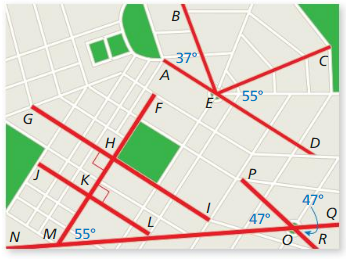
Answer:
The congruent angles are ∠E and ∠M; ∠O and ∠R,
Explanation:
We know that the “Congruent angles” are the angles that have the same angle measure,
Hence from the above figure the congruent angles are ∠E and ∠M; ∠O and ∠R.
Question 8.
Three roads come to an intersection point that the People in your town call Five Corners. as shown in the figure.

a. Identify all vertical angÌes.
Answer:
∠LJK, ∠MJP, ∠MJN,
Explanation:
From the given figure the vertical angles are ∠LJK, ∠MJP, ∠MJN.
b. Identify all linear pairs.
Answer:
∠LJK, ∠MJP, ∠MJN,
Explanation:
From the given figure the linear pairs are ∠LJK, ∠MJP, ∠MJN.
C. you are traveling east on Buffalo Road and decide to turn left onto Carter Hill.
Name the angle of the turn you made.
∠KJL ∠KJM ∠KJN ∠KJP ∠LJM
∠LJN ∠LJP ∠MJN ∠MJP ∠NJP
Answer:
∠KJL,
Explanation:
From the above figure the angle made by you when you are traveling east n BuffaloRoad and decide to turn left onto Carter hill is ∠KJL.
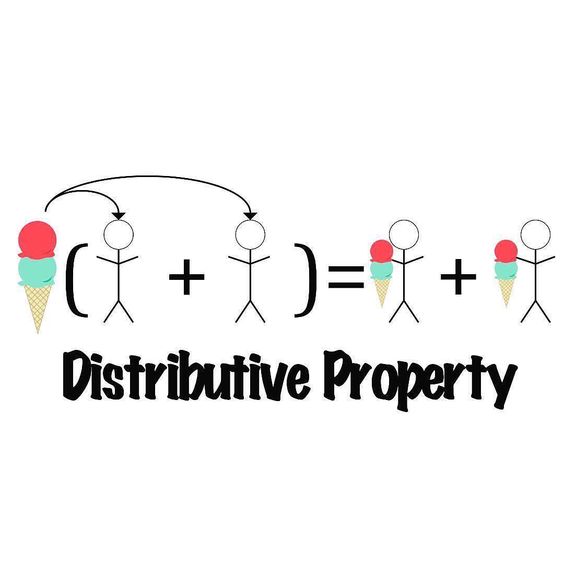

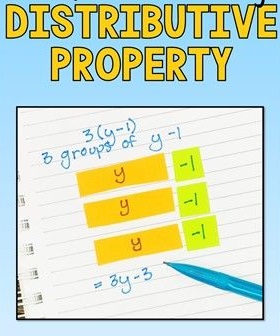
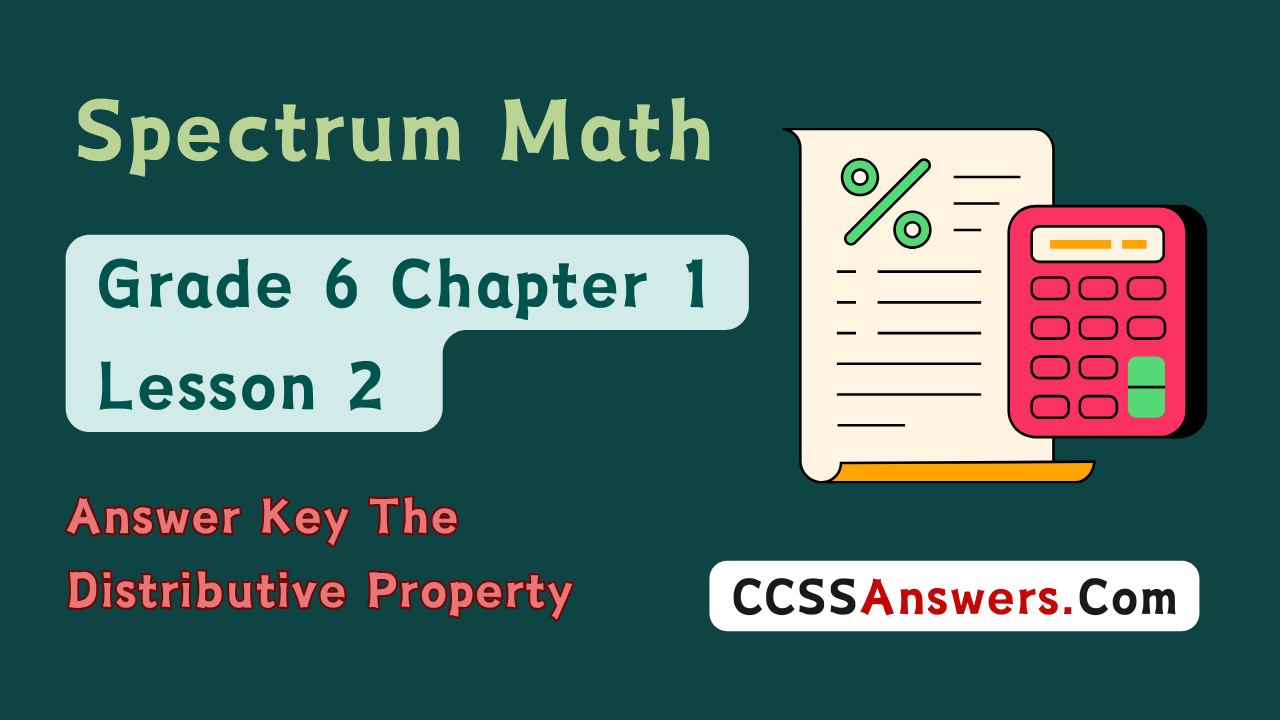














































































































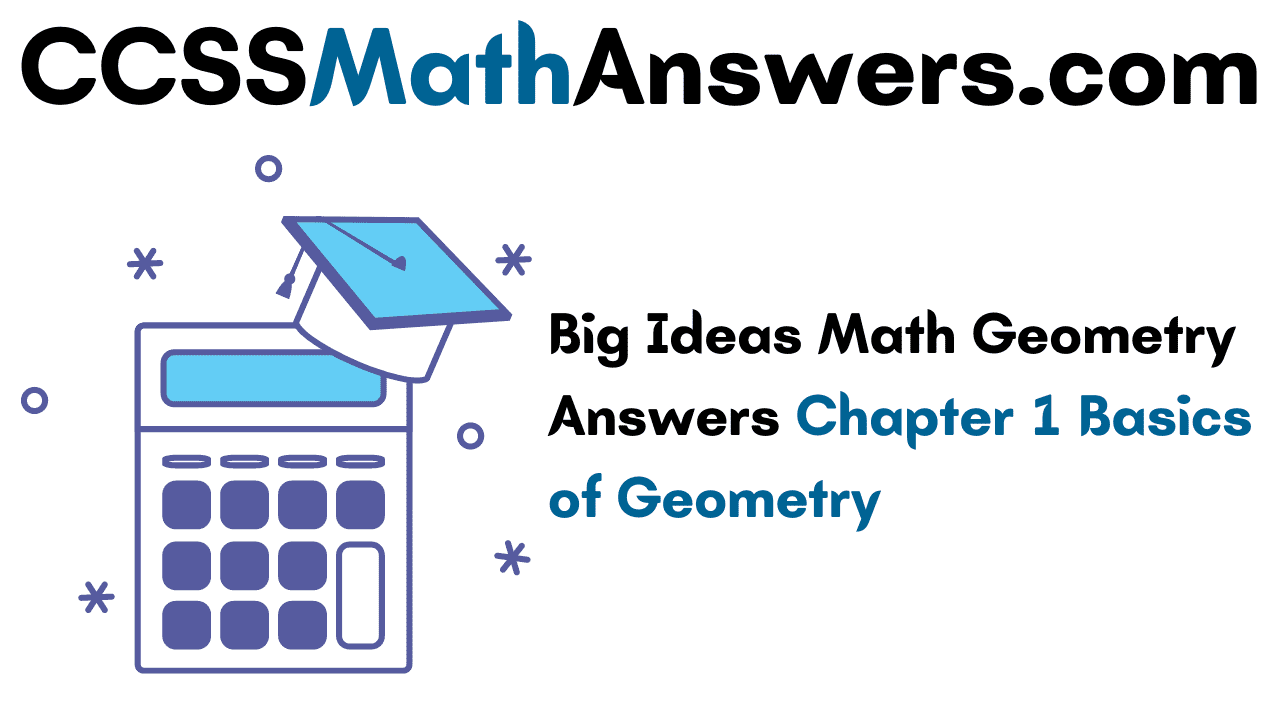



























 above.
above.






















































































































































































































































































































































